JKBOSE 10th Class Maths Solutions chapter – 6 Triangles
JKBOSE 10th Class Maths Solutions chapter – 6 Triangles
J&K 10th Class Maths Solutions chapter – 6 Triangles
Jammu & Kashmir State Board JKBOSE 10th Class Maths Solutions
INTRODUCTION
We are familiar with triangles and many of their properties from earlier classe.. In class IX, you have studied congruence of triangles in detail. Recall that two figures are said to be congruent, if they have the same shape and the same size. In this chapter, we shall study about those figures which have the same shape but not necessarily the same size. Two figures having the same shape (and not necessarily the same size) are called similar figures. In particular, we shall discuss the similarity of triangles and apply this knowledge in giving a simple proof of Pythagoras Theorem learnt earlier.
TEXT BOOK EXERCISE 6.1
Q. 1. Fill in the blanks using the correct word given in brackets :
(i) All circles are similar). …… (congruent,
(ii) All squares are congruent). ……. (similar,
(iii) All ……. triangles are similar. (isosceles, equilateral).
(iv) Two polygons of the same number of sides are similar, if
(a) their corresponding angles are …… and (b) their corresponding sides are ……….. (equal, proportional).
Solution. (i) All circles are similar.
(ii) All squares are similar.
(iii) All equilateral triangles are similar.
(iv) Two polygons of the same number of sides are similar, if
(a) their corresponding angles are equal and (b) their corresponding sides are proportional.
Q. 2. Give two different examples of pair of:
(i) similar figures
(ii) non-similar figures.
Solution. (i) 1. Pair of equilateral triangles are similar figures.
2. Pair of squares are similar figos
(ii) 1. A triangle and quadrilateral tou of non-similar figures.
2. A square and rhombus form pair of nonsimilar figures.
Q. 3. State whether the following quadrilaterals are similar or not :-
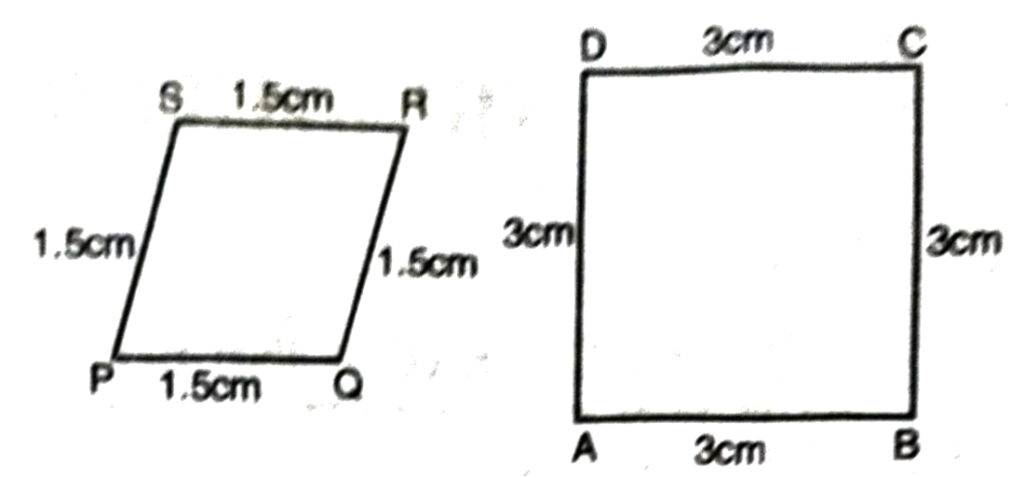
Solution. The two quadrilaterals in the figure are not similar because their corresponding angles are not equal.
TEXT BOOK EXERCISE 6.2
Q. 1. In fig. (i) and (ii), DE || BC. Find EC in (i) and AD i (ii).
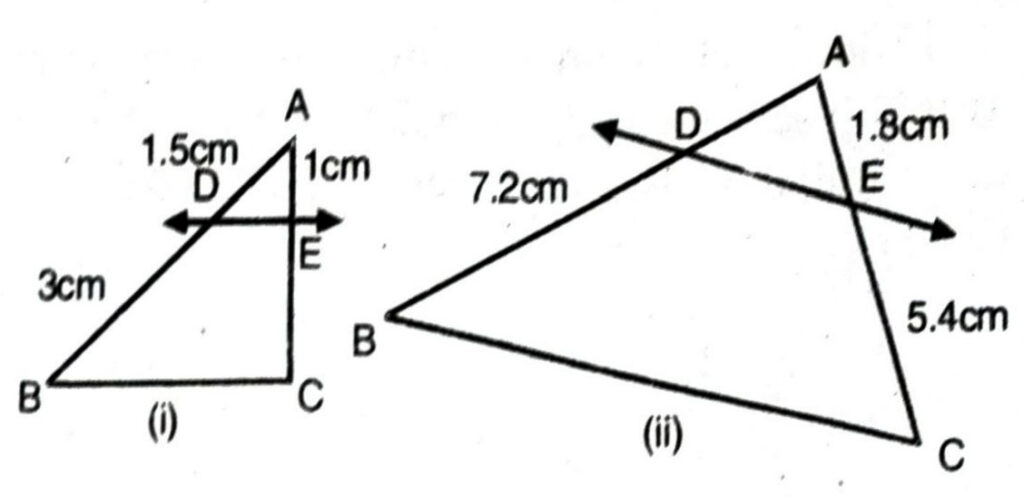
Solution. (i) In ΔABC, DE || BC (given)
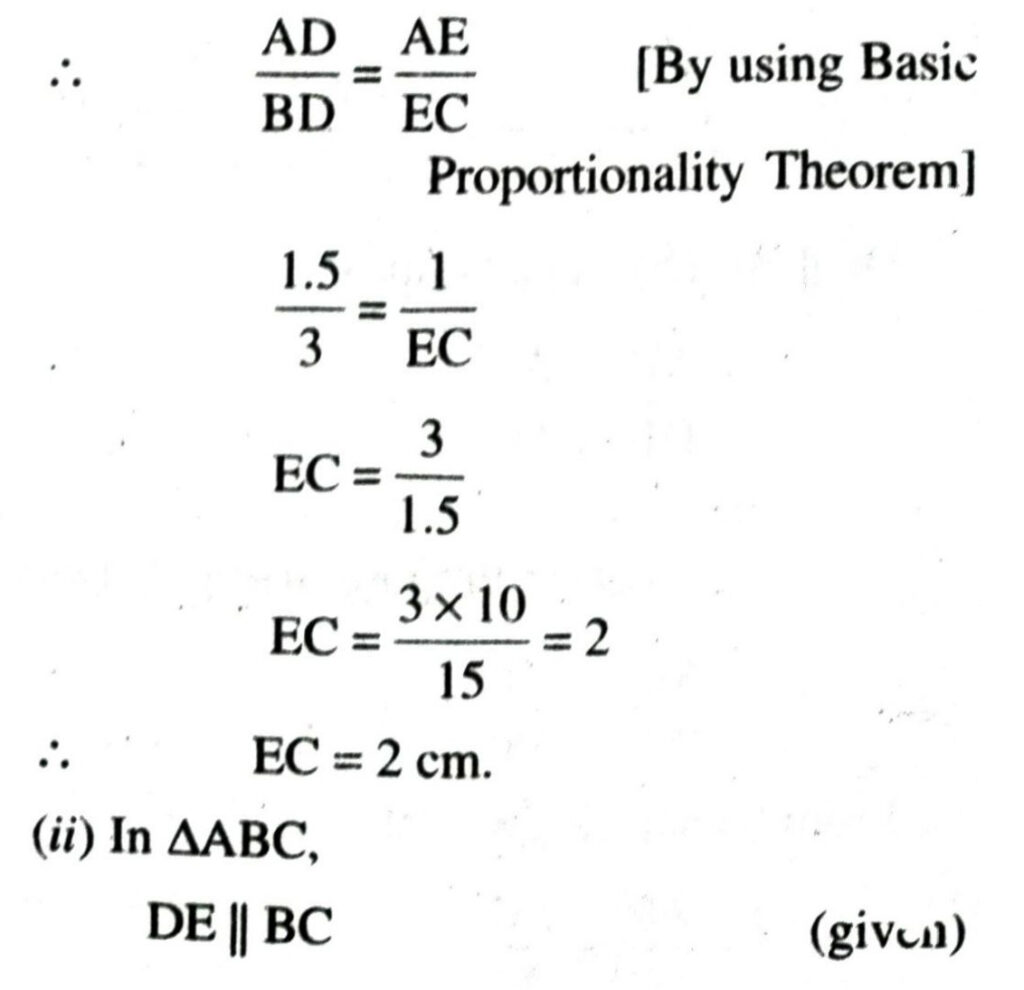
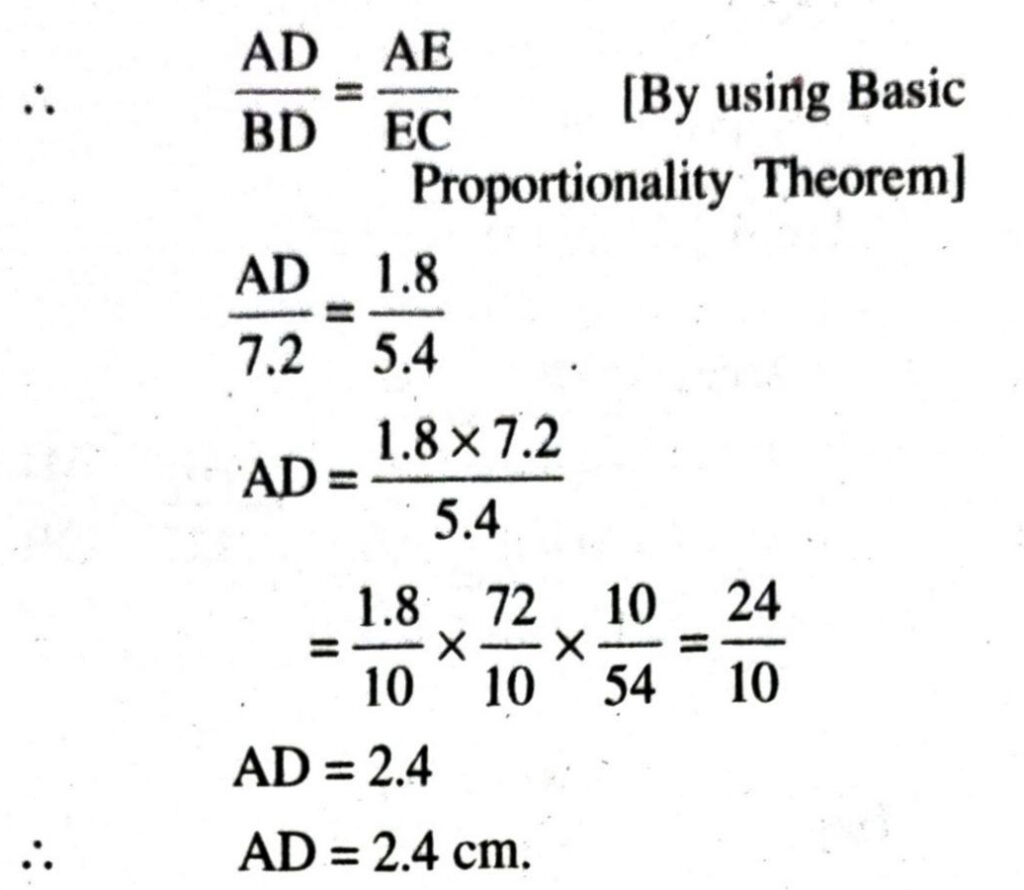
Q. 2. E and F are points on the sides PQ and PR respectively of a ΔPQR. For each of the following cases, state whether EF || QR :
(i) PE = 3.9 cm, EQ = 3 cm, PF = 3.6 cm and FR = 2.4 cm
(ii) PE = 4 cm, QE = 4.5 cm, PF = 8 cm and RF = 9 cm.
(iii) PQ = 1.28 cm, PR = 2.56 cm, PE = 0.18 cm and PF = 0.36 cm.
Solution. In ΔPQR, E and F are two points on side PQ and PR respectively.
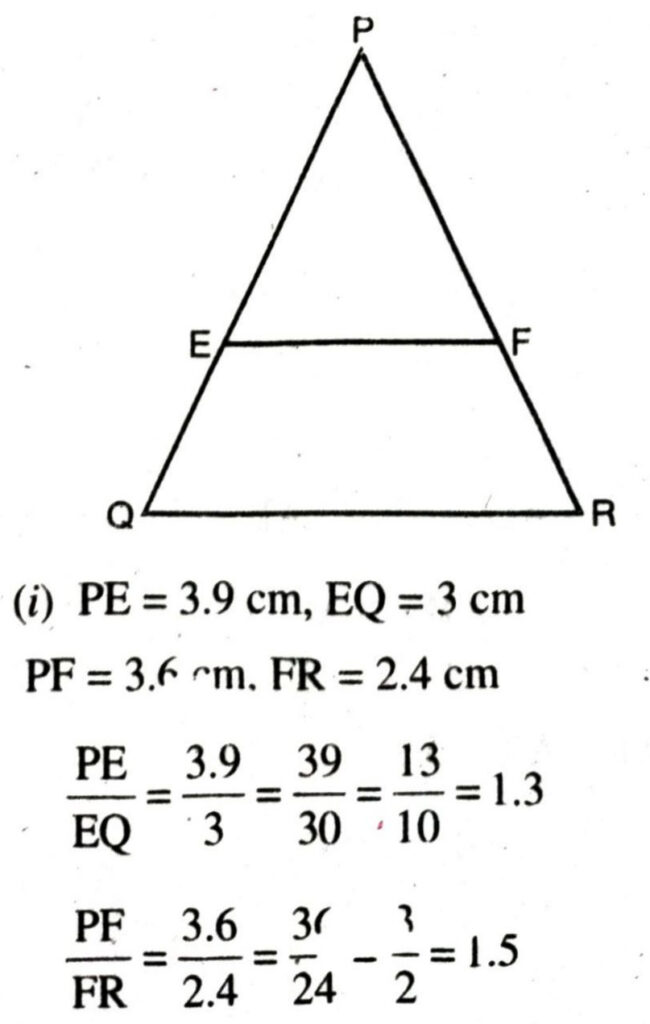
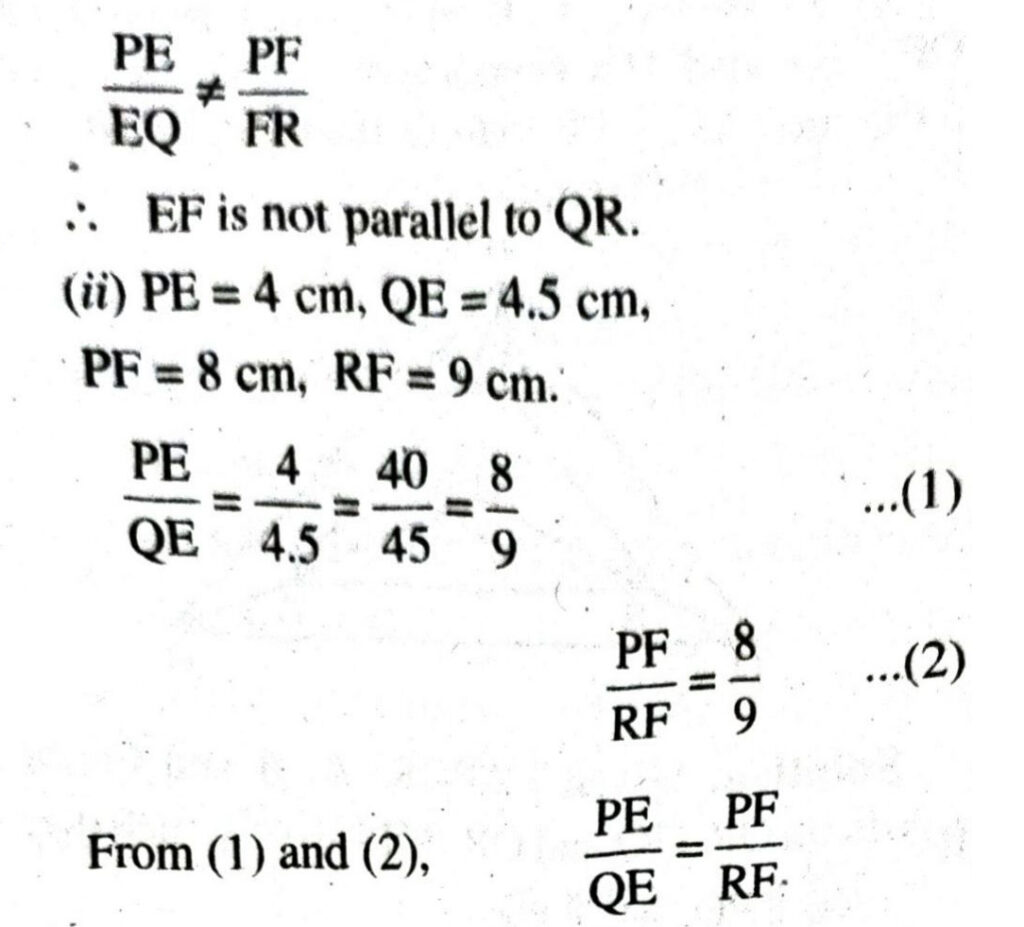
∴ By converse of Basic Proportionality theorem EF || QR.
(iii) PQ = 1.28 cm, PR = 2.56 cm PE=0.18 cm, PF = 0.36 cm.
EQ = PQ – PE = 1.28 – 0.18 = 1.10 cm
ER = PR – PF = 2.56 – 0.36 = 2.20 cm
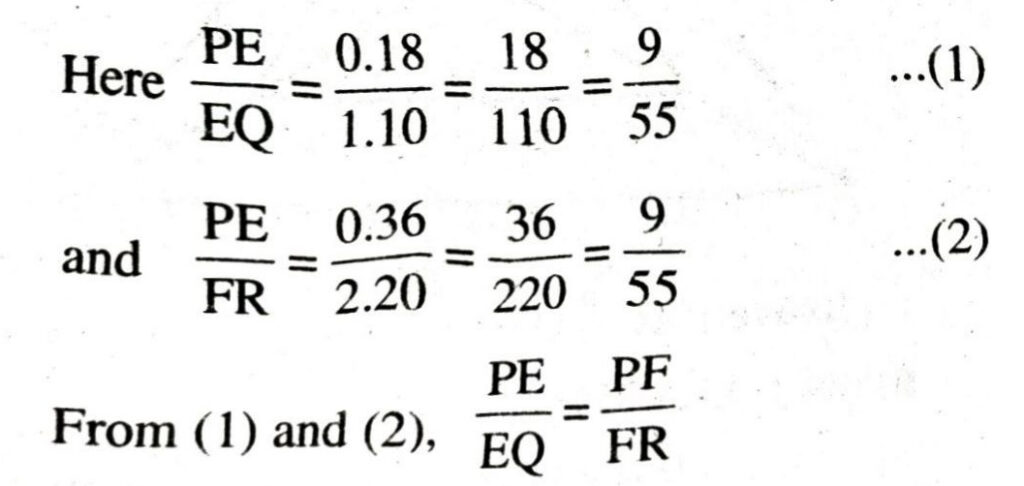
∴ By converse of Basic Proportionality Theorem EF || QR.
Q. 3. In fig., LM || CB; and LN || CD. Prove that 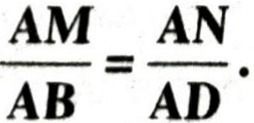
Solution.
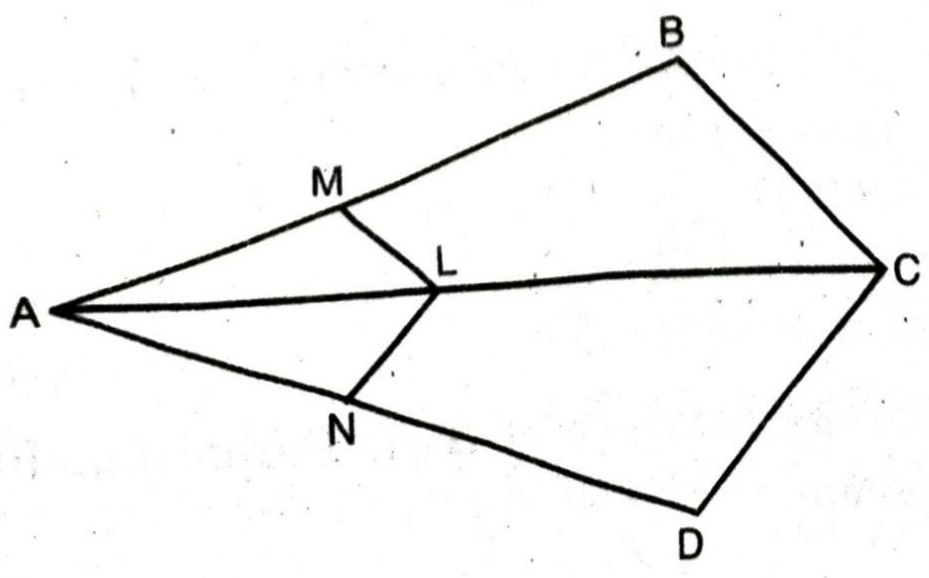
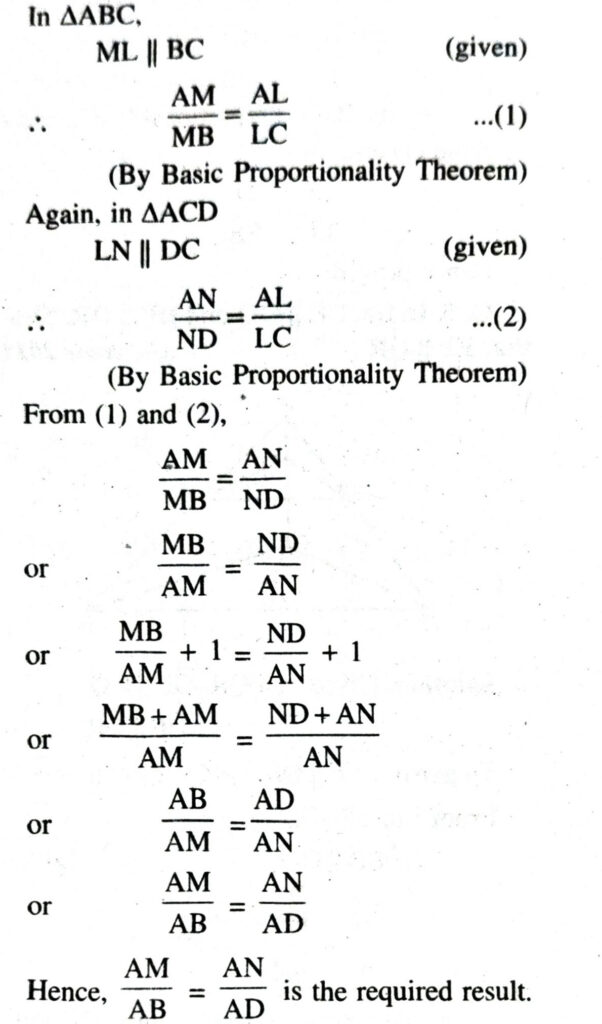
Q. 4. In fig. DE || AC, and DF || AE prove that 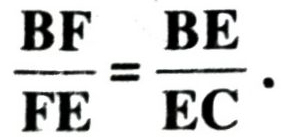
Solution. In ΔABC, DE || AC (given)
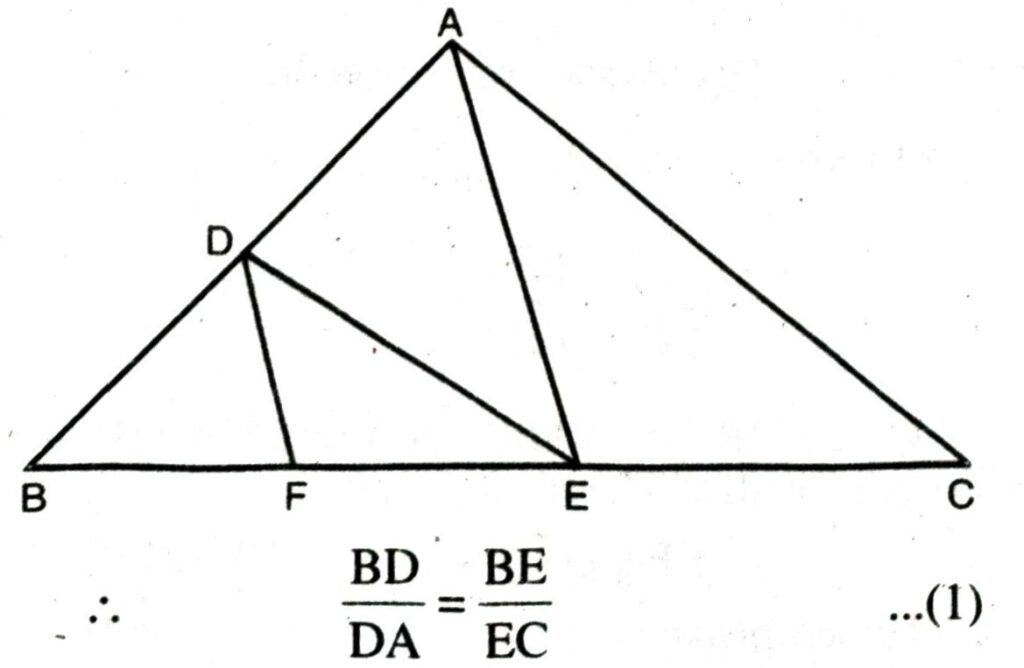
[By Basic Proportionality Theorem]
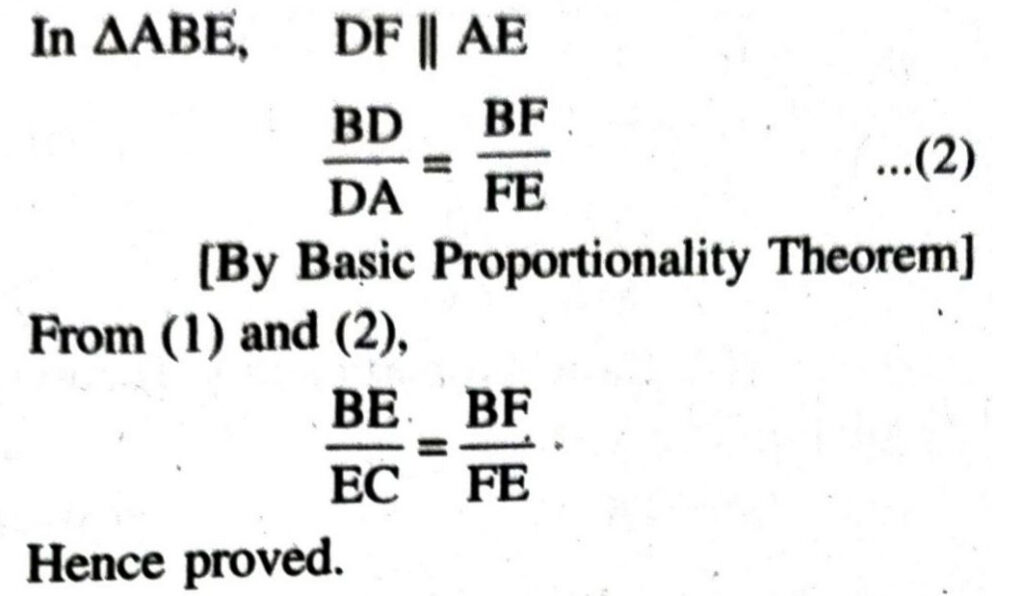
Q. 5. In fig. DE || OQ and DF || OR. Show that EF || QR.
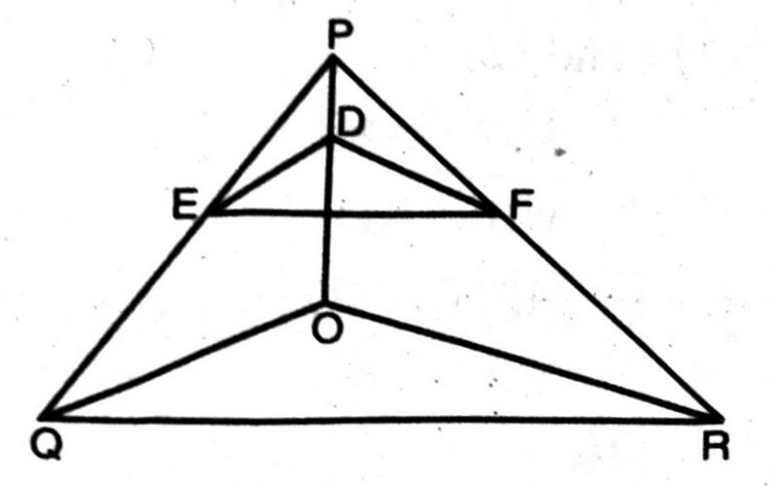
Solution. Given : ΔPQR, DE || OQ
DF || OR.
To prove: EF || QR.
Proof: In ΔPQO,
ED || QO (given)
[By Basic Proportionality Theorem]
Again in ΔPOR,
DF || OR (given)
From (1) and (2), [By Basic Proportionality Theorem]
In ΔPQR, by using converse of Basic Proportionality Theorem.
EF || QR,
Hence proved.
Q. 6. In fig., A, B and C are points on OP, OQ and OR respectively such that AB || PQ and AC || PR. Show that BC || QR.
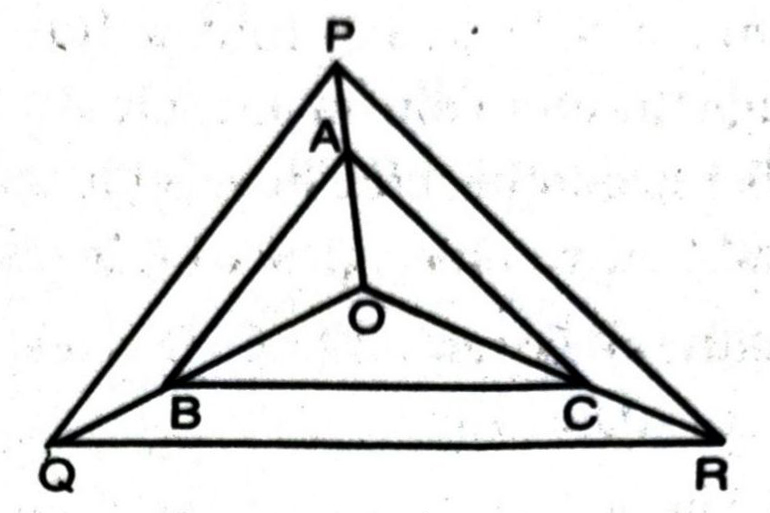
Solution. Given : ΔPQR, A, B and C are points on OP, OQ and OR respectively such that AB || PQ, AC || PR
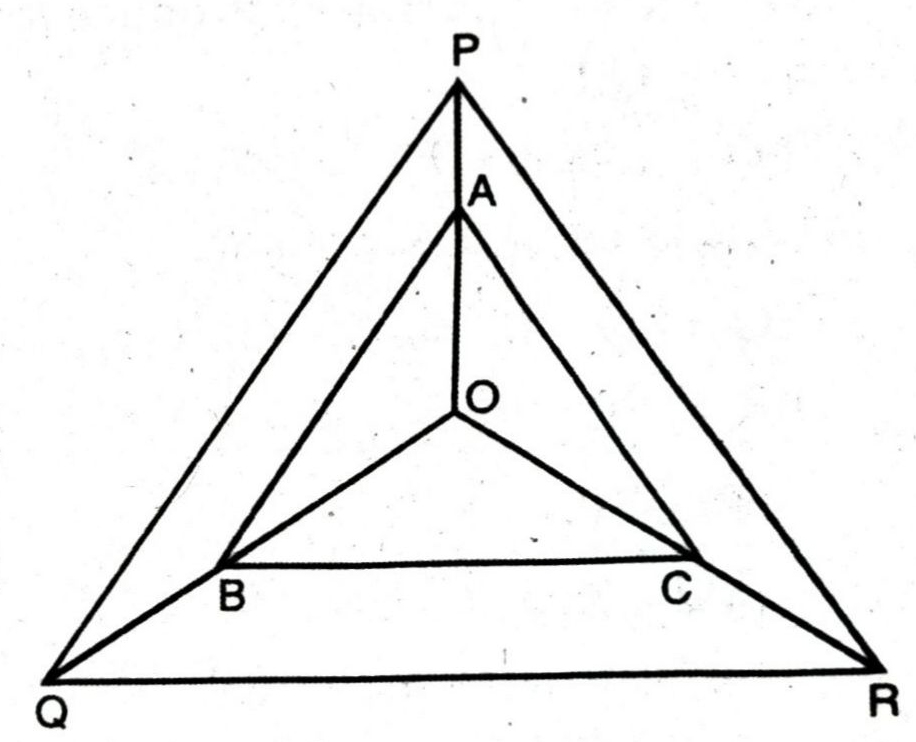
To prove: BC | QR.
Proof: In ΔOPQ,

[By using Basic Proportionality Theorem] Again in ΔOPR,

[By using Basic Proportionality Theorem] From (1) and (2),
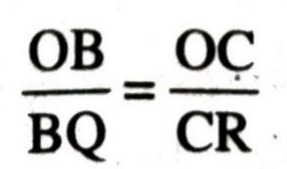
∴ By converse of Basic Proportionality Theorem.
In ΔOQR, BC || QR.
Hence proved.
Q. 7. Using Basic Proportionality theorem (Theorem 6.1) prove that a line drawn through the mid-point of one side of a triangle parallel to another side bisects the third side. (Recall that you have proved it in class IX).
Solution. Given: ΔABC, D is mid point of AB, i.e., AD = DB.
A line parallel to BC intersects AC at E as shown in figure, i.e., DE || BC.
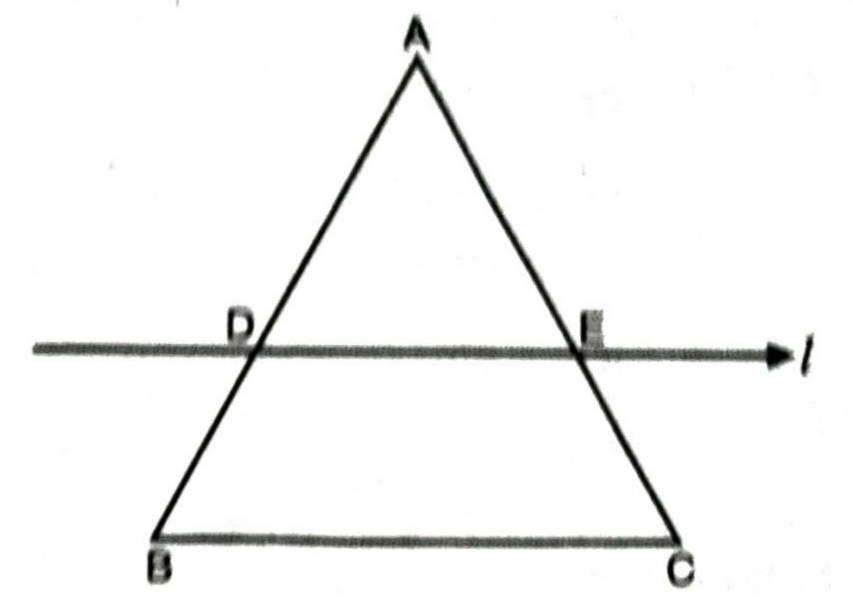
To prove: E is mid point of AC.
Proof: D is mid point of AB.
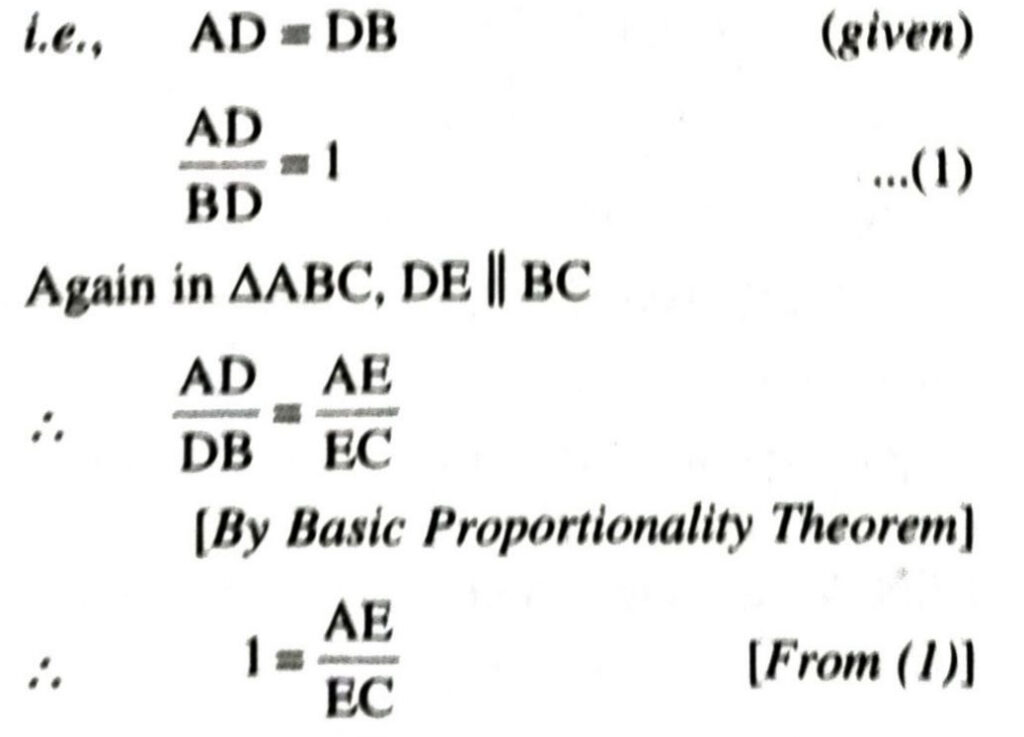
∴ AE = AE
∴ E is mid point of AC
Hence proved.
Q.8. Using converse of Basic Proportionality theorem (Theorem 6.2) prove that the line joining the mid-points of any two sides of a triangle is parallel to the third side. (Recall that you have done it in Class IX).
Solution. Given. AABC, D and E are mid points of AB and AC respectively such that AD = BD and AE = EC, D and E are joined
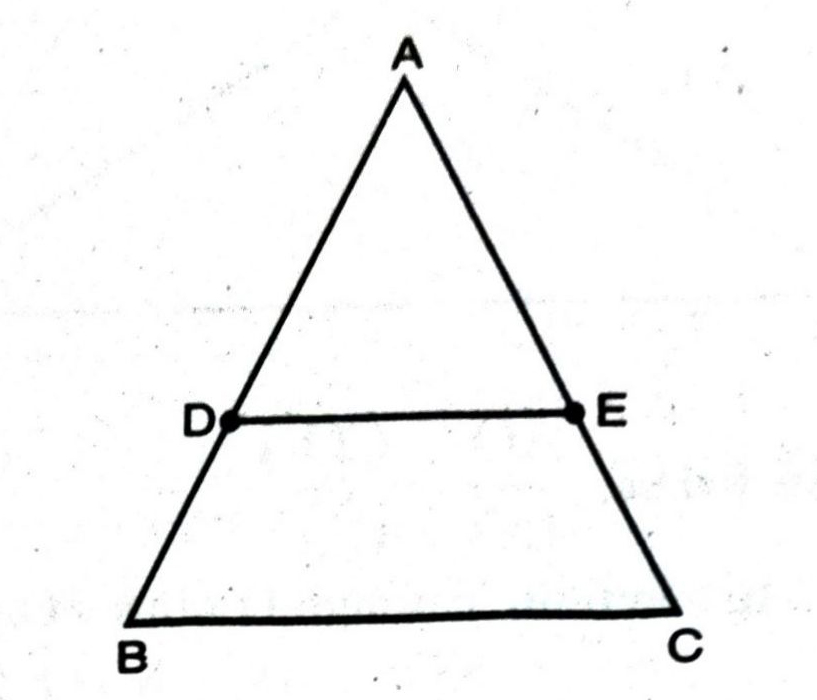
To Prove. DE || BC
Proof. D is mid point of AB (Given)
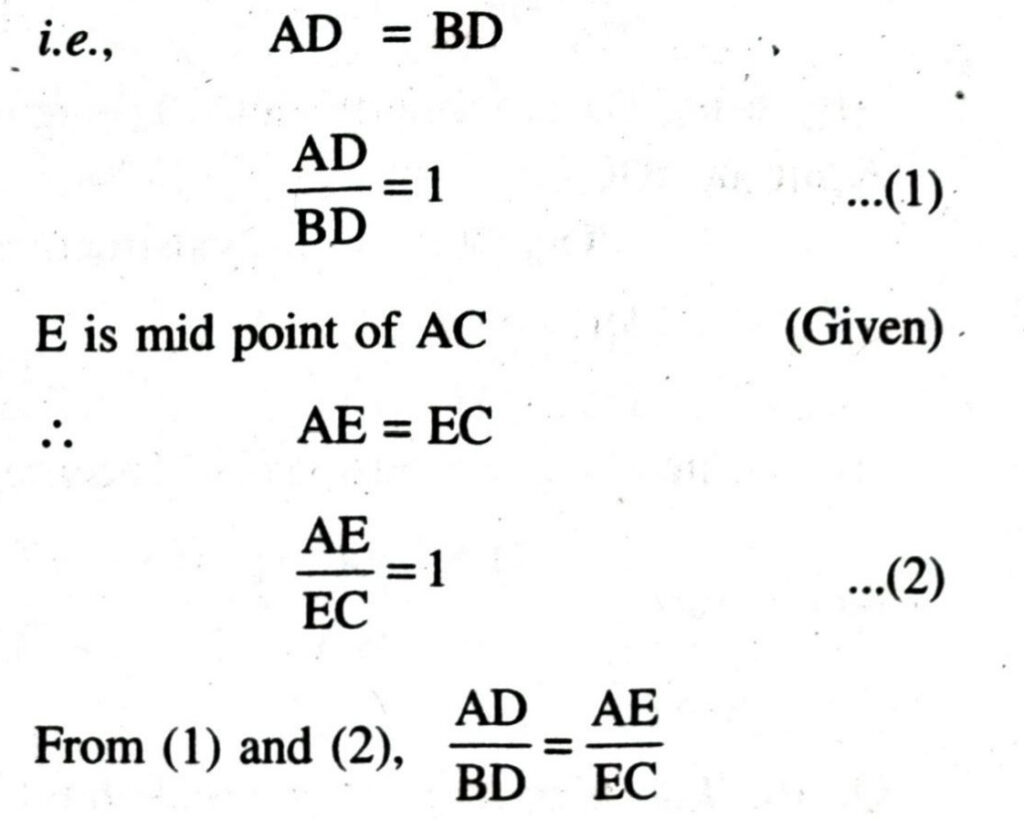
By using converse of basic proportionality Theorem
DE || BC
Hence Proved.
Q. 9. ABCD is a trapezium in which AB || DC and its diagonals intersect each other at the point O. Show that 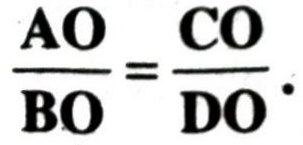
Solution.
Given. ABCD is trapezium AB || DC, diagonals AC and BD intersect each other at O.
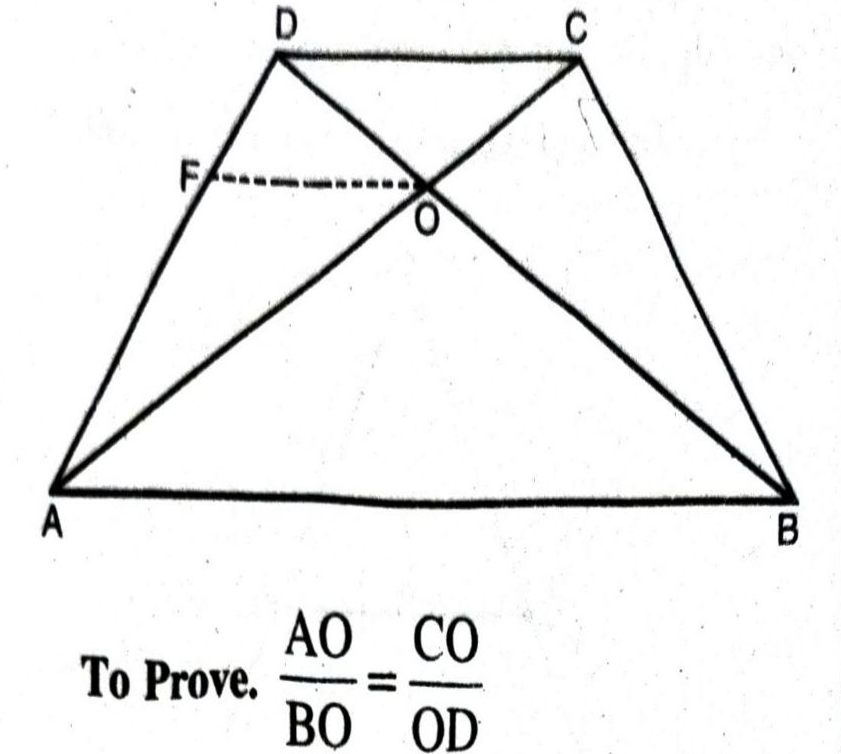
Construction. Through O draw FO || DC || AB
Proof. In ΔDAB,
FO || AB (construction)
[By using Basic Proportionality Theorem] Again in ΔDCA,

[By using Basic Proportionality Theorem]

Hence Proved.
Q. 10. The diagonals of a quadrilateral ABCD intersect each other at the point O such that 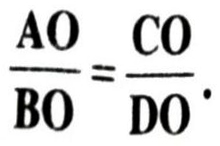 Show that ABCD is a trapezium.
Show that ABCD is a trapezium.
Solution. Given: Quadrilateral ABCD, diagonals AC and BD intersect each other at O such that 
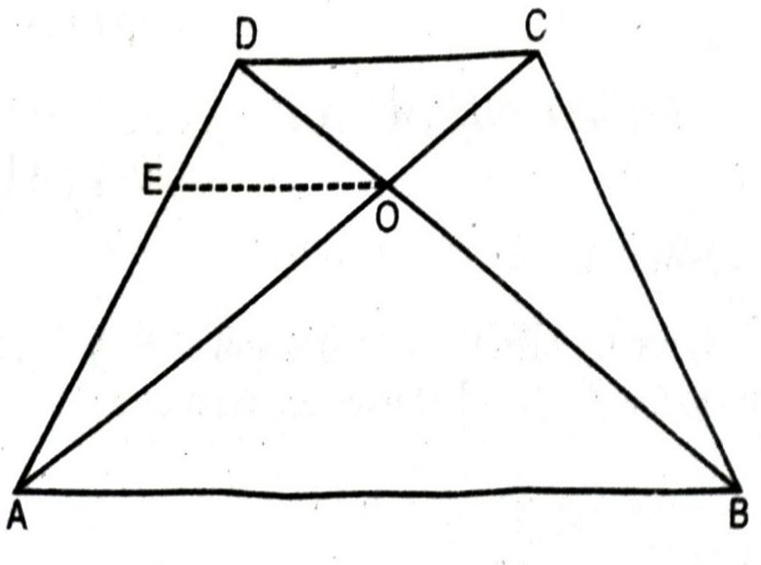
To Prove. Quadrilateral ABCD is trapezium.
Construction. Through ‘O’ draw line EO || AB which meets AD at. E.
Proof. In ΔDAB,
EO || AB
[By using Basic Proportionality Theorem]
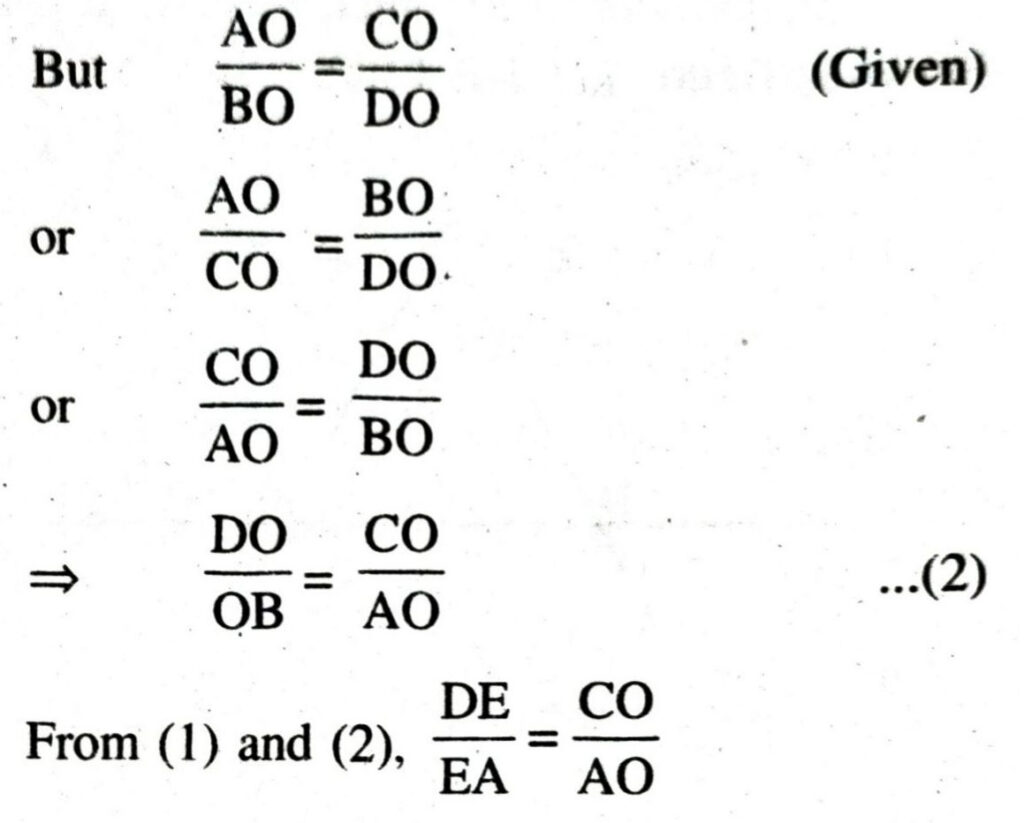
∴ By using converse of basic proportionality theorem,
EO || DC
also EO || AB
⇒ AB || DC
∴ Quadrilateral ABCD is a trapezium with AB || CD.
TEXT BOOK EXERCISE 6.3
Q. 1. State which pairs of triangles in Fig. are similar. Write the similarity criterion used by you for answering the question and also write the pairs of similar triangles in the symbolic form :
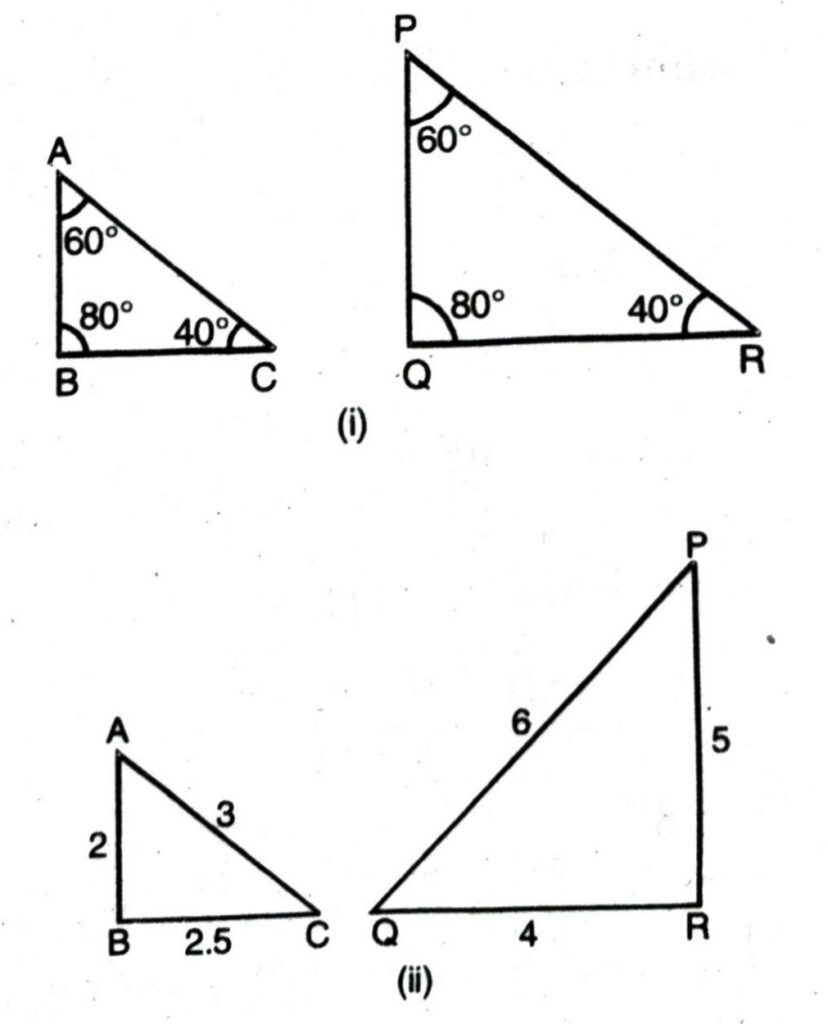
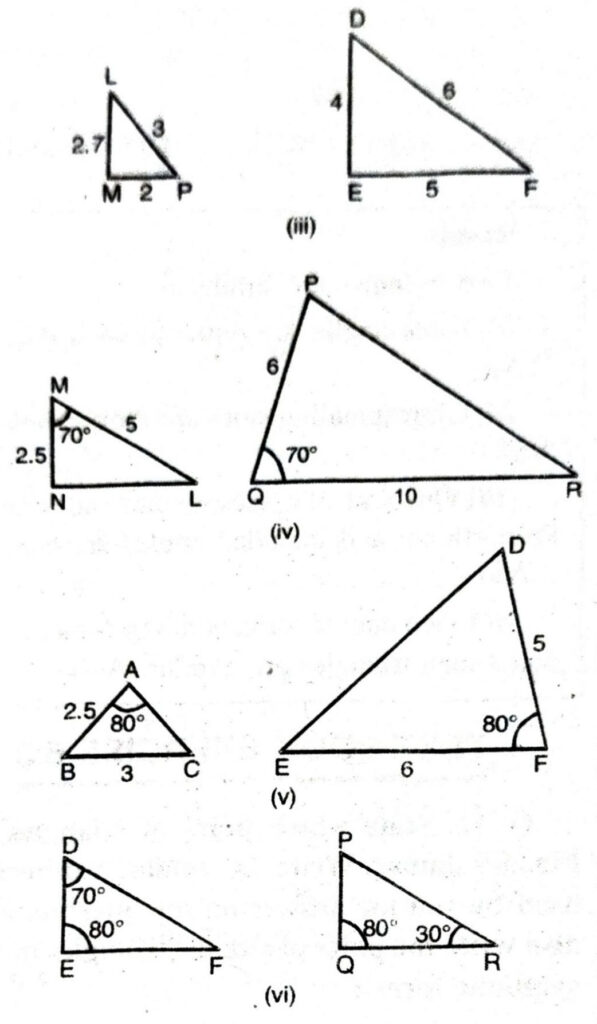
Solution. (i) In ΔABC and ΔPQR,
∠A = ∠P (each 60°)
∠B = ∠Q (each 80°)
∠C = ∠R (each 40°)
∴ ΔABC ∼ ΔPQR [AAA Similarity criterion)
(ii) In ΔABC and ΔPQR,
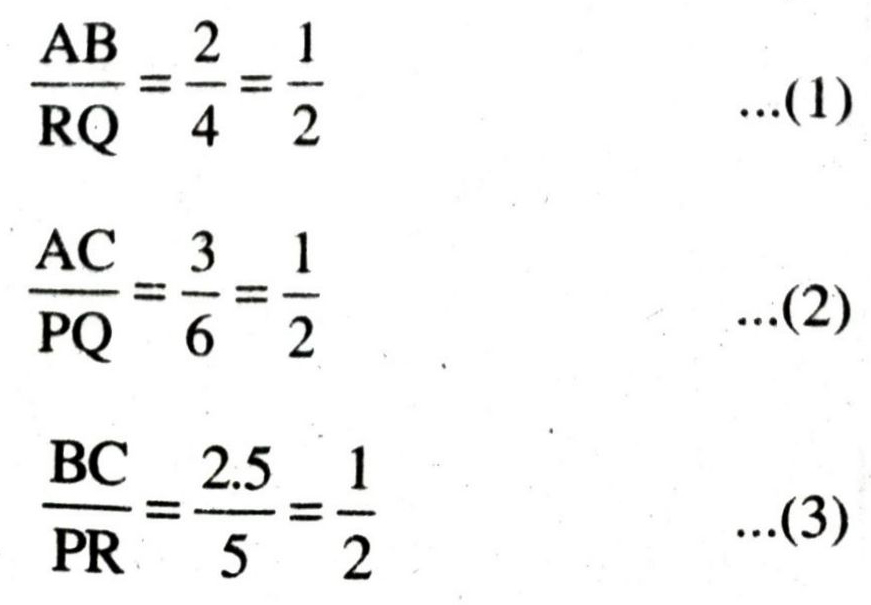
From (1), (2) and (3),

∴ ΔABC ∼ ΔQRP [By SSS Similarity criterion)
(iii) In ΔLMP and ΔDEF,
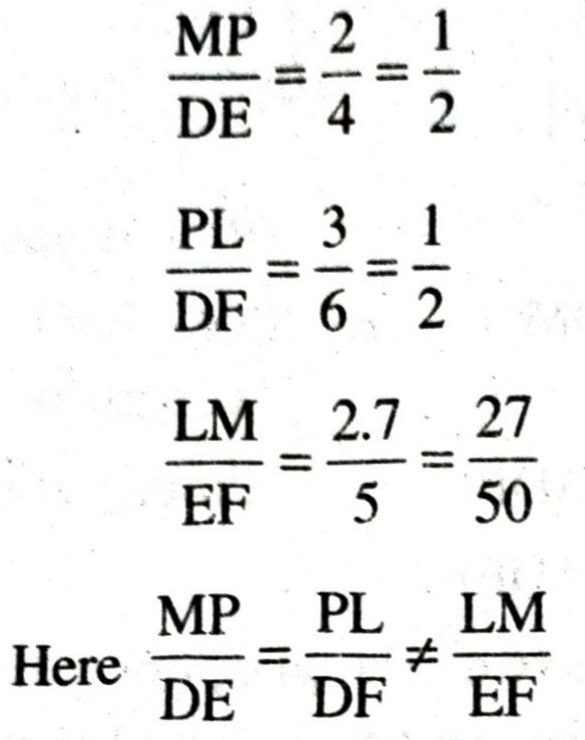
∴ Two Triangles are not similar.
(iv) In ΔMNL and ΔPQR,
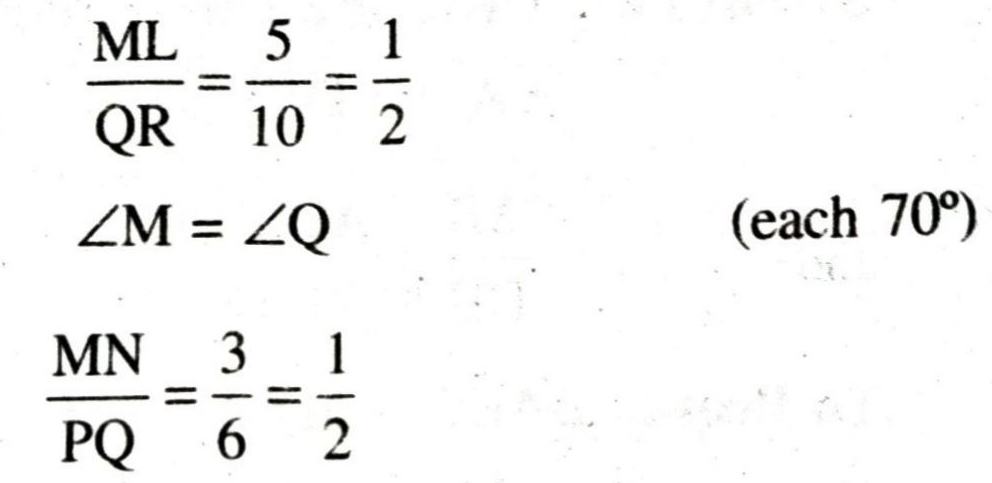
∴ ΔMNL ∼ ΔQPR [By SAS Similarity criterion)
(v) In ΔABC and ΔDEF,
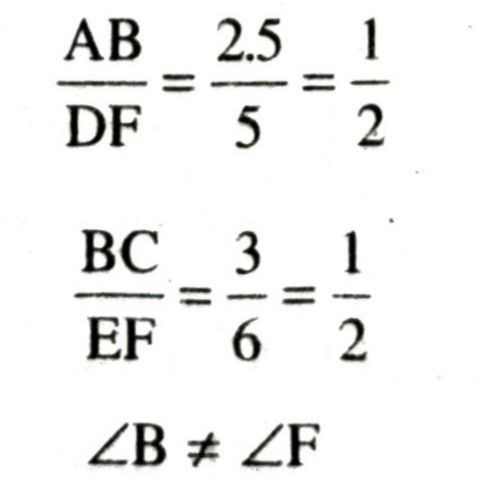
∴ ΔABC and ΔDEF are not similar.
(vi) In ΔDEF, ∠D = 70°, ∠E = 80°
∠D + ∠E + ∠F = 180°
70° + 80° + ∠F = 180°
∠F = 180° – 70° – 80°
∠F = 30°
In ΔPQR,
∠Q = 80°, ∠R = 30°
∠P + ∠Q + ∠R = 180° (Sum of angles of triangle)
∠P + 80° + 30° = 180°
∠P = 180° – 80° – 30°
∠P = 70°
In ΔDEF and ΔPQR,
∠D = ∠P (70° each)
∠E = ∠Q (80° each)
∠F = ∠R (30° each)
∴ ΔDEF ∼ ΔPQR (AAA similarity criterion).
Q. 2. In Fig., ΔODC~ ΔOBA, ∠BOC = 125° and ∠CDO = 70°. Find ∠DOC, ∠DCO and ∠OAB.
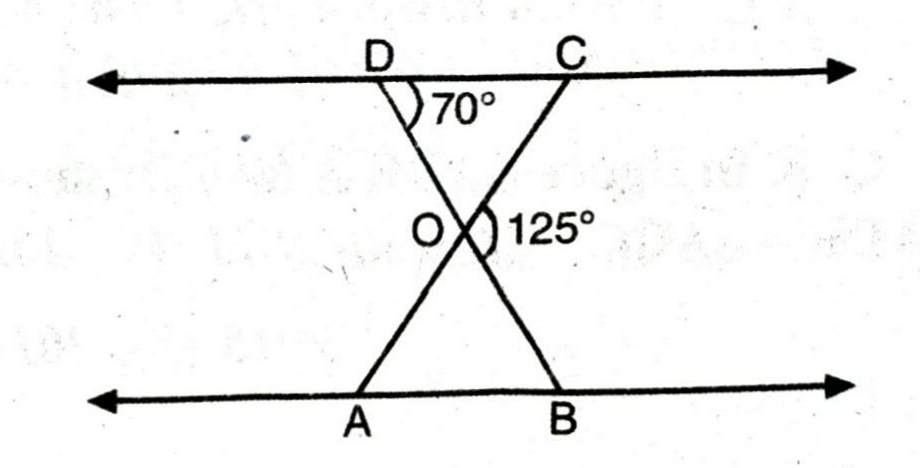
Solution.
Given that: ∠BOC = 125°
∠CDO = 70° and ΔODC ~ ΔOBA
To find: ∠DOC, ∠DCO and ∠OAB
Proof: DOB is a straight line
∴ ∠DOC + ∠COB = 180° [Linear pair Axiom]
∠DOC + 125° = 180°
∠DOC = 180° – 125°
∠DOC = 55°
∠DOC = ∠AOB = 55° [Vertically opposite angles]
But ΔODC ~ ΔΟΒΑ
∠D = ∠B = 70°
In ΔDOC, ∠D + ∠O + ∠C = 180°
70° + 55° + ∠C = 180°
∠C = 180° – 70° – 55°
∠C = 55°
∠C = ∠A = 55°
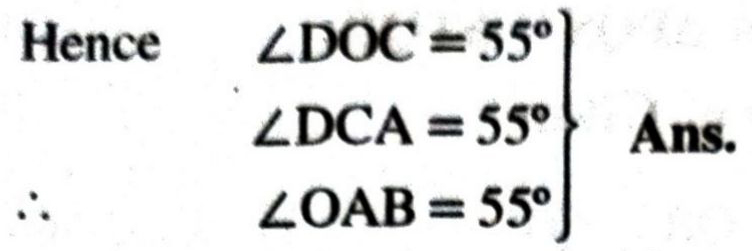
Q. 3. Diagonals AC and BD of a trapezium ABCD with AB || DC intersect each other at the point O. Using a similarity criterion for two triangles, show that 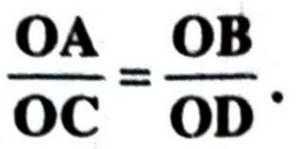
Solution.
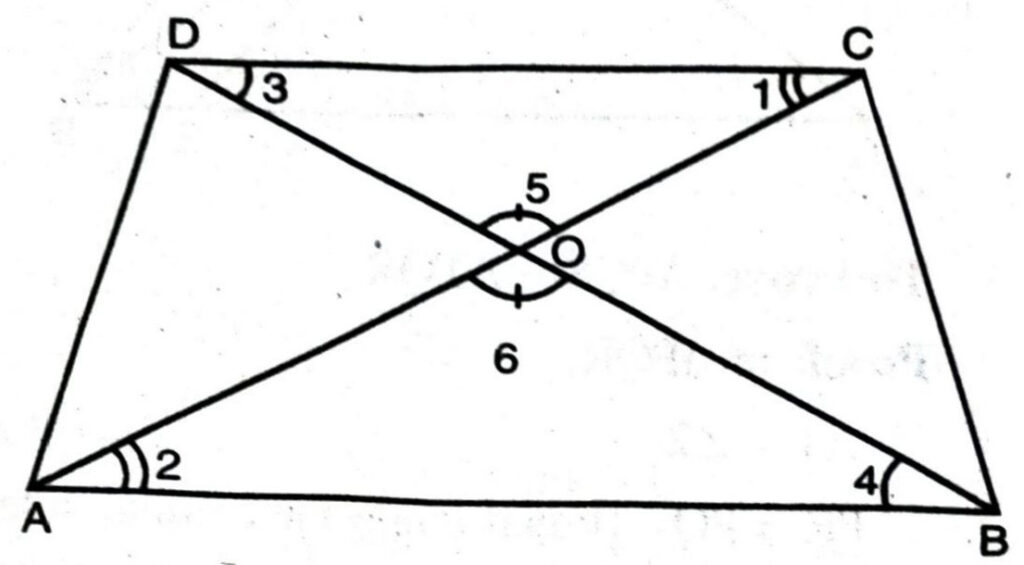
Given. Trapezium ABCD, AB || CD, and diagonal AC and BD intersects each other at O.

[If two triangle are similar corresponding sides are Proportional}

Hence Proved.
Q. 4. In Fig., 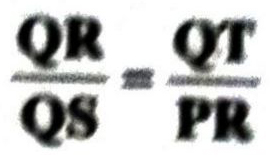 and ∠1 = ∠2 Show that ΔPQS ∼ ΔTQR.
and ∠1 = ∠2 Show that ΔPQS ∼ ΔTQR.
Solution. Given
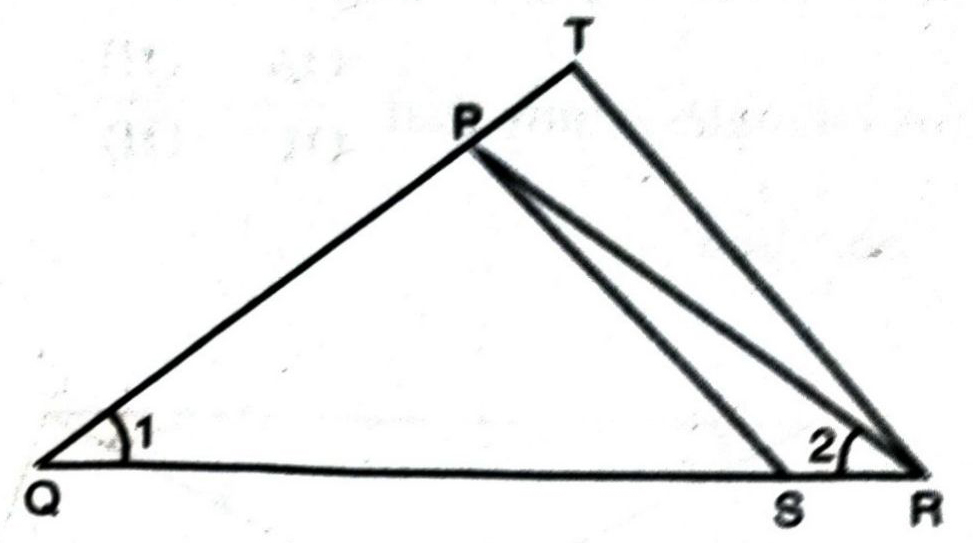
To Prove. ΔPQS ∼ ΔTQR
Proof. In ΔPQR,
∠1 = ∠2 (given)
∴ PR = PQ [Equal angle have equal side opposite to it]
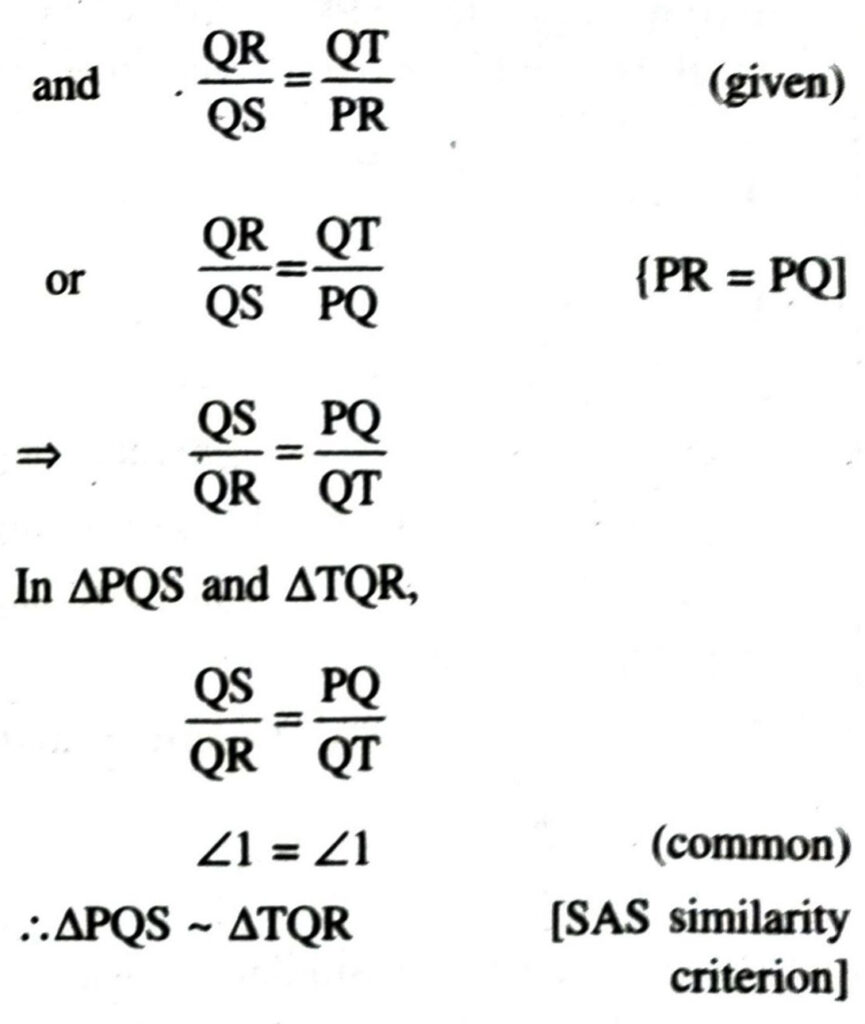
Hence proved.
Q. 5. S and T are points on sides PR and QR of ΔPQR such that ∠P = ∠RTS. Show that ΔRPQ ∼ ΔRTS.
Solution. ΔPQR, S and T are points on side PR and QR such that ∠P = ∠RTS
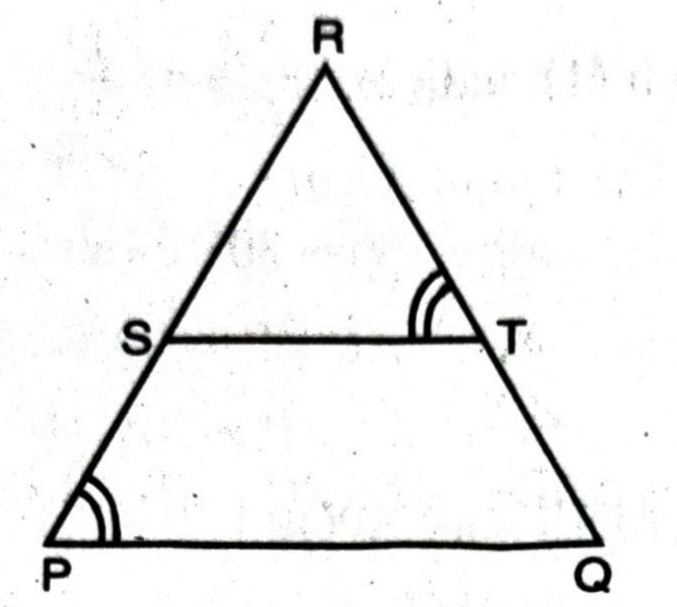
To Prove. ΔRPQ ~ ΔRTS
Proof: In ΔRPQ and ΔRTS
∠RPQ = ∠RTS (given)
∠R = ∠R [common angle]
∴ ΔRPQ ~ ΔRTS [By AA similarity critierion which is the required result.]
Q. 6. In figure ΔABE ≅ ΔACD, show that ΔADE ∼ ΔABC
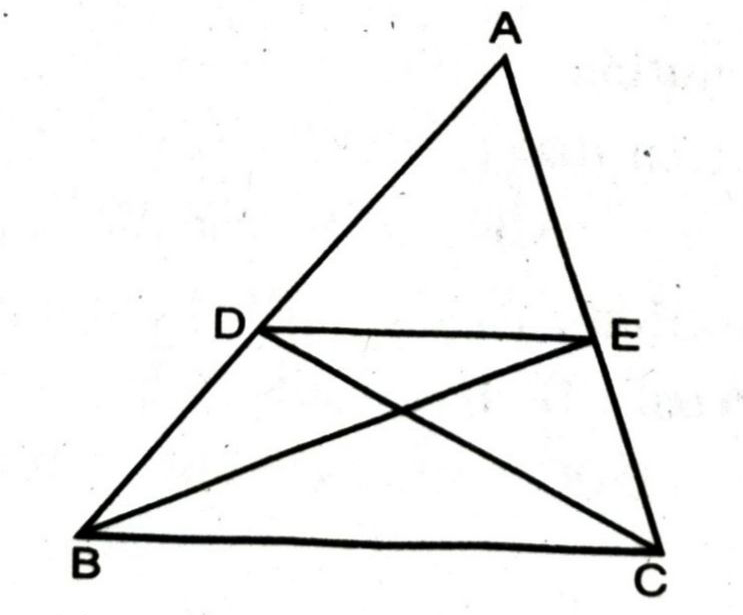
Solution.
Given. ΔABC in which ΔABE ≅ ΔACD
To Prove. ΔADE ∼ ΔABC
Proof. Since, ΔABE ≅ ΔACD (given)
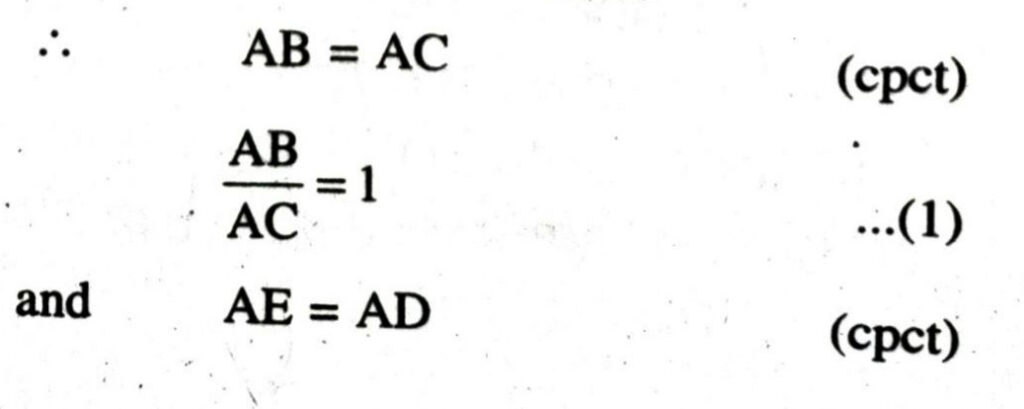
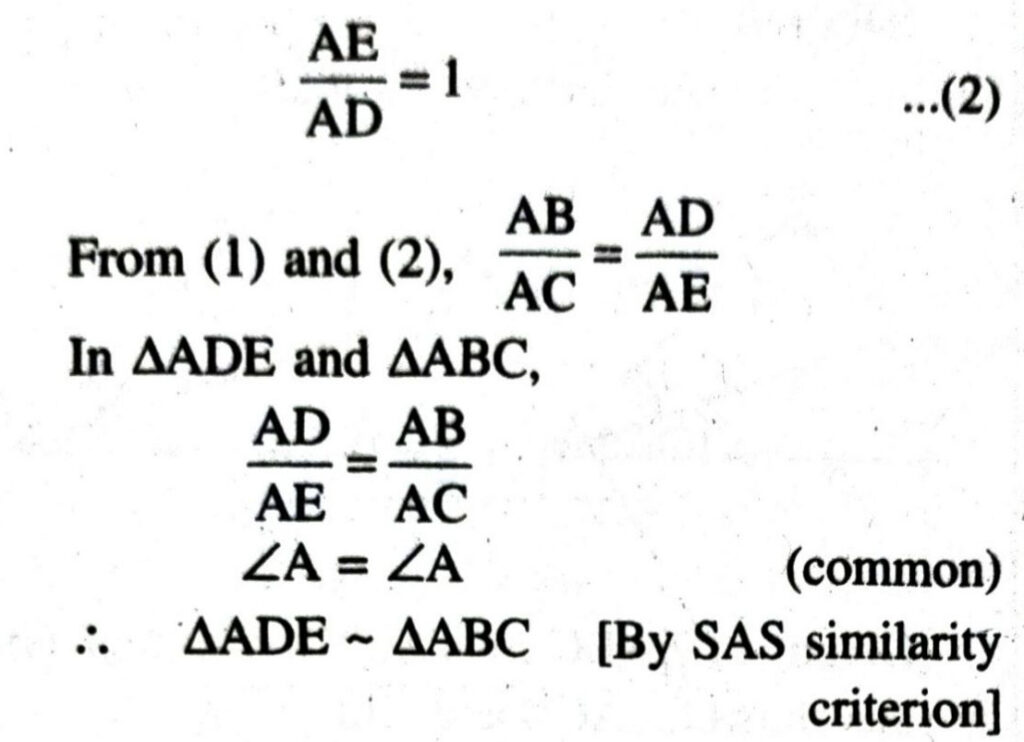
Q. 7. In Fig., altitudes AD and CE of ΔABC intersect each other at the point P. Show that :
(i) ΔΑΕΡ ~ ΔCDP
(ii) ΔABD ∼ ΔCBE
(iii) ΔΑΕΡ ~ ΔADB
(iv) ΔPDC ∼ ΔBEC
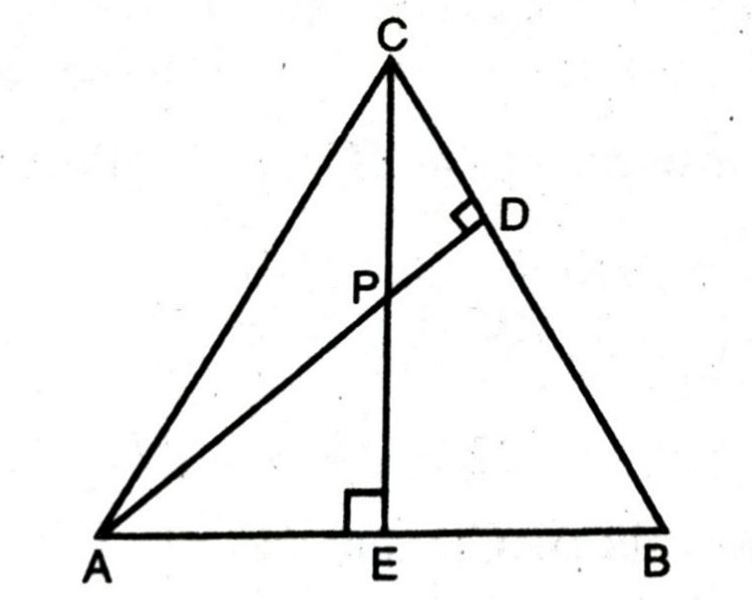
Solution. Given. ΔABC, AD ⊥ BC CE ⊥ LAB,
To Prove. (i) ΔAEP ∼ ΔCDP
(ii) ΔABD ∼ ΔCBE
(iii) ΔΑΕΡ ~ ΔADB
(iv) ΔPDC ∼ ΔBEC
Proof: (i) In ΔAEP and ΔCDP,
∠E = ∠D (each 90°)
∠APE = ∠CPD (vertically opposite angles)
∴ ΔΑΕΡ ~ ΔCDP [By AA similarity criterion]
(ii) In ΔABD and ΔCBE,
∠D = ∠E
(each 90°)
∠B = ∠B
(common)
∴ ΔABD ∼ ΔCBE [AA Similarity criterion]
(iii) In ΔAEP and ΔADB,
∠E = ∠D
(each 90°)
∠A = ∠A (common)
∴ ΔΑΕΡ ~ ΔΑDB [AA similarity criterion]
(iv) In ΔPDC and ΔBEC,
∠C = ∠C (common)
∠D = ∠E (each 90°)
∴ ΔPDC ∼ ΔBEC [AA similarity criterion]
Q. 8. E is a point on the side AD produced of a parallelogram ABCD and BE intersects CD at F. Show that ΔABE ∼ ΔCFB.
Solution. Given. Parallelogram ABCD. Side AD is produced to E, BE intersects DC at F
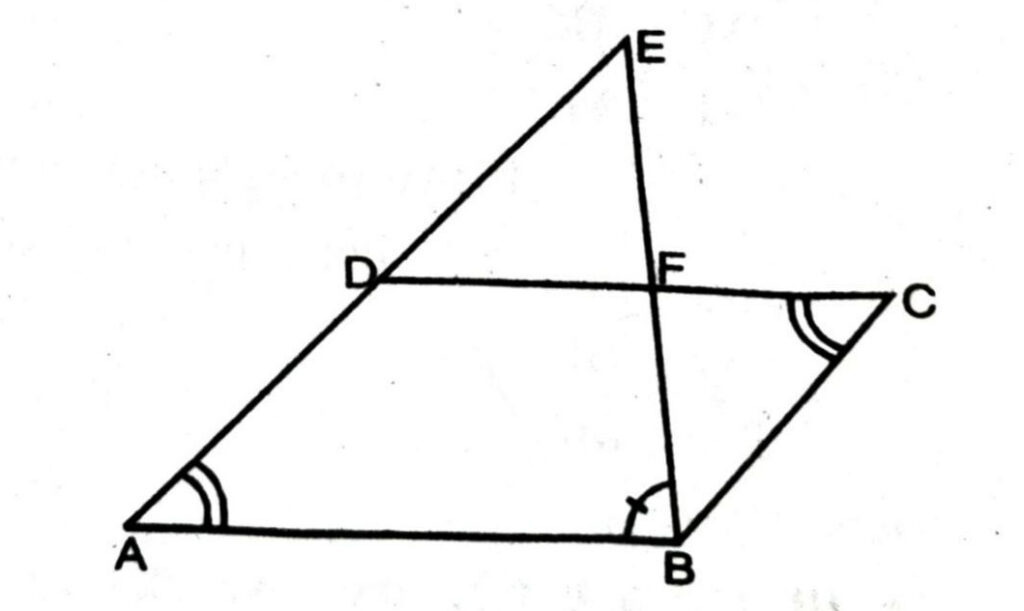
To Prove. ΔABE ∼ ΔCFB
Proof. In ΔABE and ΔCFB.
∠A = ∠C (opposite angle of || gm)
∠ABE = ∠CFB (alternate angle)
∴ ΔABE ∼ ΔCFB (AA similarity criterion)
Q. 9. In Fig., ABC and AMP are two right triangles, right angled at B and M respectively. Prove that :
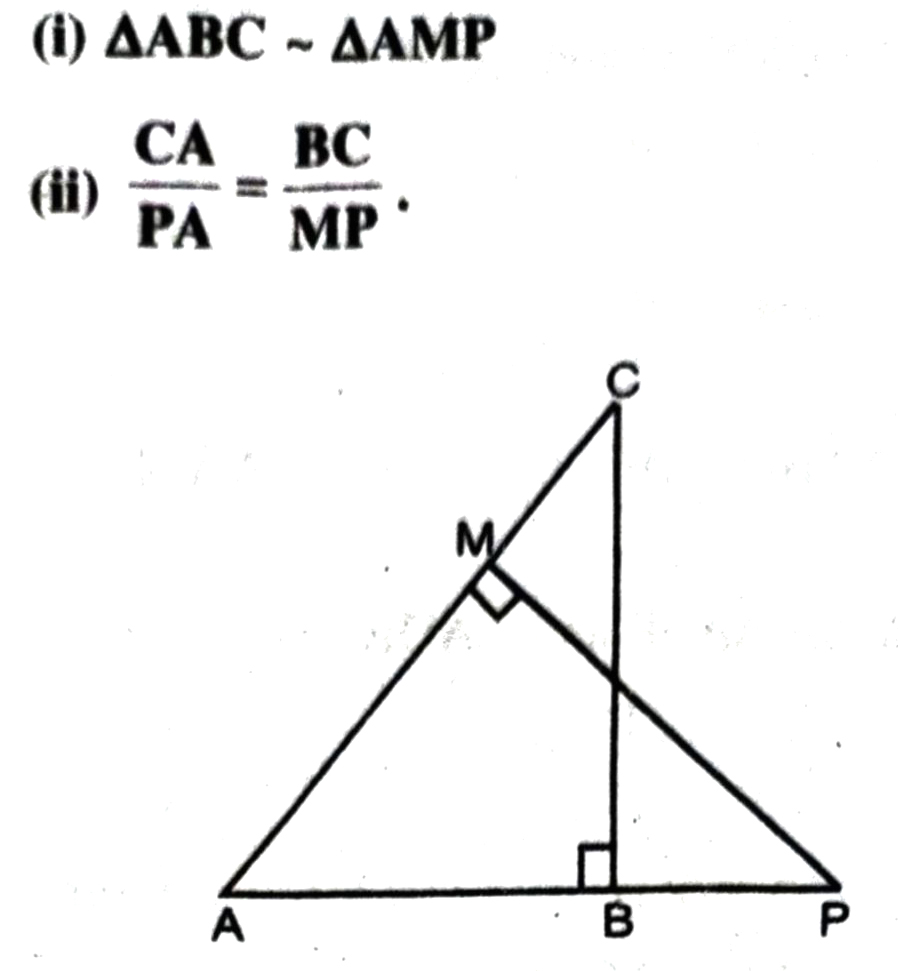
Solution.
Given. ΔABC and ΔAMP are two right triangles right angled at B and M
To Prove. (i) ΔABC ∼ ΔAMP
Proof. In ΔABC and ΔAMP,
∠A = ∠A (common)
∠B = ∠AM (each 90°)
(i) ∴ ΔΑΒC ∼ ΔAMP (AA similarity criterion)
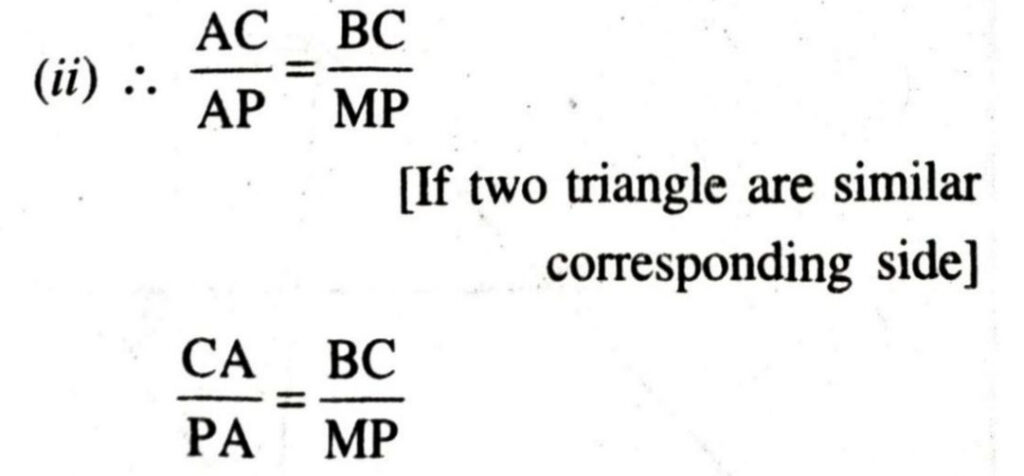
Hence Proved.
Q. 10. CD and GH are respectively the bisectors of ∠ACB and ∠EGF such that D and H lie on sides AB and FE of ΔABC and ΔEFG respectively. If ΔABC ∼ ΔFEG, show that:
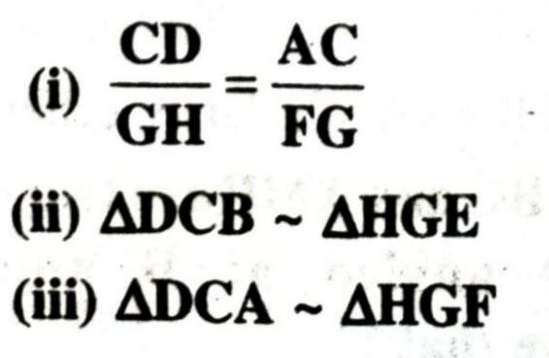
Solution.
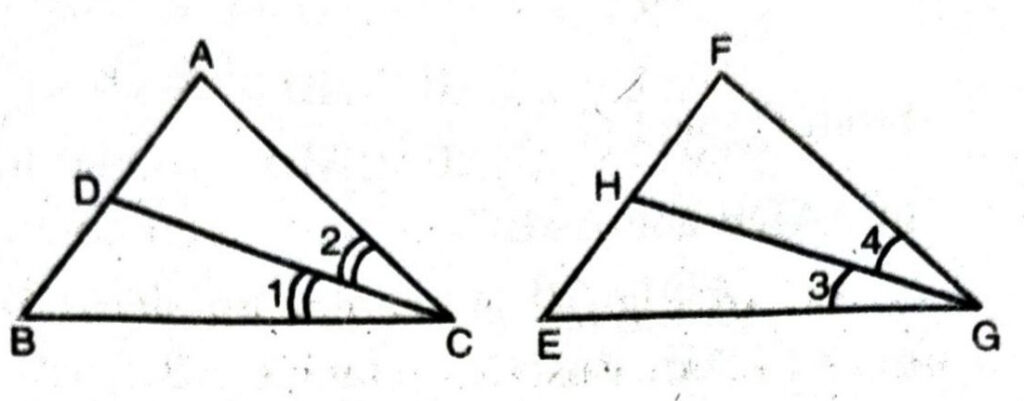
Given. In ΔABC and ΔEFG, CD and GH are bisectors of ∠ACB and ∠EGF i.e. ∠1 = ∠2 and ∠3 = ∠4
and ΔABC ∼ ΔFEG
To Prove. (i) CD/GH = AC/FG
(ii) ΔDCB ∼ ΔHGE
(iii) ΔDCA ~ ΔHGF
Proof.
(i) Given that, ΔABC ∼ ΔFEG
∴ ∠A = ∠F; ∠B = ∠E
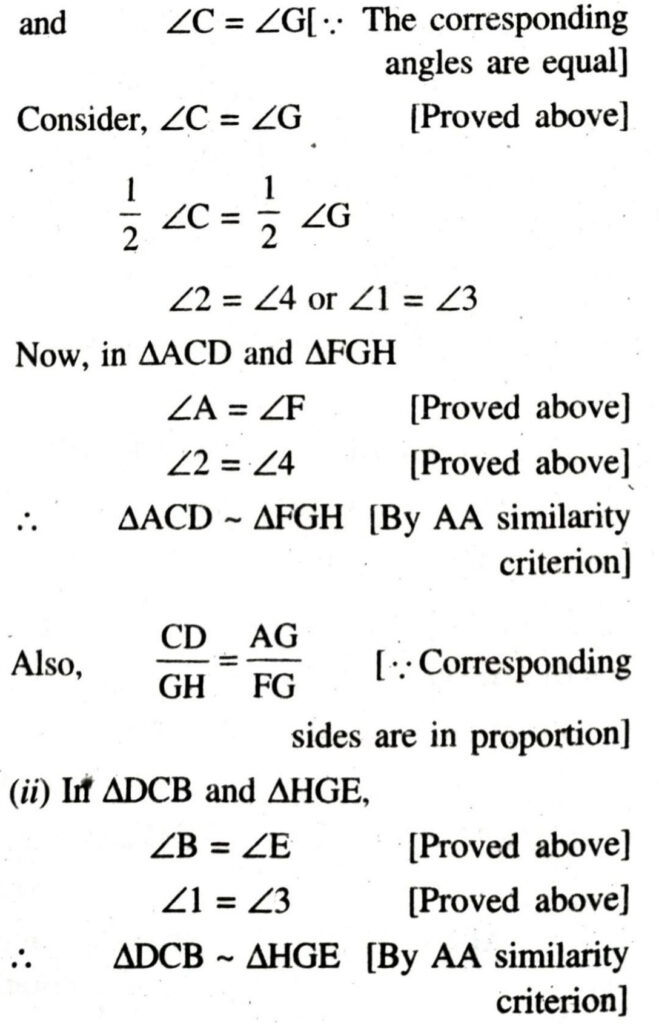
(iii) In ΔDCA and ΔHGF
∠A = ∠F [Proved above]
∠2 = ∠4 [Proved above]
∴ ΔDCA ∼ ΔHGF [By AA similarity criterion],
Q. 11. In Fig., E is a point on side CB produced of an isosceles triangle ABC with AB= AC. If AD ⊥ BC and EF ⊥ AC, prove that ΔBDA ∼ ΔECF.
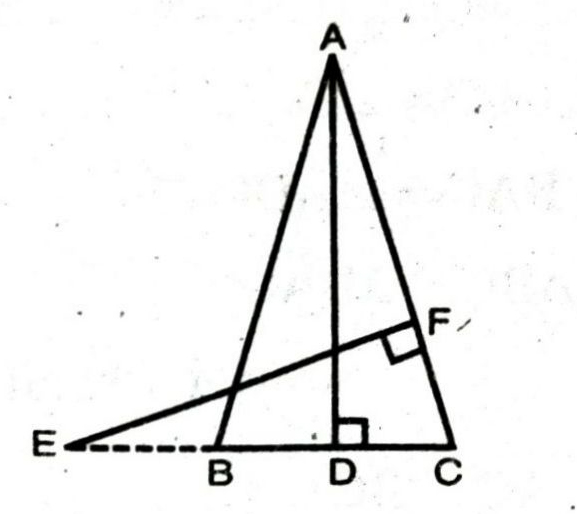
Solution. Given. ΔABC, isosceles triangle with AB = AC AD ⊥ BC, side BC is produced to E. EF ⊥ AC
To Prove. ΔABD ~ ΔECF
Proof. ΔABC is isosceles (given)
AB = AC
∴ ∠B = ∠C
[Equal side have equal angle opposite to it}
In ΔABD and ΔECF,
∠ABD = ∠ECF (Proved above)
∠ADB = ∠EFC (each 90°)
∴ ΔABD ~ ΔECF [AA similarity]
Q. 12. Sides AB and BC and median AD of a triangle ABC are respectively proportional to sides PQ and QR and median PM of ΔPQR (see Fig.). Show that ΔABC ∼ ΔPQR.
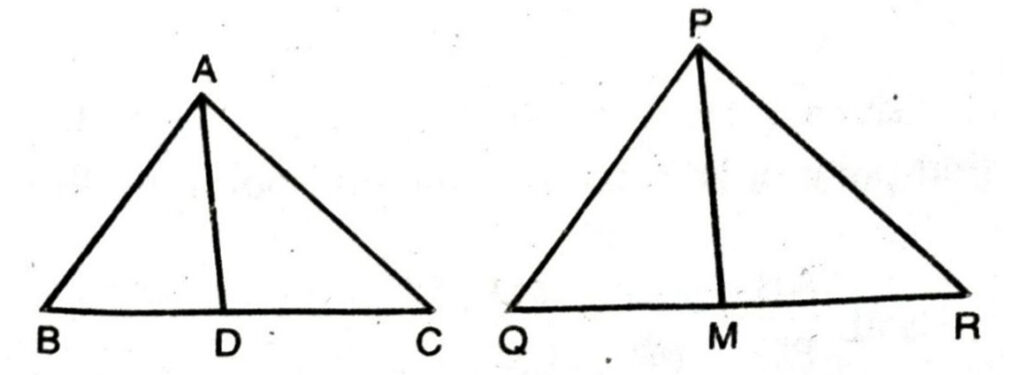
Solution.
Given. ΔABC and ΔPQR, AB, BC, and median AD of ΔABC are proportional to side PQ; QR and median PM of ΔPQR,
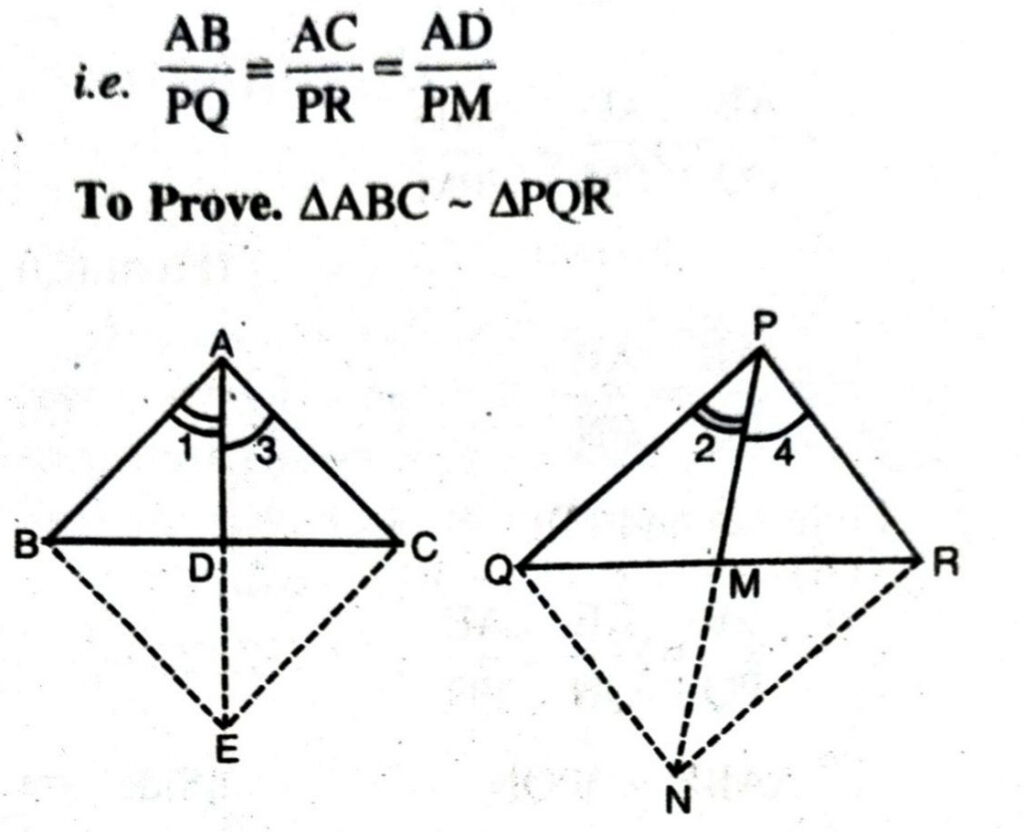
Construction. Produce AD to E such that AD=DE and produce PM to N such that PM = MN join BE, CE, QN and RN

Diagonal bisects each other in quadrilateral ABEC
∴ Quadrilateral ABEC is parallelogram
Similarly, PQNR is a parallelogram
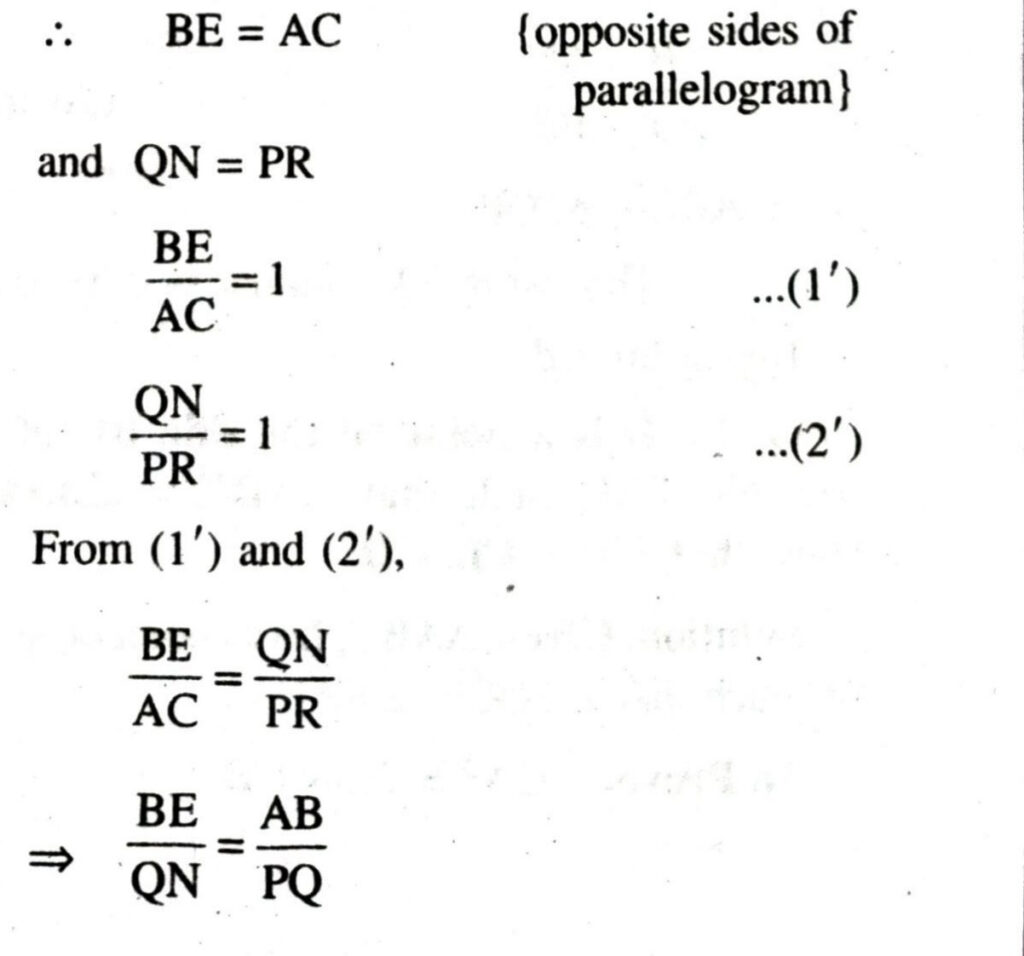
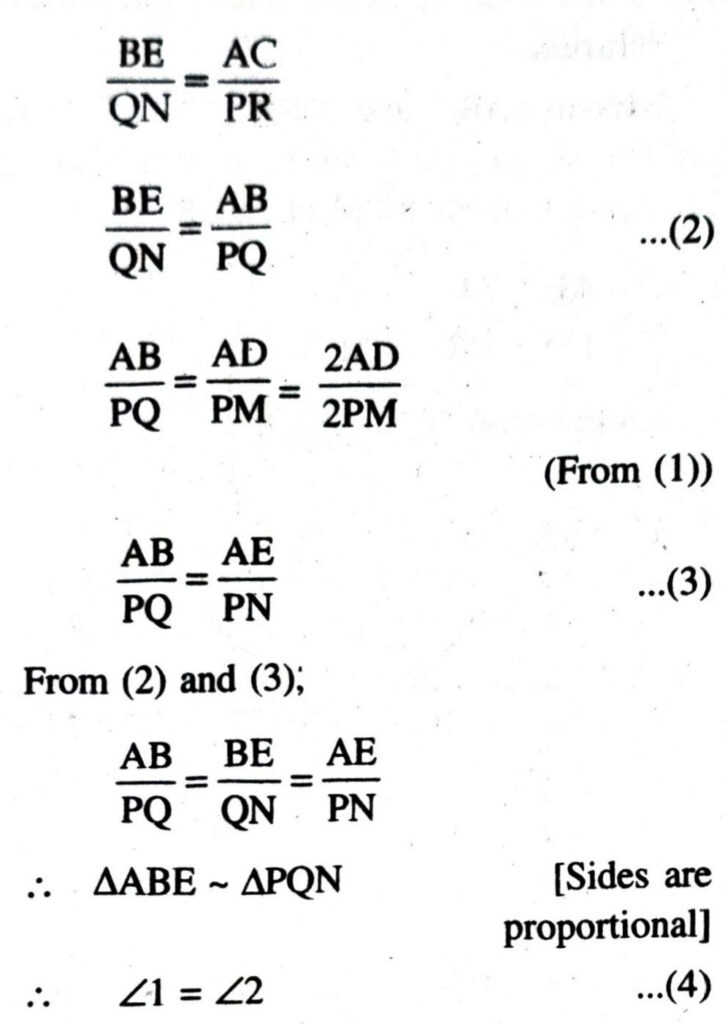
[Corresponding angles of similar triangles]
Similarly, ΔACE ~ ΔPRN
∠3 = ∠4 …(5)
[Corresponding angles of similar triangles]
Adding (4) and (5),
∠1 + ∠3 = ∠2 + ∠4
∠A = ∠P
Now, in ΔABC and ΔPQR,
∠A = ∠P (Proved)
∴ ABC ∼ ΔPQR
[By using SAS similarity criterion]
Hence Proved.
Q. 13. D is a point on the side BC of a triangle ABC such that ∠ADC = ∠BAC. Show that CA² = CB. CD.
Solution. Given. ΔABC, D is a point on side BC such that ∠ADC = ∠BAC
To Prove. CA² = BC × CD
Proof. In ABC and ΔADC,
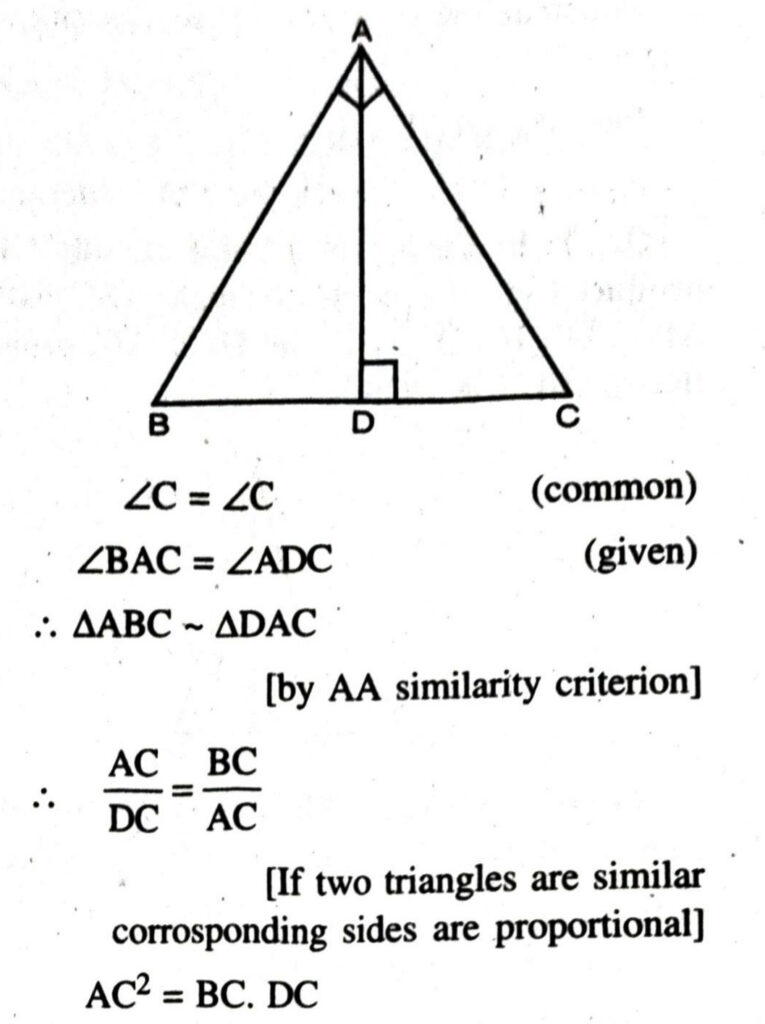
Hence Proved.
Q. 14. Sides AB and AC and median AD of a triangle ABC proportional to sides PQ and PR and median PM of another triangle PQR. Prove that ΔABC ~ ΔPQR.
Solution.
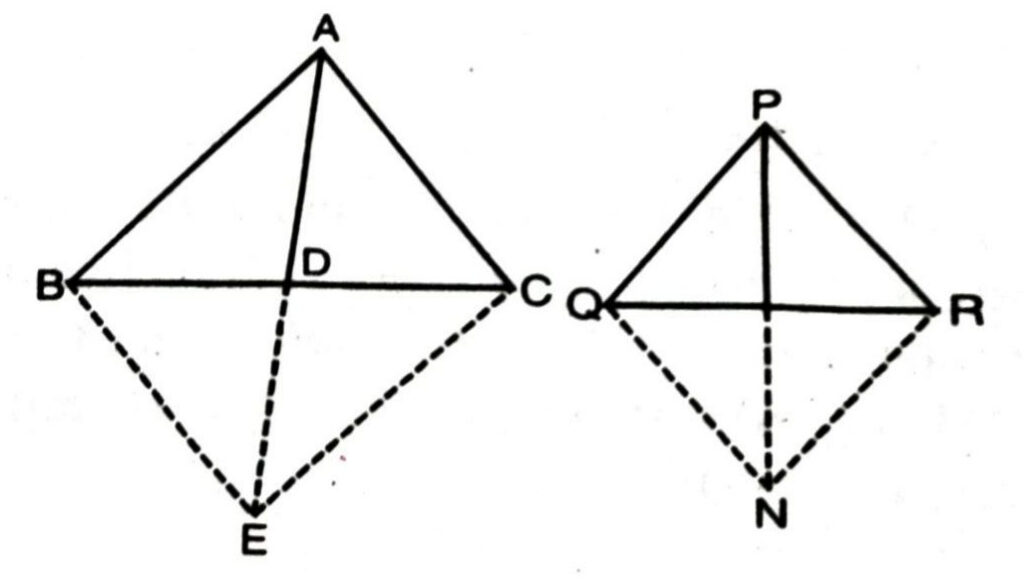
Given: Two Δs ABC and PQR. D is the mid-point of BC and M is the mid-point of QR.
To Prove. ΔABC -∼ ΔPQR
Construction. Produce AD to E such that AD = DE
Join BE and CE
Produce PM to N such that PM = MN
Join QN and NR.
Proof. In quad. ABEC, diagonals AE and BC bisect each other at D.
∴ Quad. ABEC is a parallelogram.
Similarly it can be shown that quad PQNR is a parallelogram.
Since ABEC is a parallelogram
∴ BE = AC …..(2)
Similarly since DQNR is a || gm
∴ QN = PR …… (3)
Dividing (2) by (3), we get :
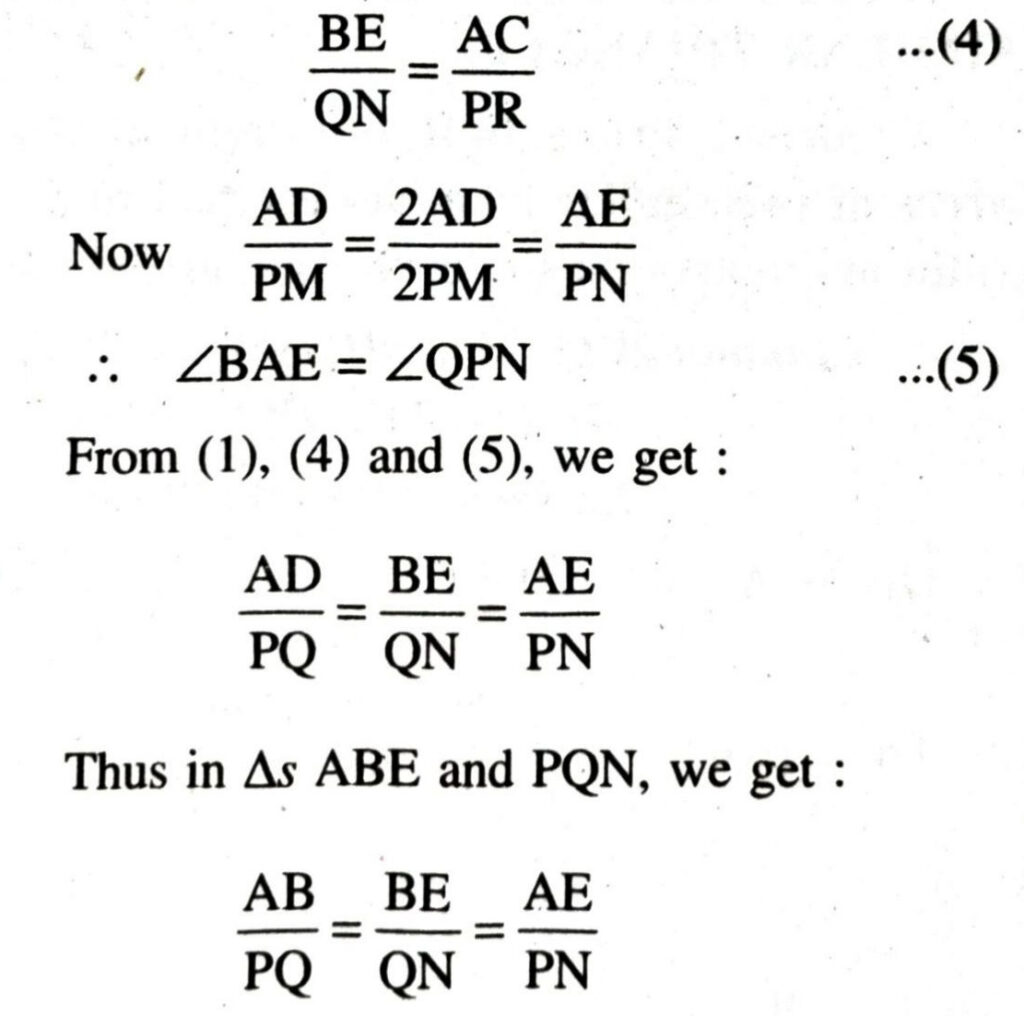
∴ ΔABC ∼ ΔPQN
∴ ∠BAE = ∠QPN ….(6)
Similarly it can be proved that
ΔAEC ∼ ΔPNR
∴ ∠EAC = ∠NPR ….. (7)
Adding (6) and (7), we get :
∠BAE + ∠EAC = ∠QPN + ∠NPR
i.e., ∠BAC = ∠QPR
Now in ΔABC and ΔPQR.
and included ∠A = ∠P
∴ ΔABC ∼ ΔQPR
(By SAS criterion of similarity)
Q. 15. A vertical pole of length 6 m casts a shadow 4 m long on the grou 77nd and at the same time a tower casts a shadow 28 m long. Find the height of the tower.
Solution.
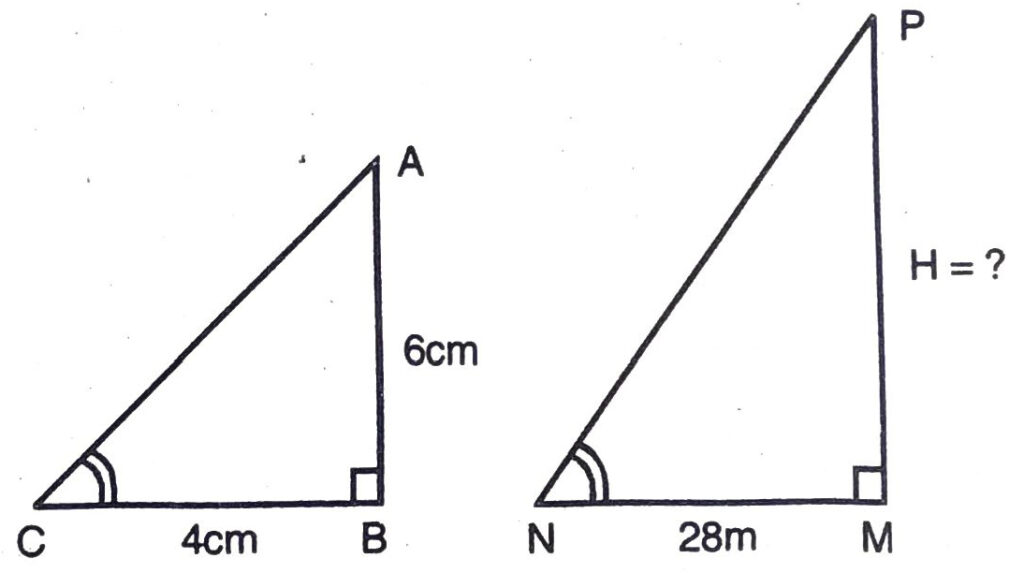
Length of vertical sticks = 6 m
Shadow of sticks = 4 m
Let height of tower be H m
Length of shadow of tower = 28 m
In ΔABC and ∠PMN,
∠C = ∠N (angle of altitude of sun)
∠B = ∠M (each 90°)
∴ ΔABC ∼ ΔPMN
[AA similarity criterion]
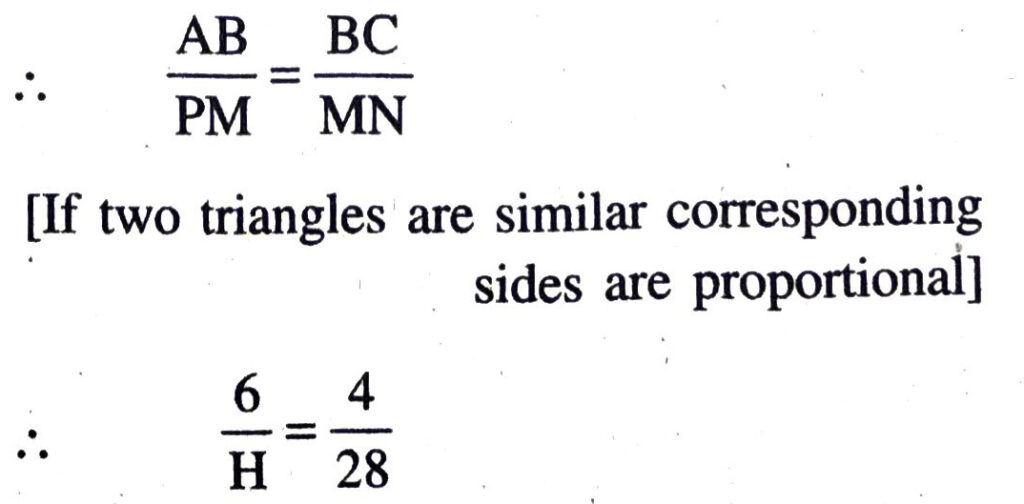
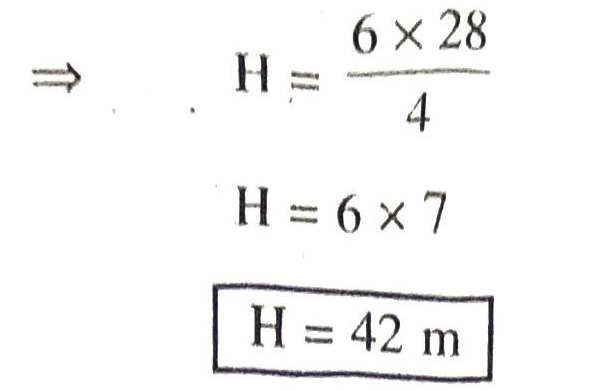
Hence, Height of Tower = 42 m Ans.
Q. 16. AD and PM are medians of triangles ABC and PQR, respectively where ΔABC ~ ΔPQR, prove that 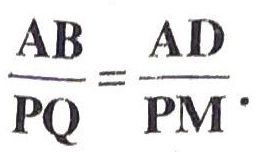
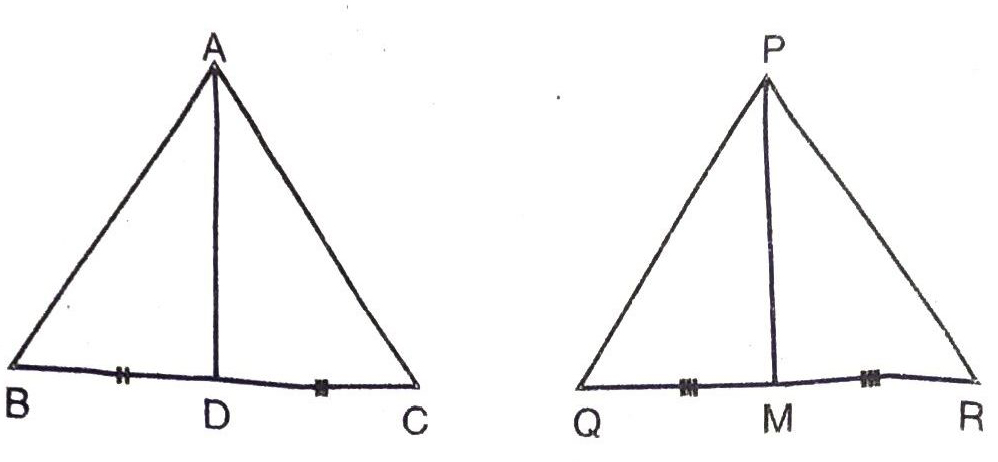
Solution. Given. ΔABC and ΔPQR, AD and PM are median and ΔABC ~ ΔPQR
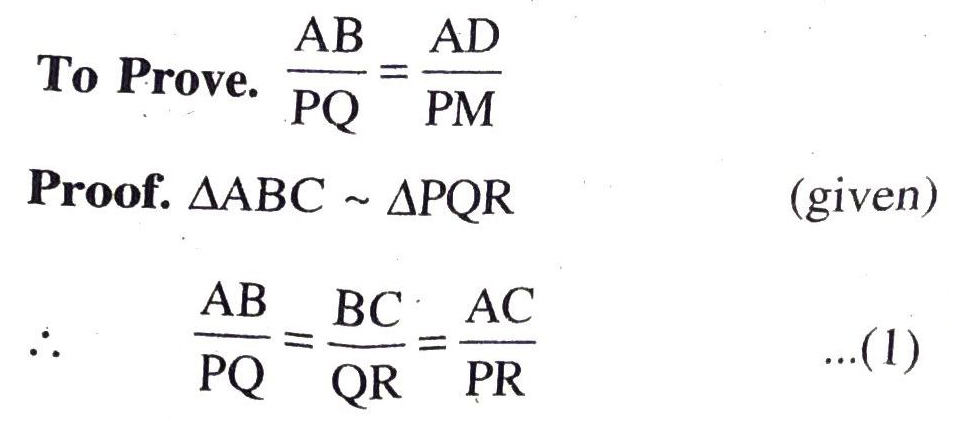
{If two triangles are similar corresponding sides are proportional}
∠A = ∠P
(If two triangles are similar corresponding angles are equal)
∠B = ∠Q
∠C = ∠R
D is mid point of BC
M is mid-point of QR
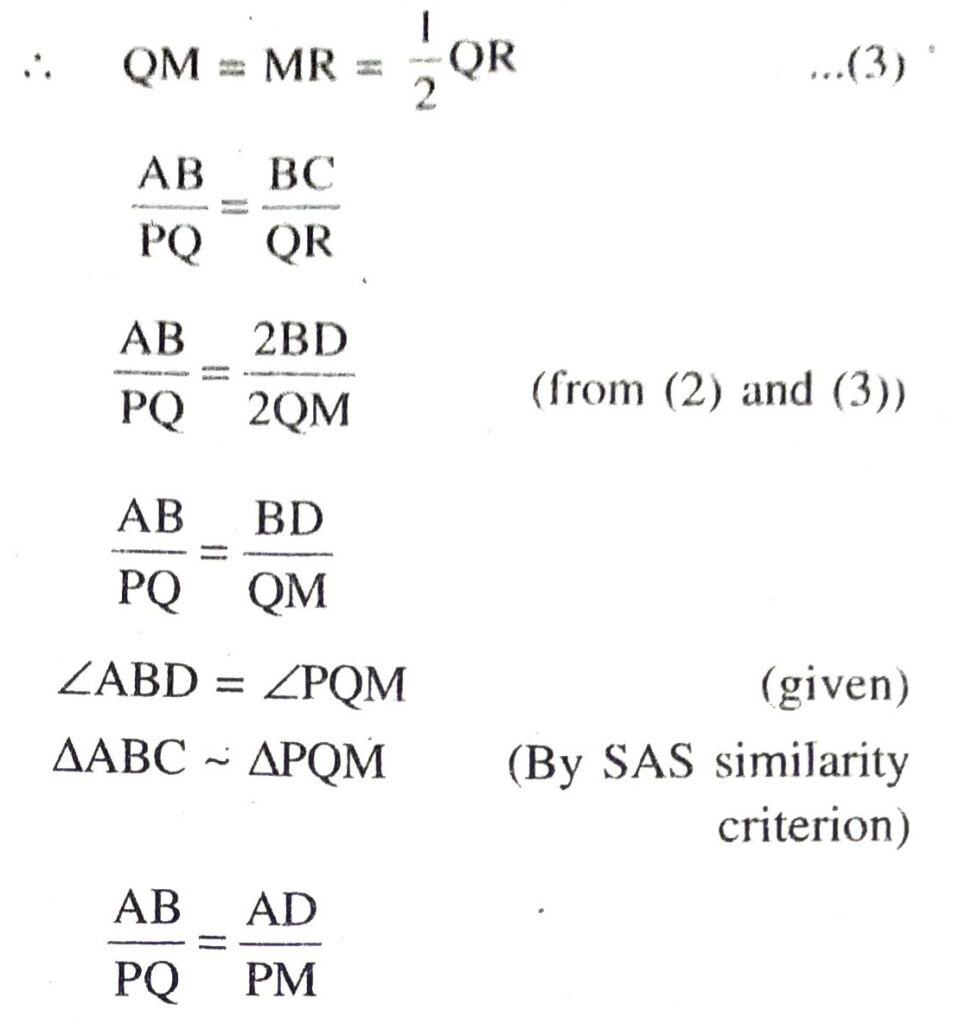
[If two triangles are similar corresponding sides are proportional]
TEXT BOOK EXERCISE 6.4
Q. 1. Let ΔABC ∼ ΔDEF and their areas be respectively 64 cm² and 121 cm². If EF 15.4 cm, find BC.
Solution. ΔABC ~ ΔDEF; area of ΔABC = 64 cm²; area of ΔDEF = 121 cm²; EF = 15.4 cm
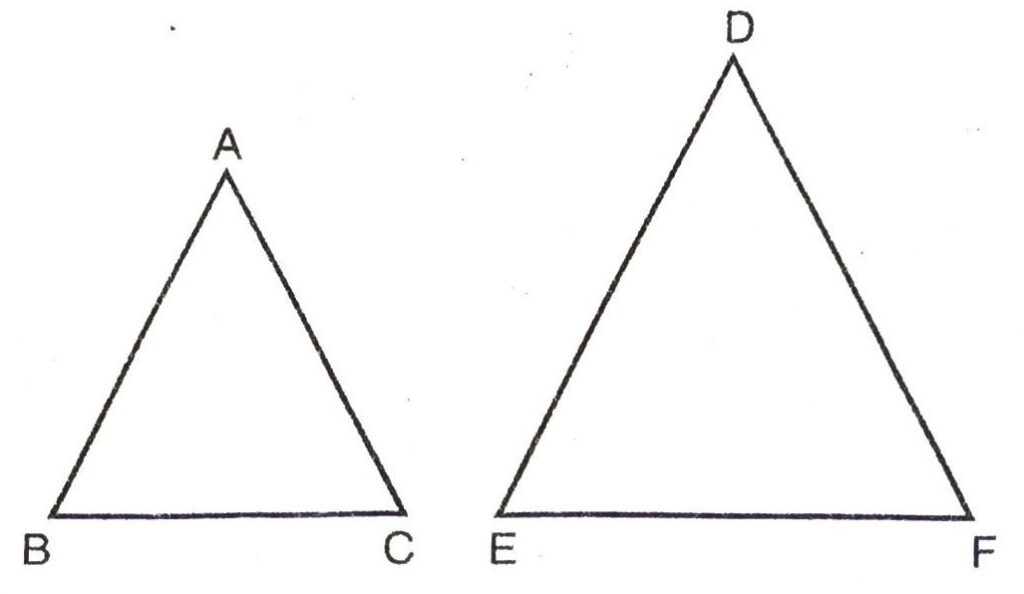
ΔABC ∼ ΔDEF

{If two triangles are similar ratio of their area is square of corresponding sides}
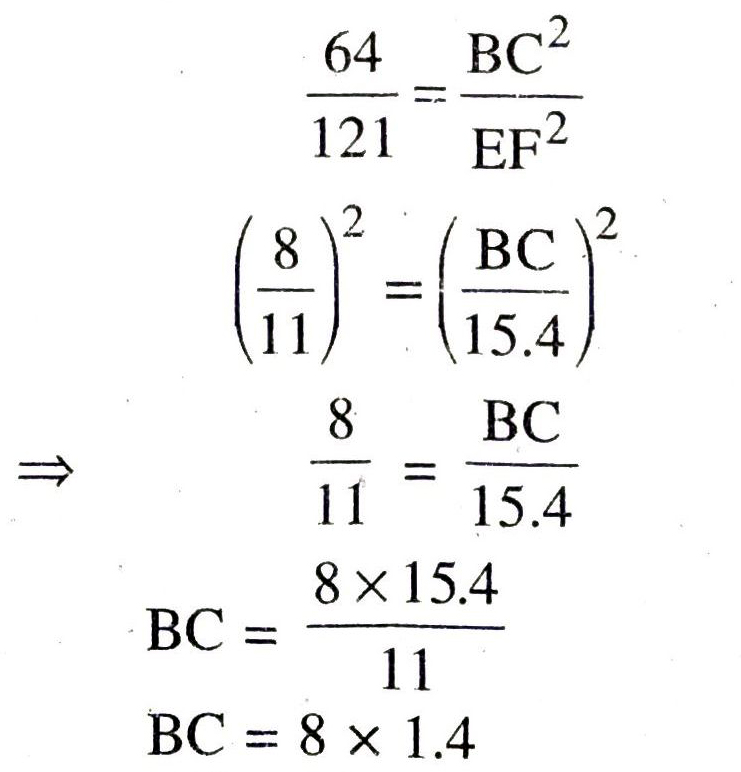
BC = 11.2 cm Ans.
Q. 2. Diagonals of a trapezium ABCD with AB || DC intersect each other at the point O. If AB = 2 CD, find the ratio of the areas of triangles AOB and COD.
Solution. ABCD is trapezium AB || DC. Diagonals AC and BD intersects each other at the point O. AB = 2 CD
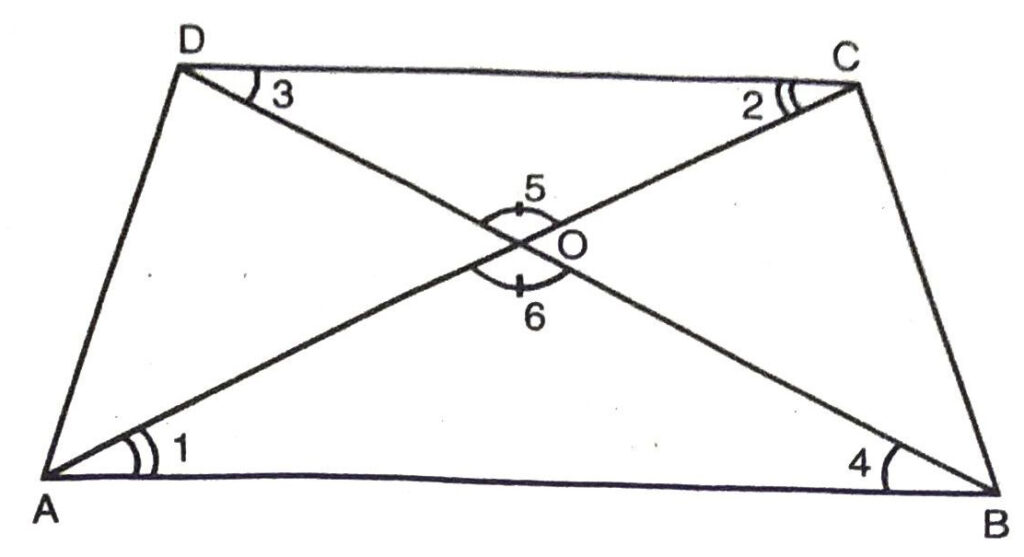
In ΔAOB and ΔCOD,
∠1 = ∠2 (alternate angles)
∠3 = ∠4 (alternate angles)
∠5 = ∠6 (vertically opposite angles)
∴ ΔΑΟΒ ~ ΔCOD [AA similarity criterion]

{If two triangles are similar ratio of their area is square of corresponding sides}
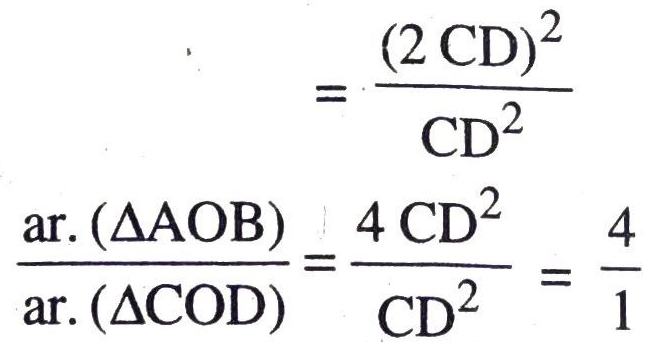
∴ Required ratio of ar ΔAOB and ΔCOD = 4 : 1
Q. 3. In the fig., AABC and ADBC are two triangles on the same base BC. If AD intersects BC at O show that
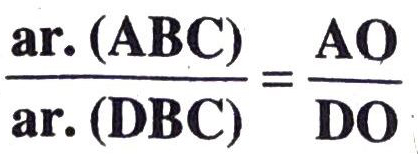
Given. ΔABC and ΔDBC are the triangles on same base BC, AD intersects BC at O
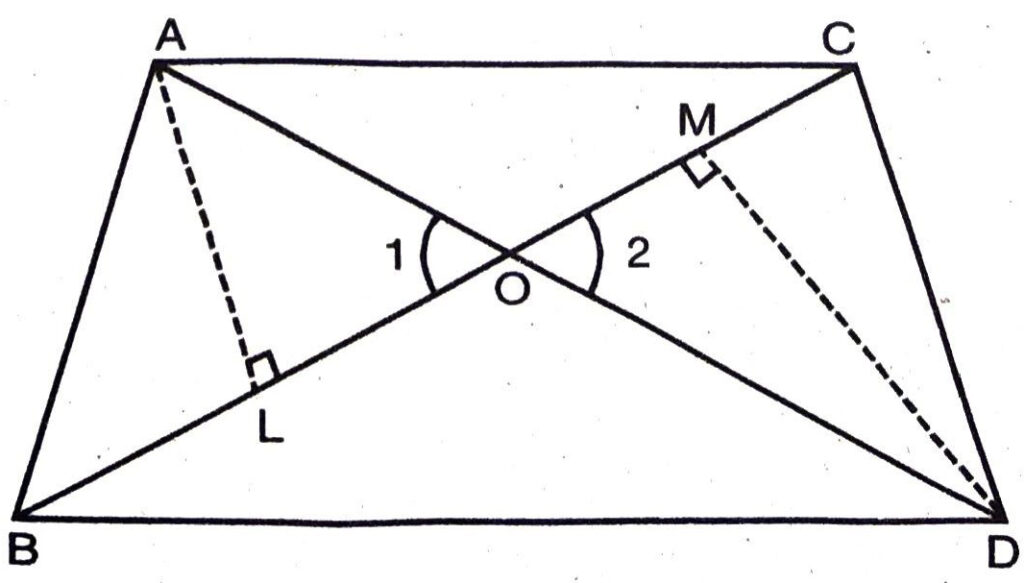

Construction : Draw AL ⊥ BC, DM ⊥ BC
Proof. In ΔALO and ΔDMO,
∠1 = ∠2 (vertically opposite angles)
∠L = ∠M (each 90°)
∴ ΔALO ~ ΔDMO [AA similarity criterion]
[If two triangles are similar corresponding sides are proportional]
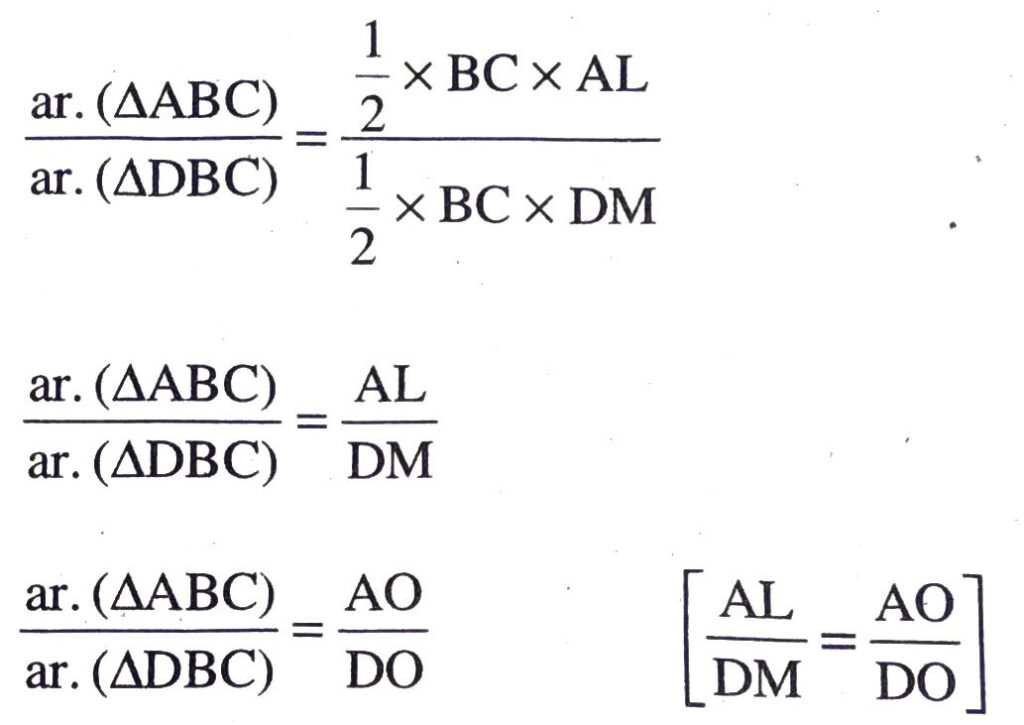
Hence Proved.
Q. 4. If the areas of two similar triangles are equal, prove that they are congruent.
Solution: Given: Two Δs ABC and DEF are similar and equal in area.
To Prove: ΔABC = ΔDEF
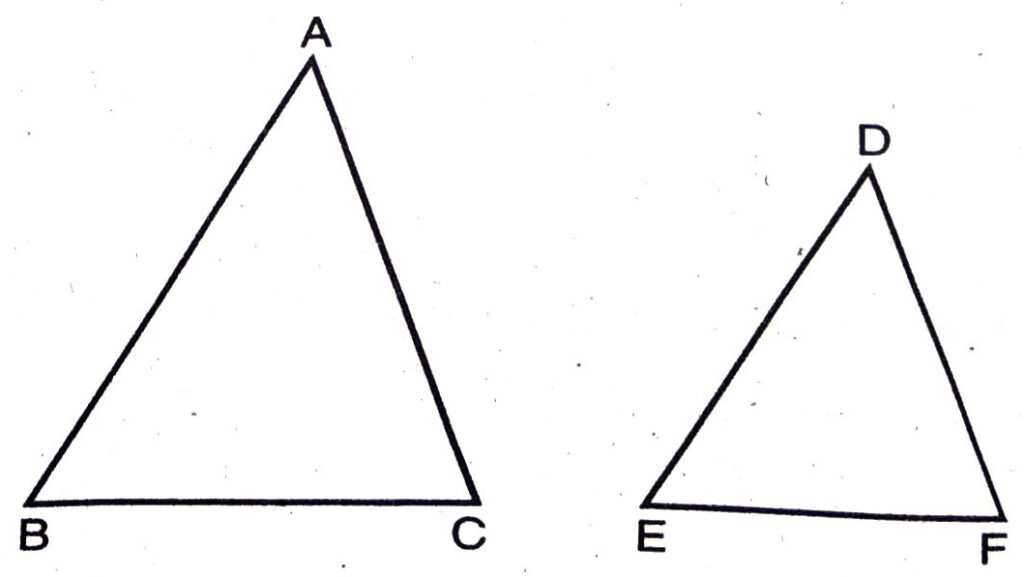
Proof. Since ΔABC ∼ ΔDEF,
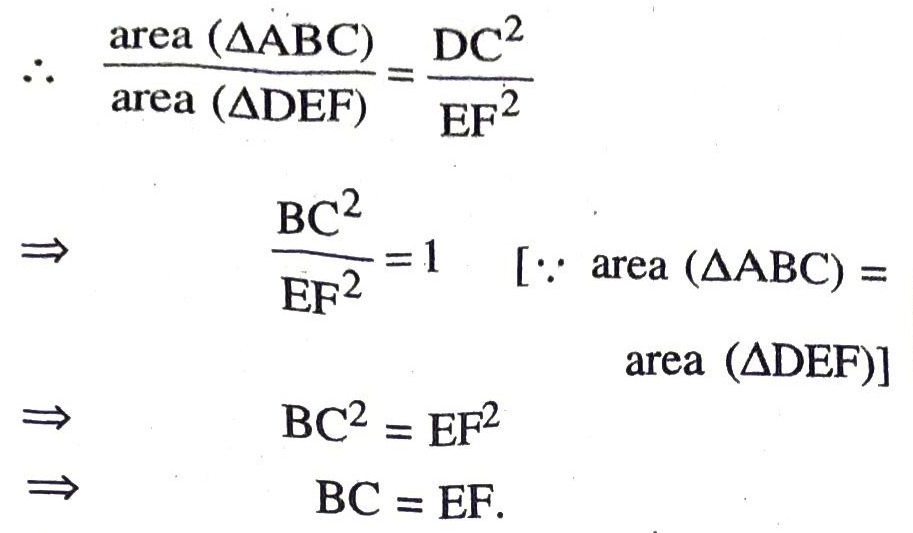
Also, since ΔABC ∼ ΔDEF,
therefore they are equiangular
and hence ∠B = ∠E
and ∠C = ∠F
Now in Δs ABC and DEF,
∠B = ∠E, ∠C = ∠F
and BC = EF
∴ ΔABC ≅ ΔDEF
(ASA congruence)
Q. 5. D, E and F are respectively the midpoints of the sides BC, CA and AB of ΔABC. Determine the ratio of the areas of triangles DEF and ABC.
Solution.
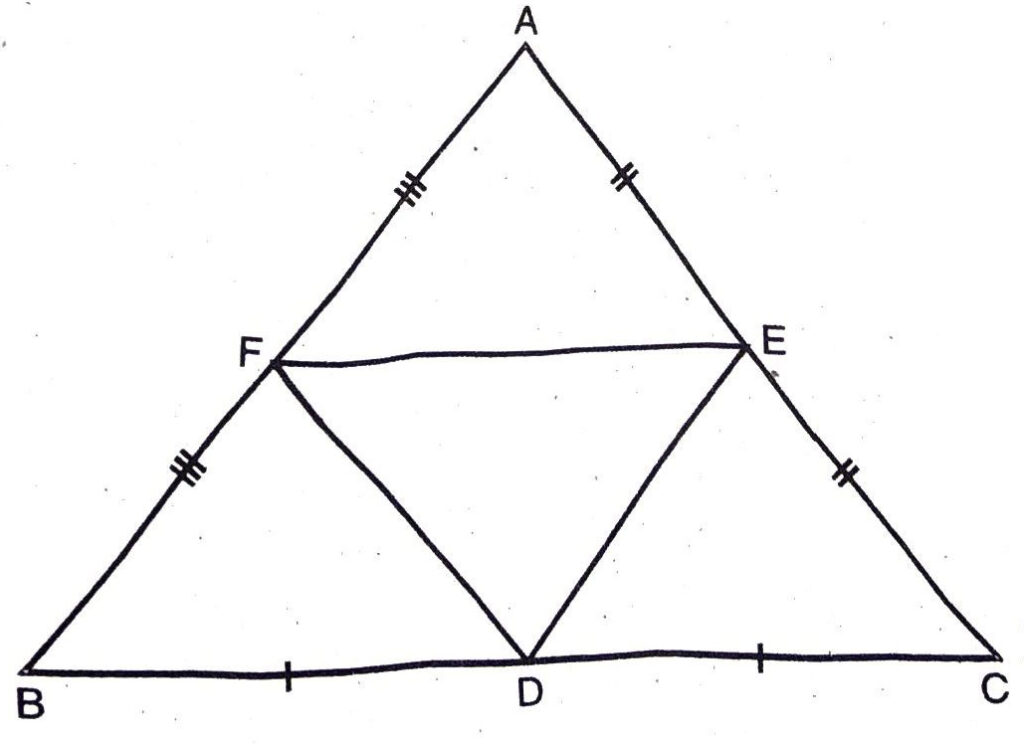
Given. D, E, F are the mid-point of the sides BC, CA and AB respectively of a ΔABC.
To find : ar (ΔDEF): ar (ΔABC)
Proof: In ΔABC,
F is the mid-point of AB (given)
E is the mid-point of AC (given)
So, by the Mid-Point Theorem
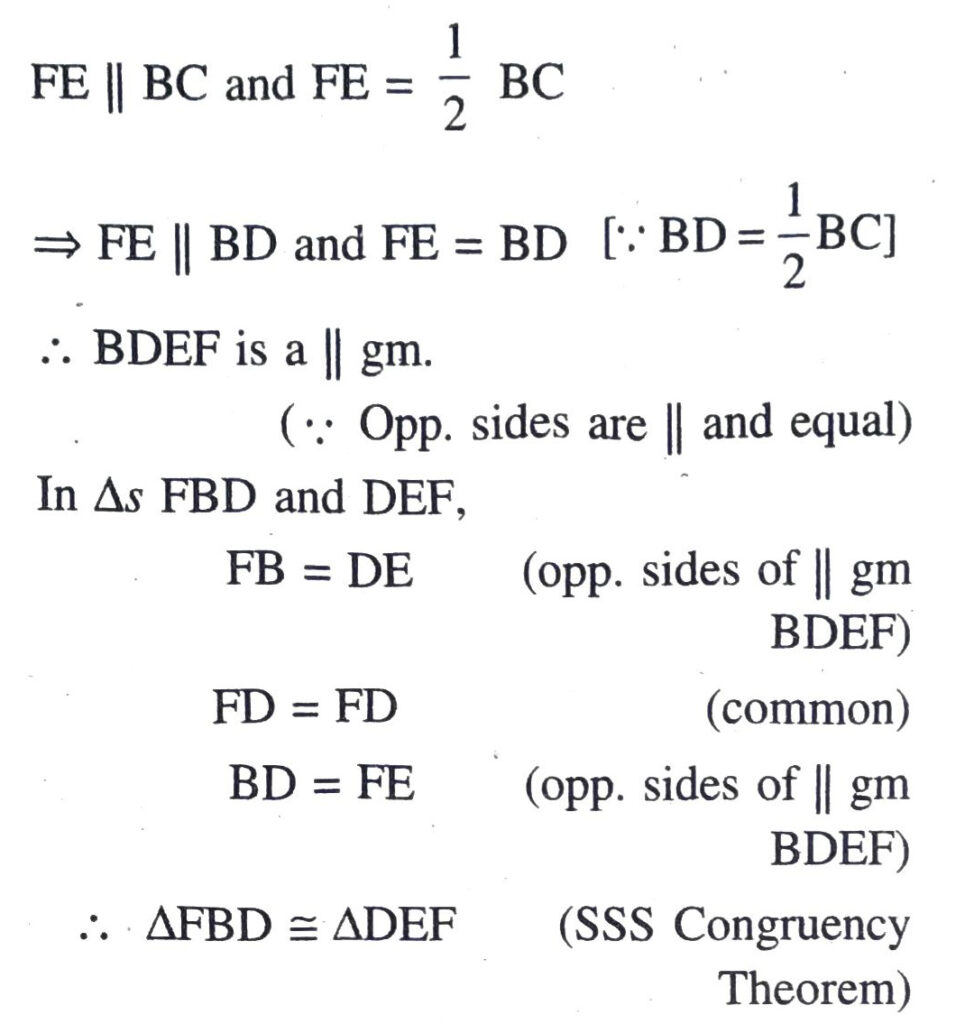
Similary we can prove that :
ΔAFE ≅ ΔDEF
and ΔEDC ≅ ΔDEF
If Δs are ≅, then they are equal in area.
∴ ar (ΔFBD) = ar. (ΔDEF) …(1)
ar (ΔAFE) = ar (ΔDEF) …(2)
ar (ΔEDC) = ar (ΔDEF) …(3)
Now ar Δ (ABC)
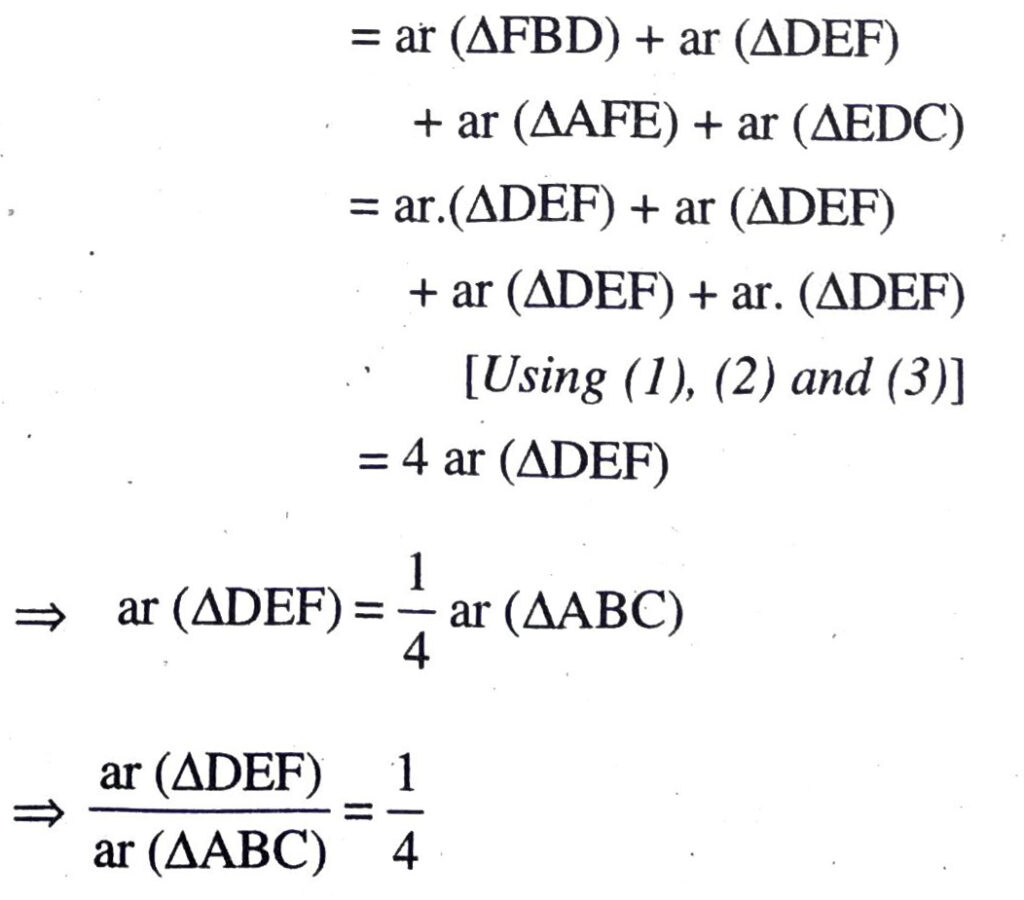
∴ ar (ΔDEF): ar (ΔABC) = 1 : 4.
Q. 6. Prove that the ratio of the areas of two similar triangles is equal to the square of the ratio of their corresponding medians.
Solution. Given : ΔABC ~ ΔDEF.
AX and DY are the medians to the side BC and EF respectively.
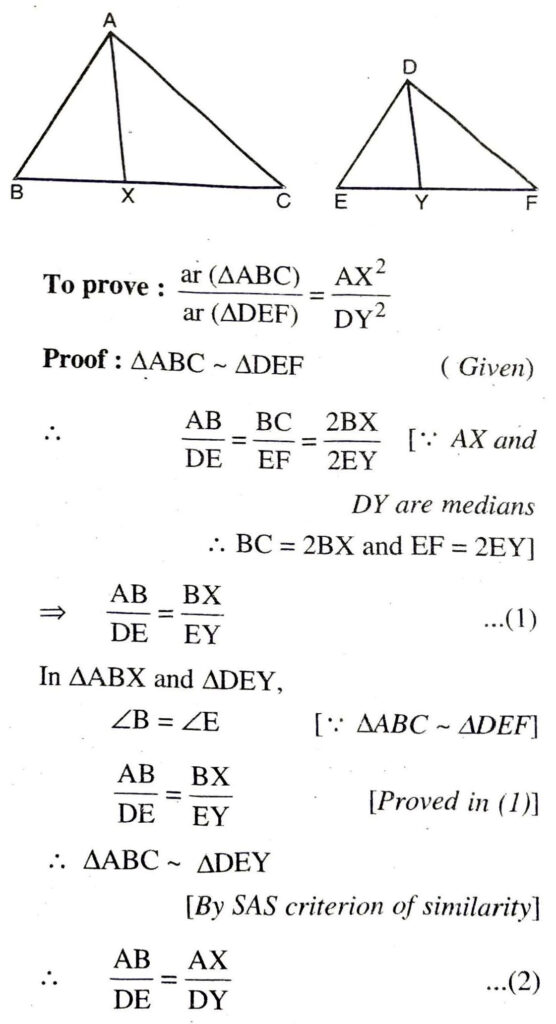
As the areas of two similar triangles are proportional to the squares of the corresponding sides, so

Hence proved.
Q. 7. Prove that the area of the equilateral triangle described on the side of a square is half the area of the equilateral triangle described on its diagonal.
Solution. Given : ABCD is a square. Equilateral ΔABC is described on the side AB of the square and equilateral ΔACF is described on the diagonal AC.
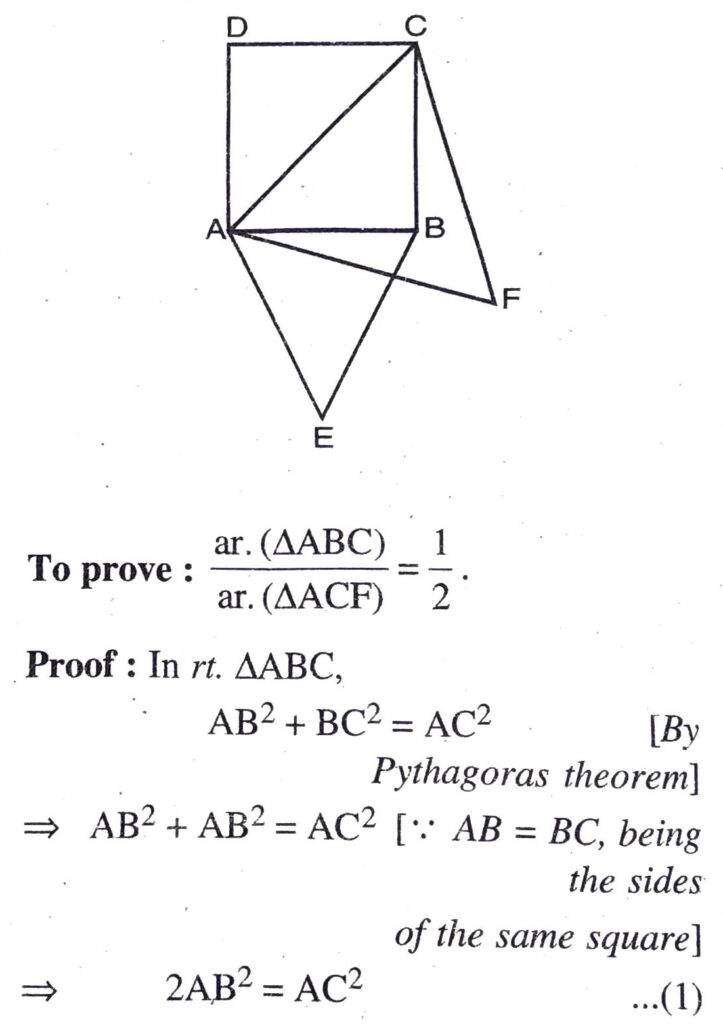
Now each of ΔABC and ΔACF are equilateral and therefore equiangular and hence similar.
i.e., ΔABE ∼ ΔACF.
Here any side of one A is proportional to any side of other.
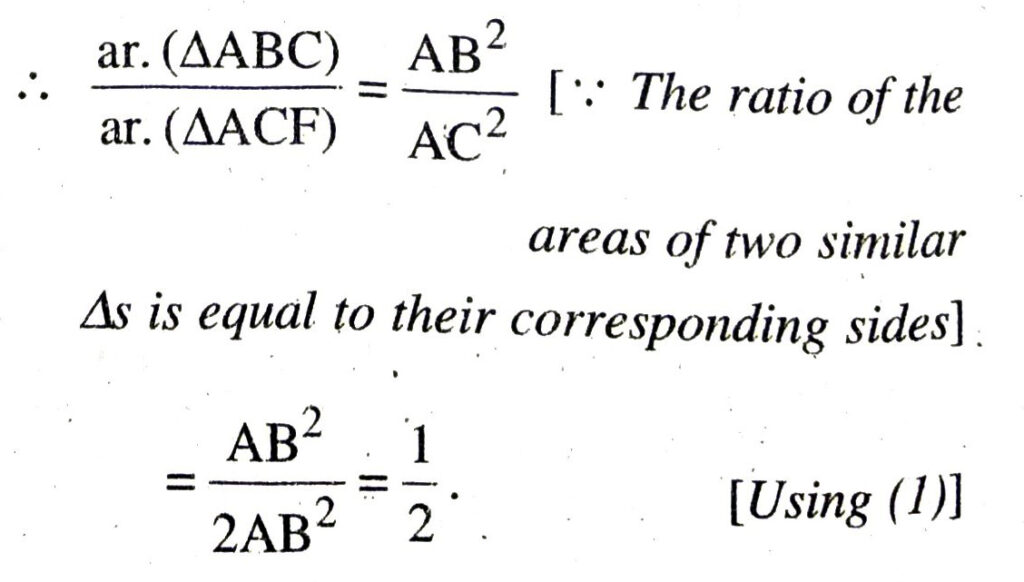
Tick the correct answer and justify:
Q. 8. ABC and BDE are two equilateral triangles such that D is the mid point of BC. Ratio of the areas of triangles ABC and BDE is
(A) 2:1
(B) 1:2
(C) 4:1
(D) 1:4.
Solution. ΔABC and ΔBDE are two equilateral triangles, D is mid point of BC.
Let each side of triangles are 2a
∴ ΔABC ~ ΔBDE
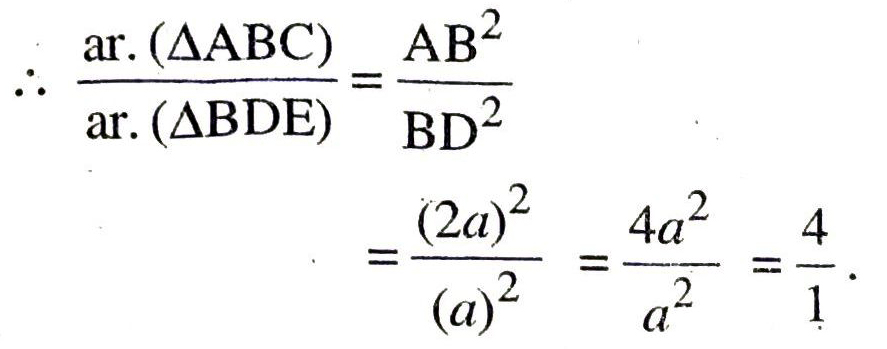
∴ Correct option is (C).
Q. 9. Tick the correct answer and justify: Sides of two similar triangles are in the ratio 4:9. Areas of these triangles are in the ratio
(A) 2:3
(B) 4:9
(C) 81: 16
(D) 16: 81.
Solution.
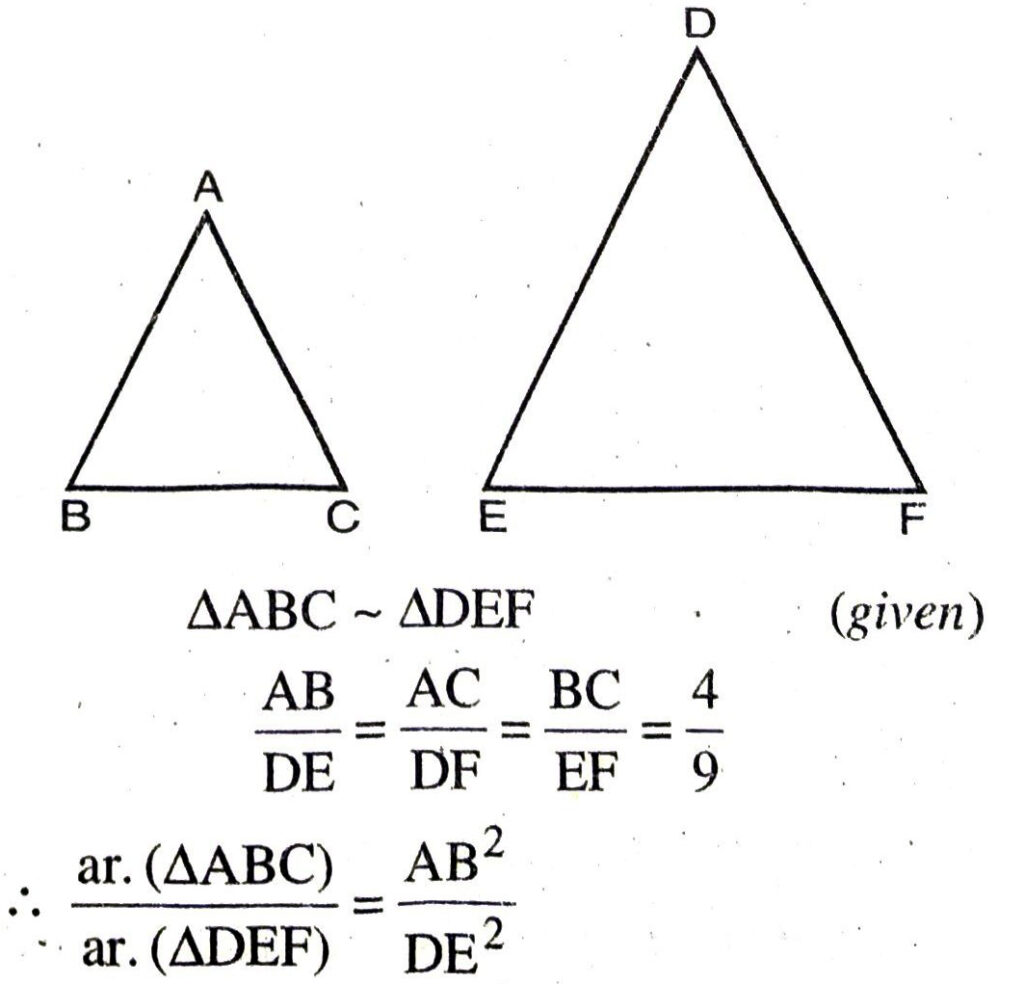
[If two triangles are similar ratio of there area is equal to square of corresponding sides]

∴ Correct option is (D).
TEXT BOOK EXERCISE 6.5
Q. 1. Sides of triangles are given below. Determine which of them are right triangles. In case of a right triangle, write the length of its hypotenuse.
(i) 7 cm, 24 cm, 25 cm
(ii) 3 cm, 8 cm, 6 cm
(iii) 50 cm, 80 cm, 100 cm
(iv) 13 cm, 12 cm, 5 cm.
Solution. (i) Let ΔABC, with AB = 7 cm BC= 24 cm, AC = 25 cm
AB² + BC² = (7)² + (24)²
= 49 + 576 = 625
AC² = (25)² = 625
Now AB²+ BC² = AC²
∴ ΔABC is right angled triangle.
(ii) Let ΔPQR with PQ = 3 cm, QR = 8 cm PR = 6 cm
PQ² + PR² = (3)² + (6)²
= 9 + 36 = 45
QR² = (8)² = 64.
Here PQ² + PR² ≠ QR²
∴ ΔPQR is not right angled triangle.
(iii) Let ΔMNP, with MN = 50 cm,
NP = 80 cm, MP = 100 cm
MN² + NP² = (50)² + (80)²
= 2500 + 6400 = 8900
MP² = (100)² = 10000
Here MP² ≠ MN² + NP².
∴ ΔMNP is not right angled triangle.
(iv) Let ΔABC, AB = 13 cm, BC = 12 cm, AC = 5 cm
BC² + AC² = (12)² + (5)²
= 144 + 25 = 169
AB² = (13)² = 169
∴ AB² = BC² + AC²
Δ ABC is right angled triangle.
Q. 2. PQR is a triangle right angled at P and M is a point on QR such that PM ⊥ QR. Show that PM² = QM.MR.
Solution. Given : ΔPQR is right angled at P and M is a point on QR such that PM ⊥ QR.
To prove: PM² = QM × MR
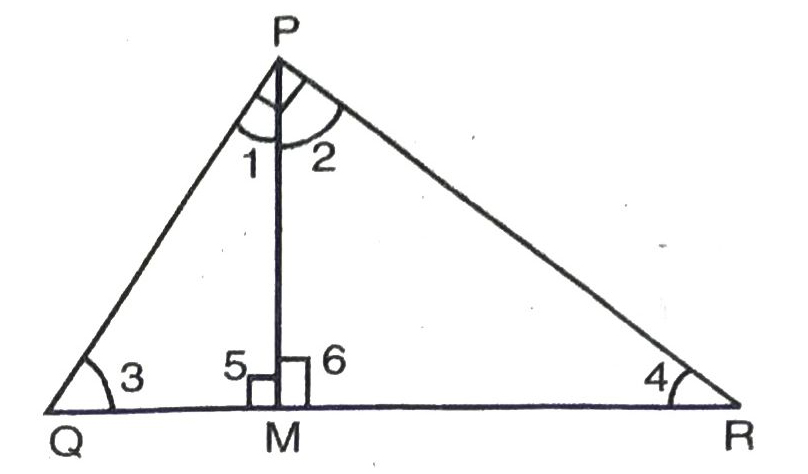
Proof: ∠P = 90° (given)
∴ ∠1 + ∠2 = 90° …(1)
∠M = 90°
In ΔPMQ,
∠1 + ∠3 + ∠5 = 180°
∠1 + ∠3 = 90° …(2) [∠5 = 90°]
From (1) and (2),
∠1 + ∠2 = ∠1 + ∠3
∠2 = ∠3
In ΔQPM and ΔRPM,
∠3 = ∠2 (Proved)
∠5 = ∠6 (Each 90°)
∴ ΔΟΜΡ ~ ΔΡΜR [AA similarity]

[If two triangles are similar, ratio of their area is equal to square of corresponding side]
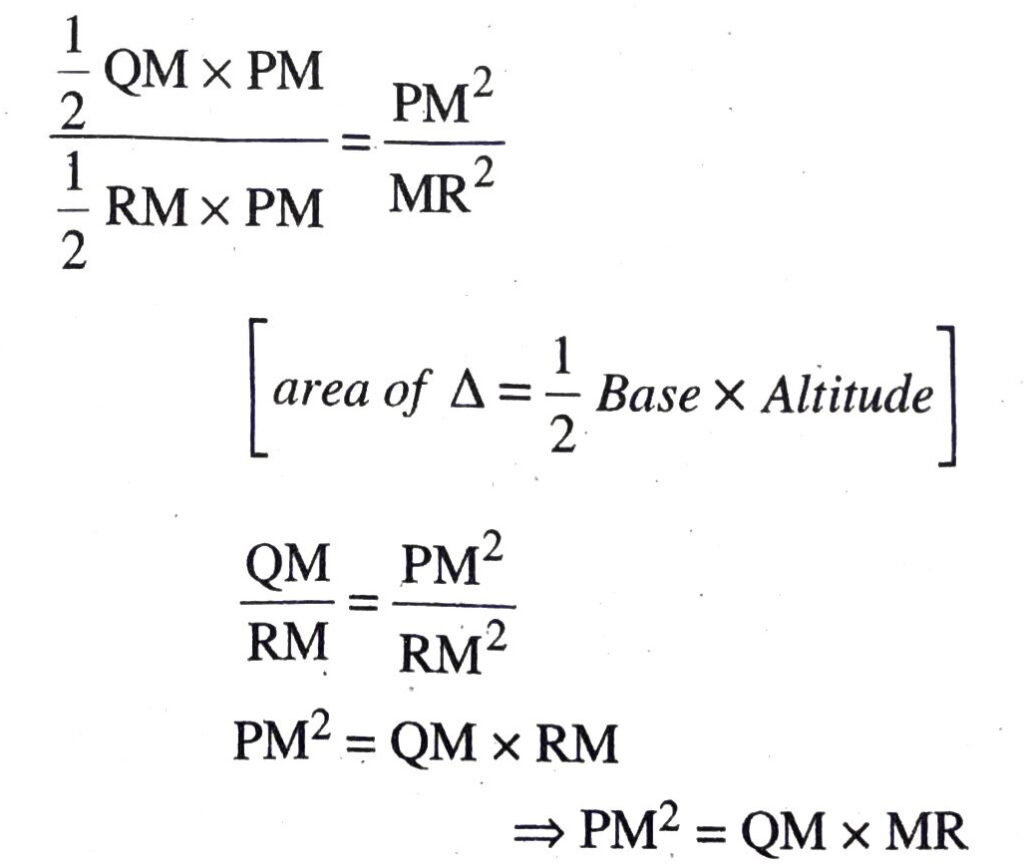
Hence proved.
Q. 3. In fig., ABD is a triangle right angled at A and AC ⊥ BD. Show that
(i) AB2 = BC.BD
(ii) AC2 = BC.DC
(iii) AD2 = BD.CD.
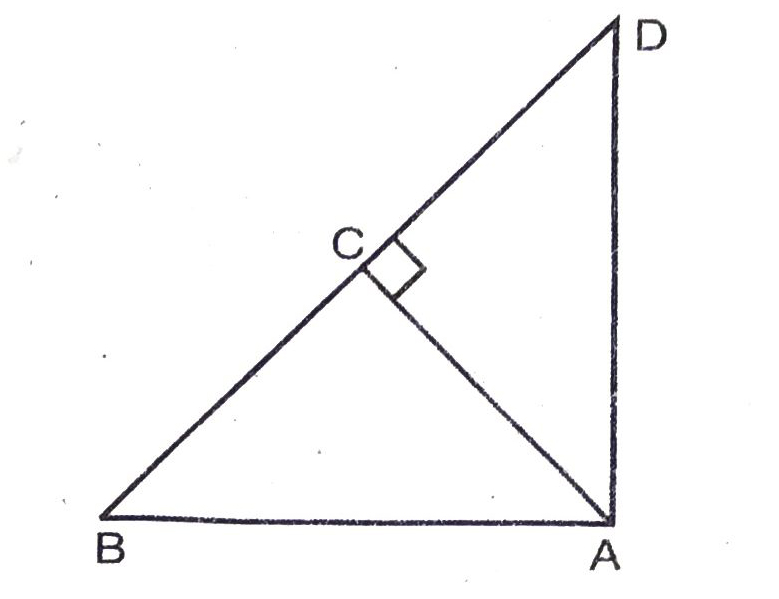
Solution. In ΔDAB and ΔDCA,
∠D = ∠D (common)
∠A = ∠C (each 90°)
∴ ΔDAB ~ ΔDCA [AA similarity]
In ΔDAB and ΔACB, …(1)
∠B = ∠B (common)
∠A = ∠C (each 90°)
∴ ΔDAB ~ ΔACB, …(2)
From (1) and (2),
ΔDAB ~ ΔACB ~ ΔDCA.
(i) ΔACB ~ ΔDAB (proved)

[If two triangles are similar corresponding sides are proportional]
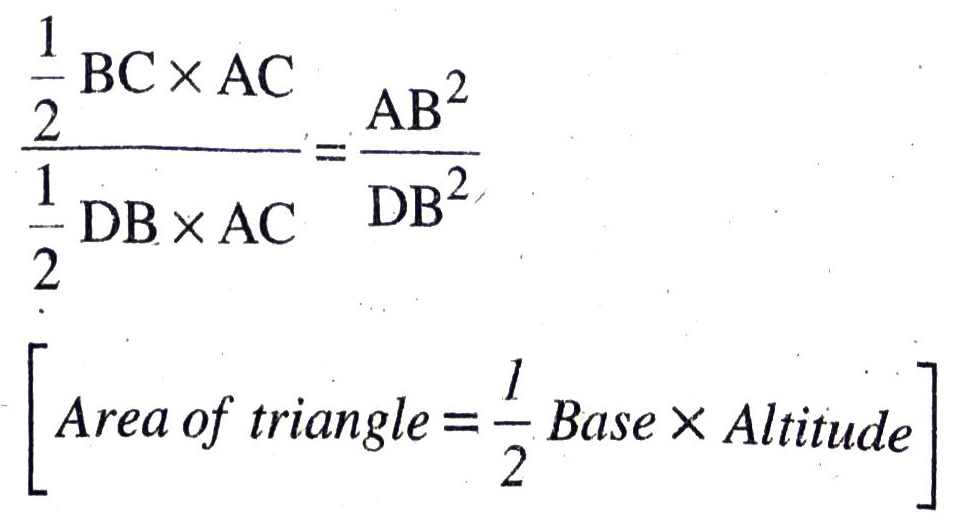
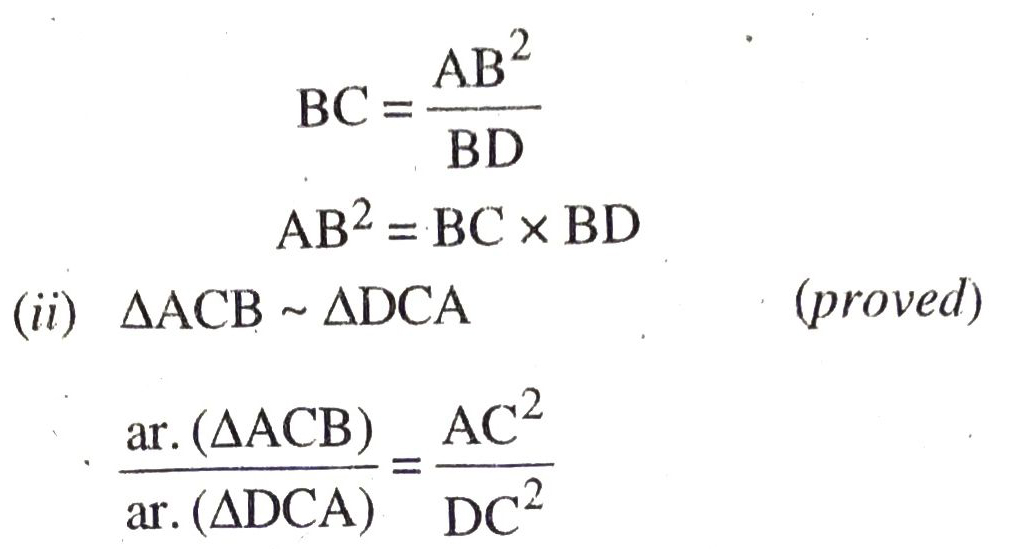
[If two triangles are similar corresponding sides are proportional]
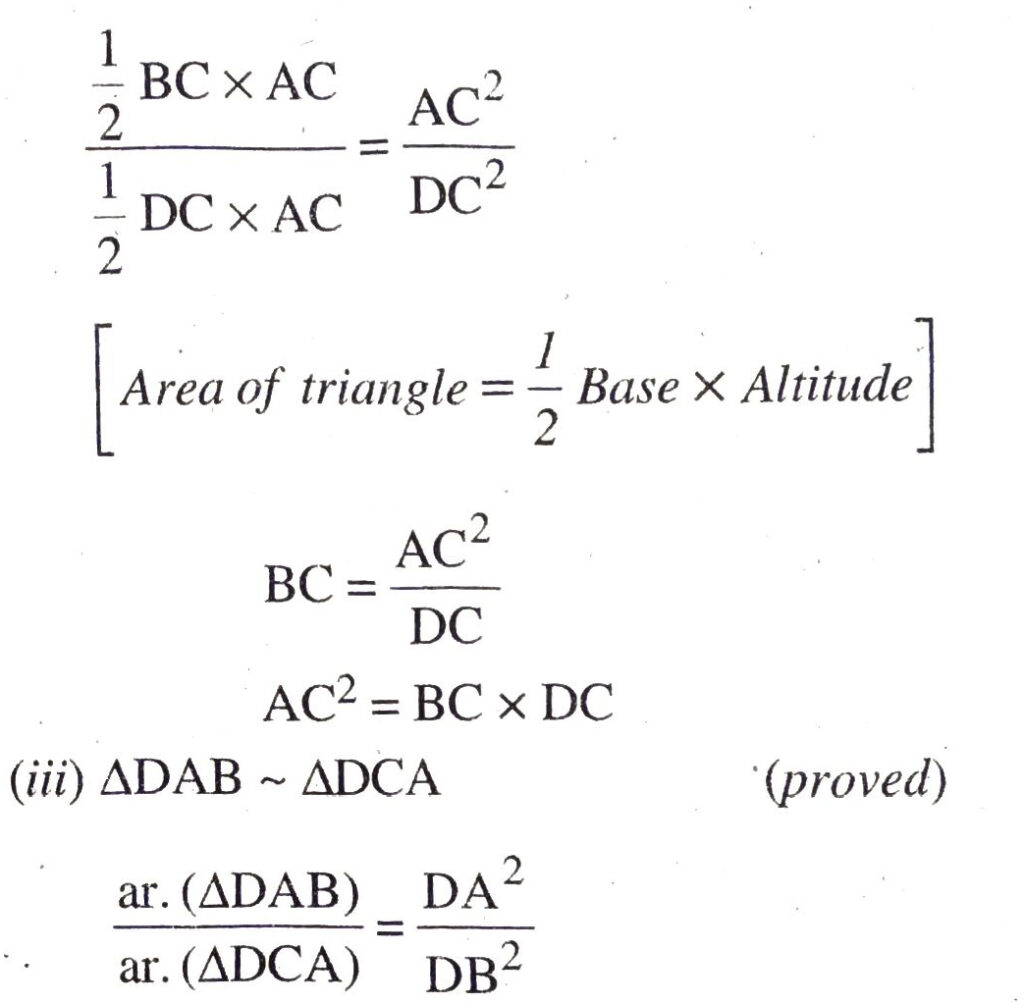
[If two triangles are similar corresponding sides are proportional]
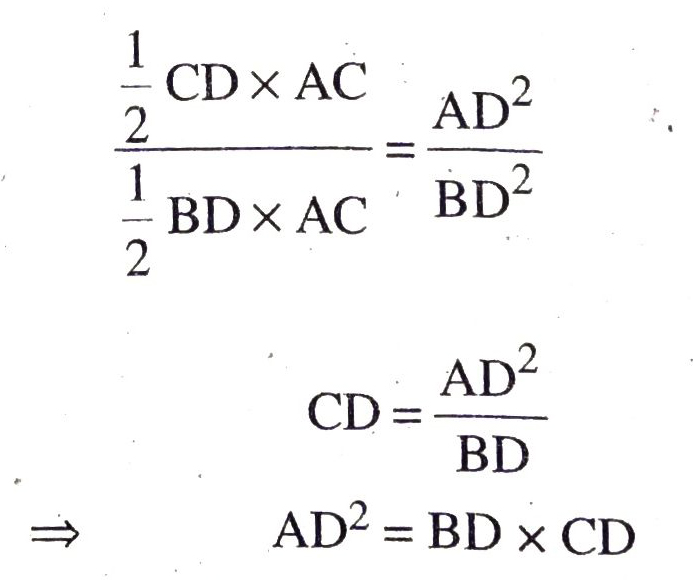
Q. 4. ABC is an isosceles triangle right angled at C. Prove that AB² = 2AC².
Solution. Given : ΔABC is an isosceles triangle right angled at C.
To prove: AB² = 2AC².
Proof: In ΔACB, ∠C = 90°
AC = BC (given)
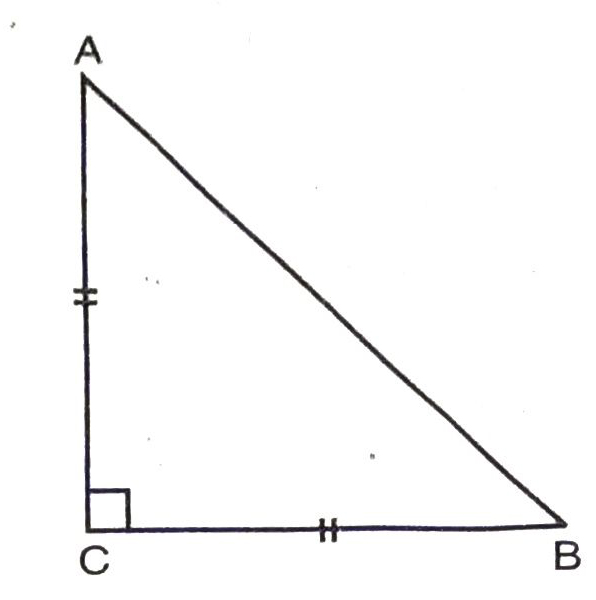
AB2 = AC2 + BC2
[By using Pythagoras Theorem]
= AC² + AC² [BC = AC]
AB² = 2AC²
Hence proved.
Q. 5. ABC is an isosceles triangle with AC = BC. If AB² = 2AC², prove that ABC is right triangle.
Solution. Given : AABC is an isosceles triangle AC = BC
and AB² = 2AC²
To prove: ΔABC is a right triangle.
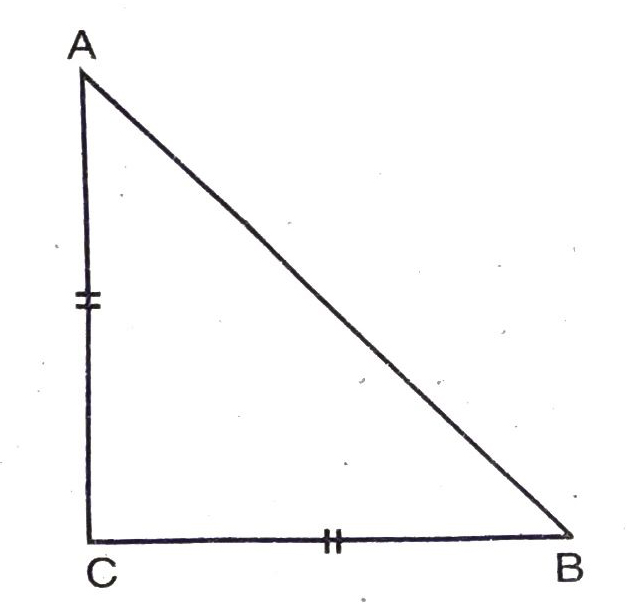
Proof: AB² = 2AC² (given)
AB² = AC² + AC²
AB² = AC² + BC² [AC = BC]
∴ By Converse of Pythagoras Theorem, AABC is right angled triangle.
Q. 6. ABC is an equilateral triangle of side 2a. Find each of its altitudes.
Solution. ΔABC is equilateral triangle with each side 2a
AD ⊥ BC
AB = AC = BC = 2a
ΔADB ≅ ΔADC [By RHS Cong.]
∴ BD = DC = a
In right angled Δ ADB
AB² = AD² + BD²
(2a)² = AD² + (a)²
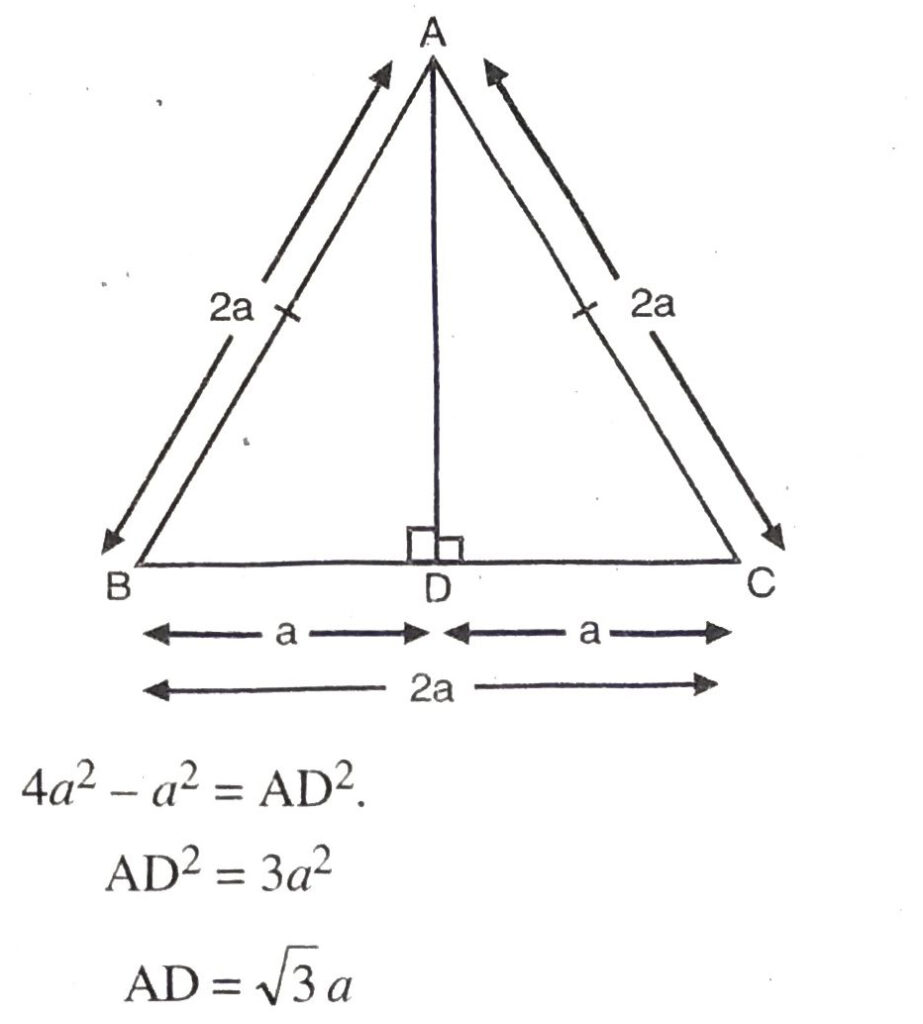
Q. 7. Prove that the sum of the squares of the sides of a rhombus is equal to the sum of the squares of its diagonals.
Solution. Given : Rhombus, diagonal AC and BD intersect each other at O.
To prove:
AB² + BC² + CD² + AD² = AC² + BD²
Proof: The diagonals of a rhombus bisect each other at right angles.
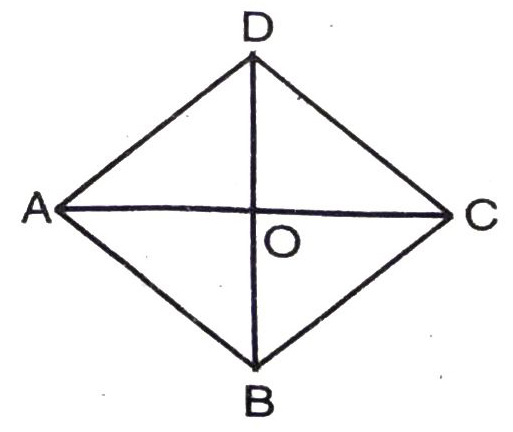
∴ AO = CO, BO = DO
∴ ∠s at O are rt. ∠s
In ΔAOB, ∠AOB = 90°
∴ AB² = AO² + BO² …(1)
[By Pythagoras Theorem]
Similarly, BC2 = CO² + BO² …(2)
CD2 = CO² + DO² …(3)
and DA² = DO²+ AO² …(4)
Adding, (1), (2), (3) and (4), we get
AB2 + BC2 + CD2 + DA2
= 2AO² + 2CO² + 2BO² + 2D0²
= 4AO² + 4BO²
[ ∵ AO = CO and BO = DO]
= (2AO)² + (2BO)² = AC² + BD².
Q. 8. In fig., O is a point in the interior of a triangle ABC, OD ⊥ BC, OE ⊥ AC and OF ⊥ AB. Show that :
(i) OA² + OB² + OC² – OD² – OE² – OF² = AF² + BD² + CE²
(ii) AF² + BD² + CE² = AE² + CD² + BF².
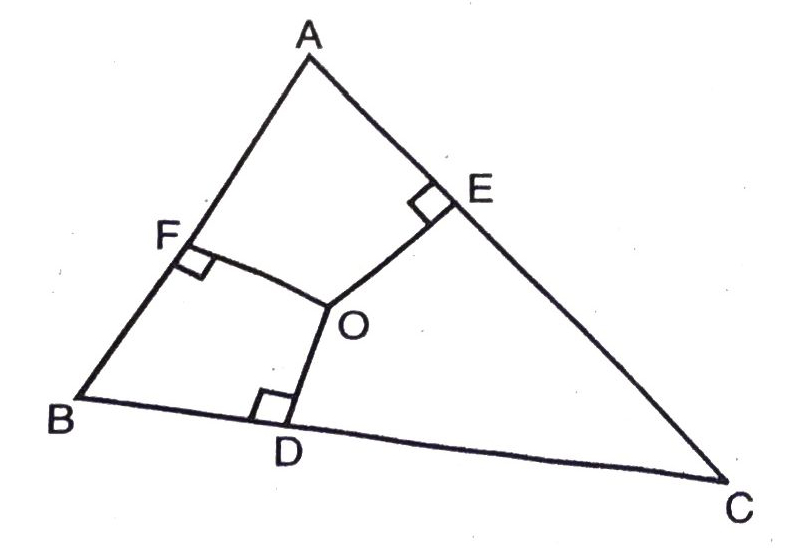
Solution. Given: A ΔABC in which OD ⊥ BC, OE ⊥ AC and OF ⊥ AB.
To prove:
(i) AF² + BD² + CE² = OA² + OB² + OC² – OD² – OE² – OF²
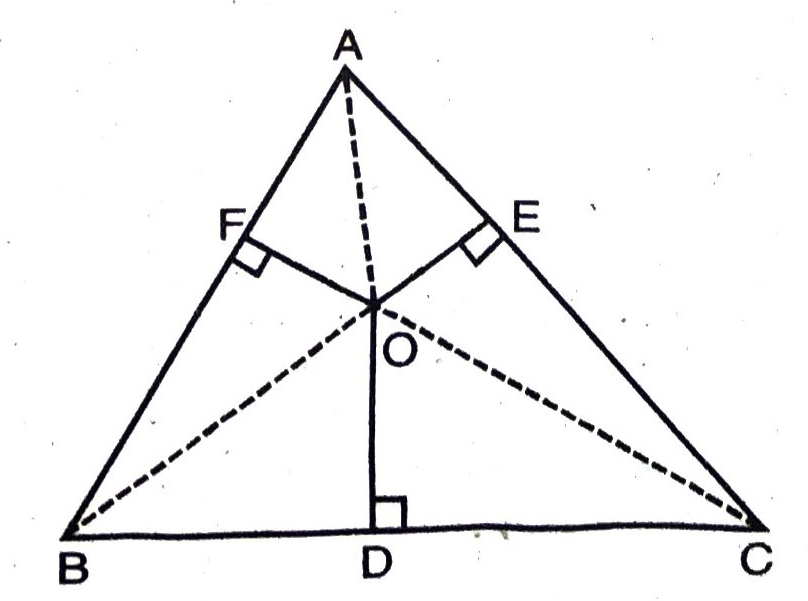
(ii) AF² + BD² + CE² = AE² + CD² + BF².
Construction: Join OB, OC and OA.
Proof : (i) In rt. ∠d ΔAFO, we have
OA² = OF² + AF² [By Pythagoras Theorem]
or AF² = OA² – OF² ….(1)
In rt. ∠d ΔBDO, we have :
OB² = BD²+ OD² [By Pythagoras Theorem]
⇒ BD² = OB² – OD² ….(2)
In rt. ∠d ΔCEO, we have :
OC² = CE² + OE² [By Pythagoras Theorem]
⇒ CE² = OC² – OE² ….(3)
∴ AF² + CD² + CE²
= OA² – OF² + OB² – OD² + OC² – OE²
[On adding (1), (2) and (3)]
= OA² + OB² + OC² – OD² – OE² – OF²
which proves part (1).
Again, AF² + BD² + CE²
= (OA² – OE²) + (OC² – OD²) + (OB² – OF²)
= AE²+ CD² + BF²
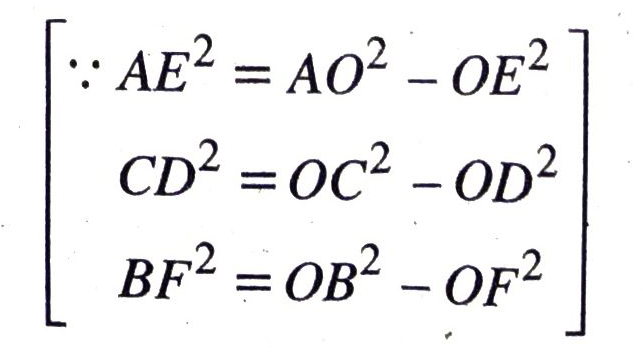
Q. 9. A ladder 10 m long reaches a window 8 m above the ground. Find the distance of the foot of the ladder from base of the wall.
Solution. Height of window from ground (AB) = 8 m
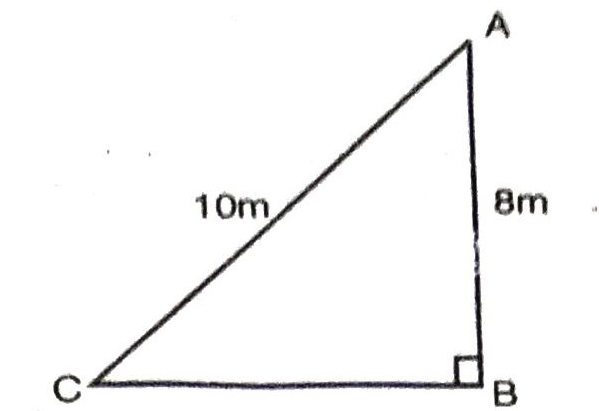
Length of ladder (AC) = 10 m
Distance between foot of ladder and foot of wall (BC) = ?
In ΔABC,
AB² + BC² = AC²
[By Pythagoras Theorem]
(8)² + (BC)² = (10)²
64 + BC² = 100
BC² = 100 – 64
BC = √36
BC = 6 cm.
∴ Distance between foot of ladder and foot of wall = 6 cm.
Q. 10. A guy wire attached to a vertical pole of height 18 m is 24 m long and has a stake attached to the other end. How far from the base of the pole should the stake be driven so that the wire will be taut?
Solution. Let AB is height of pole (AB) = 18 m
AC is length of wire = 24 m
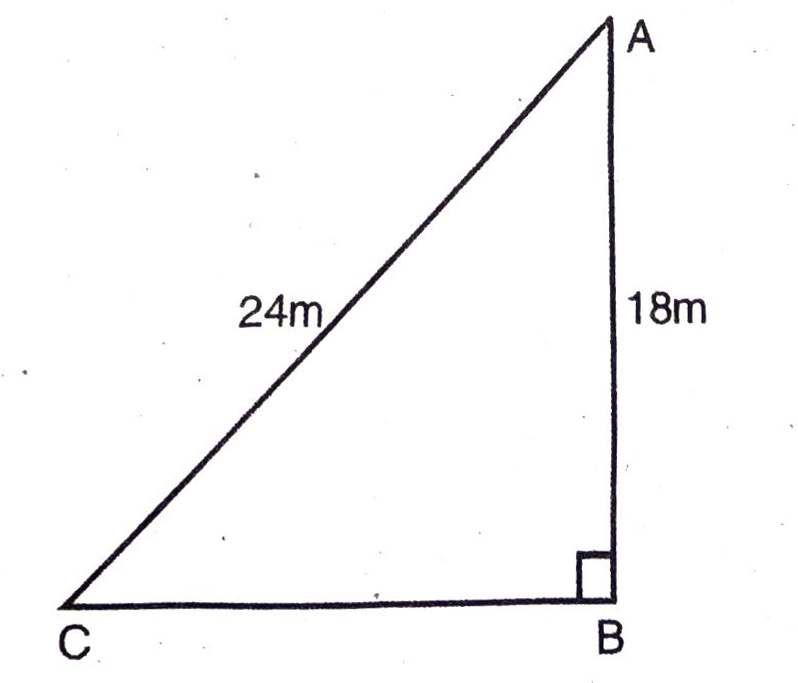
C is position of stake AB at ground level.
In right angle triangle ABC,
AB² + BC² = AC²
(By Pythagoras Theorem]
(18)² + (BC)² = (24)²
324 + (BC)² = 576
BC² = 576 – 324
BC = √252
BC = 6√7 m
Q. 11. An aeroplane leaves an airport and flies due north at a speed of 1000 km per hour. At the same time, another aeroplane leaves the same airport and flies due west at a speed of 1200 km per hour. How far apart will be the two planes after 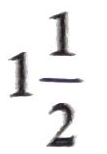 hours ?
hours ?
Solution. Speed of first aeroplane = 1000 km/hr.
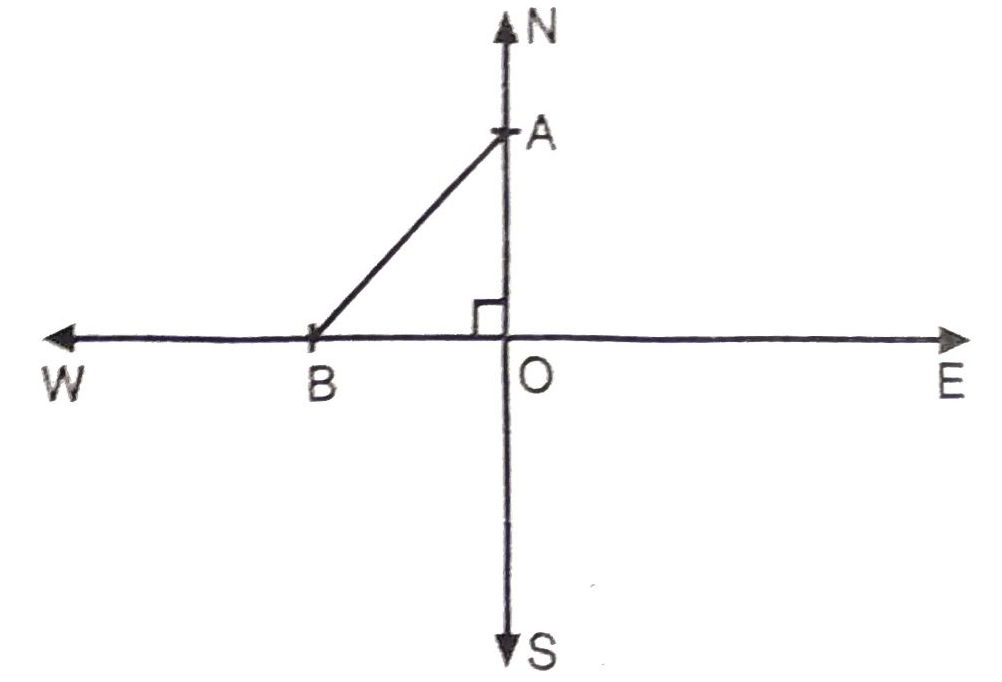
Distance covered by first aeroplane due north in  hours = 1000 x 3/2 OA = 1500 km
hours = 1000 x 3/2 OA = 1500 km
Speed of second aeroplane = 1200 km/hr.
Distance covered by second aeroplane in  hours = 1200 x 3/2 OB = 1800 km.
hours = 1200 x 3/2 OB = 1800 km.
In right angle ΔAOB
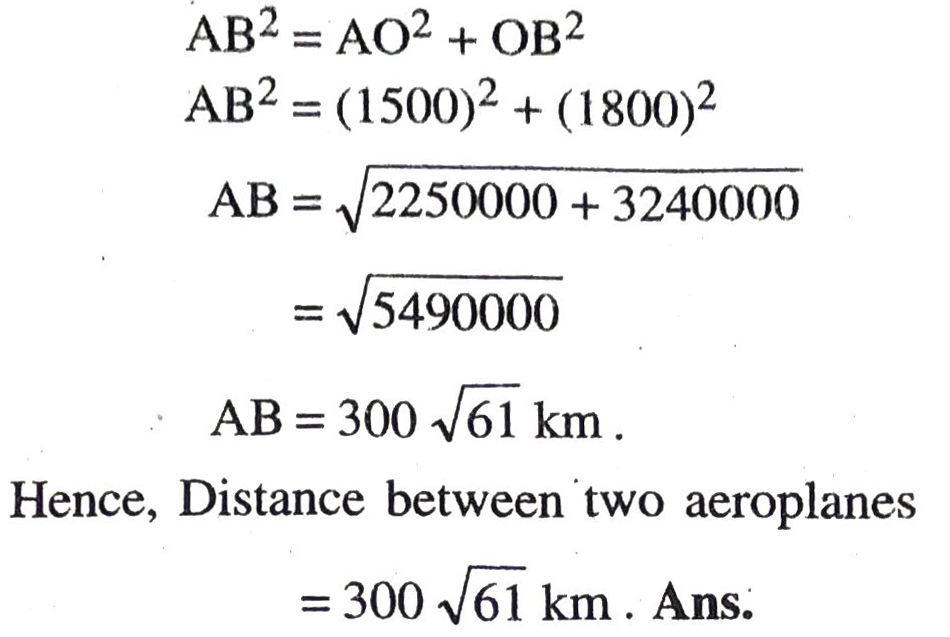
Q. 12. Two poles of heights 6 m and 11 m stand on a plane ground. If the distance between the feet of the poles is 12 m, find the distance between their tops.
Solution. Height of pole AB = 11 m
Height of pole (CD) = 6 m
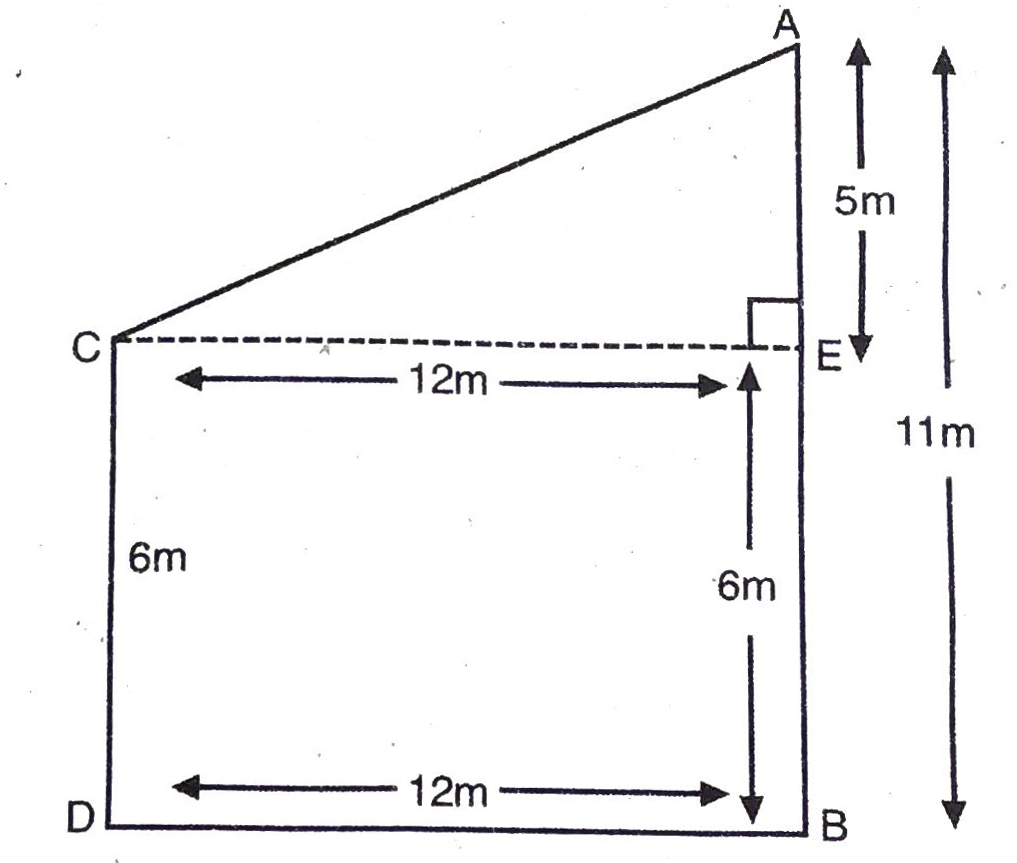
Distance between foot of pole = 12m
from C draw CE ⊥ AB.
BE = DC = 6 m
AE = AB – BE
= (11-6) m = 5m.
In rt. ∠d ΔAEC,
AC² = AE² + EC²
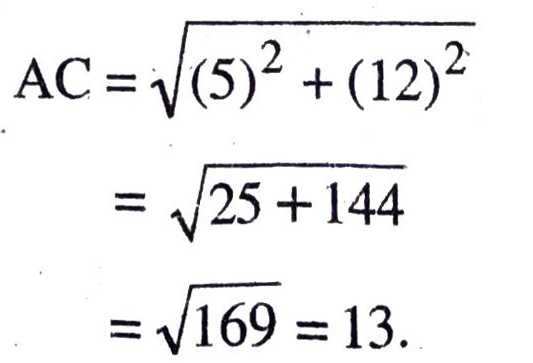
Hence, Distance between their top = 13 m. Ans.
Q. 13. D and E are points on the sides CA and CB respectively of a triangle ABC right angled at C.
Prove that AE² + BD² = AB² + DE².
Solution. Given: ΔABC is right angled at C, D and E are mid point of CA and BC respectively.
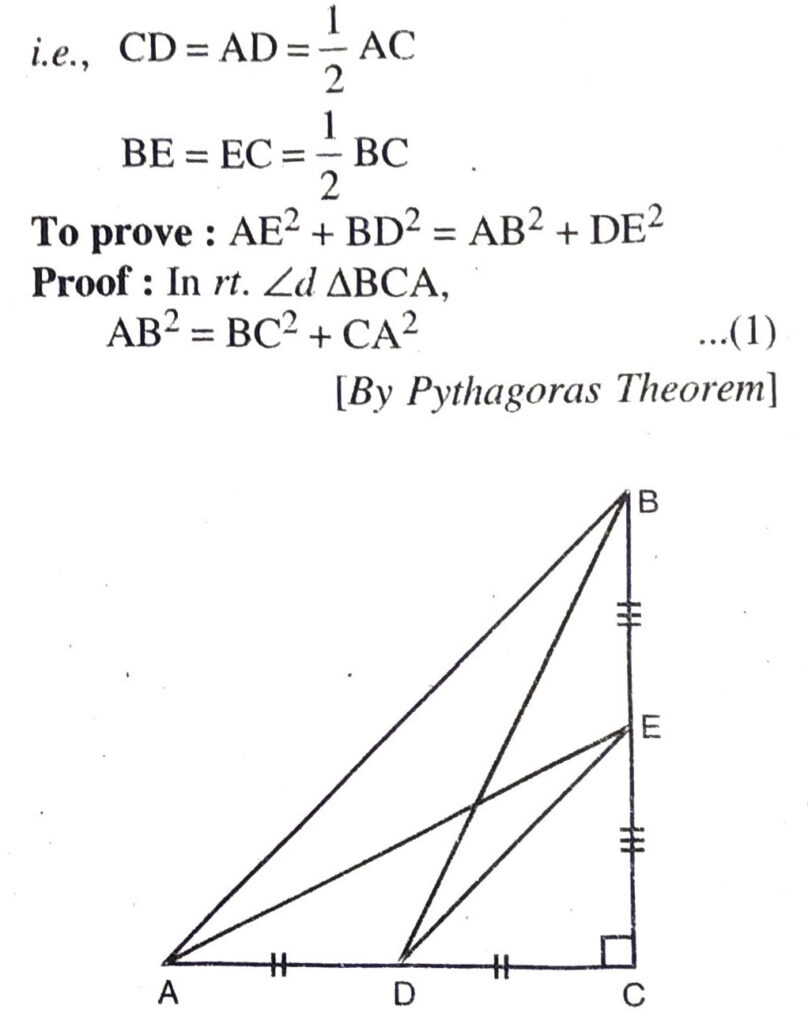
In rt. ∠d ΔECD,
DE² = EC² + DC² ..(2)
[By Pythagoras Theorem]
In right angled triangle ΔACE,
AE² = AC² + CE² …(3)
In right angled triangle ΔBCD
BD² = BC²+ CD² …(4)
Adding (3) and (4),
AE² + BD² = AC² + CE² +BC² + CD²
= [AC² + CB²] + [CE² + DC²]
= AB² + DE² [From (3) and (4)]
Hence AE² + BD² = AB² + DE².
which is the required result.
Q. 14. The perpendicular from A on side BC of a AABC intersects BC at D such that DB = 3 CD.
Prove that 2AB² = 2AC² + BC².
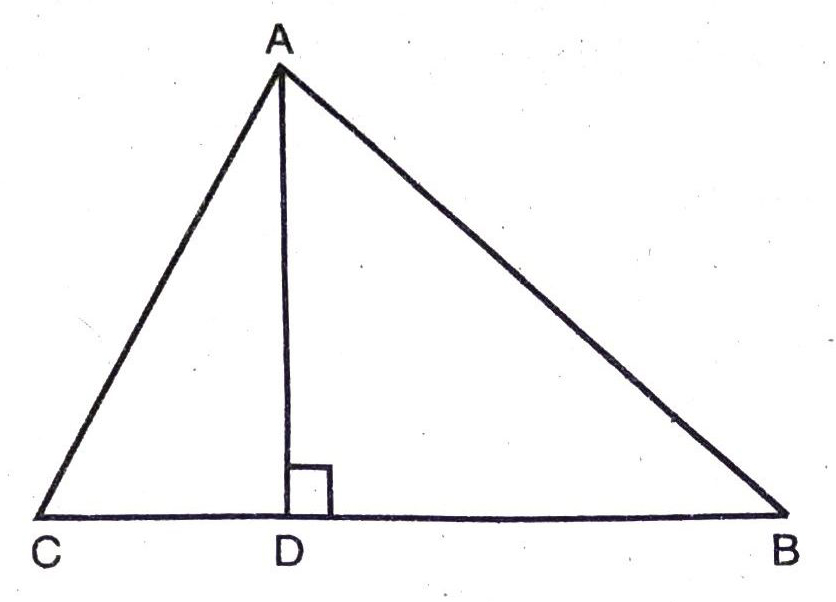
Solution.
Given : ΔABC, AD ⊥ BC
BD = 3CD.
To prove: 2AB² = 2AC² + BC².
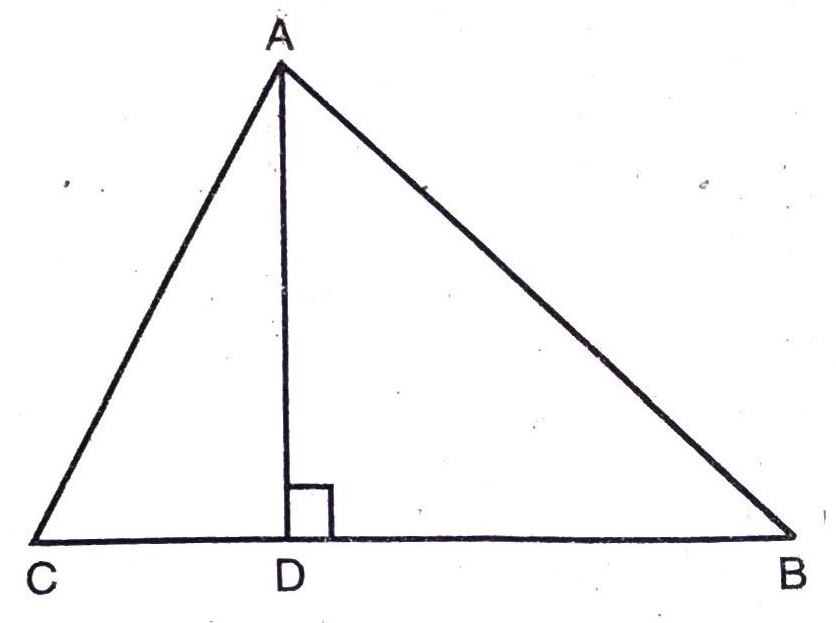
Proof: In rt. ∠d triangles ADB and ADC, we have
AB² = AD² + BD²;
AC² = AD² + DC²
[By Pythagoras Theorem]
∴ AB² – AC² = BD² – DC²
= 9CD² – CD²;
[∵ BD = 3CD]
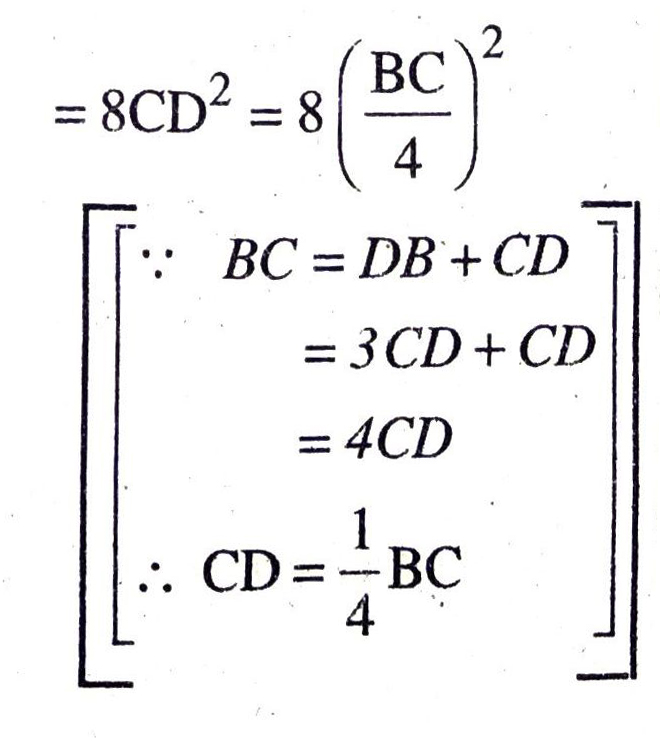
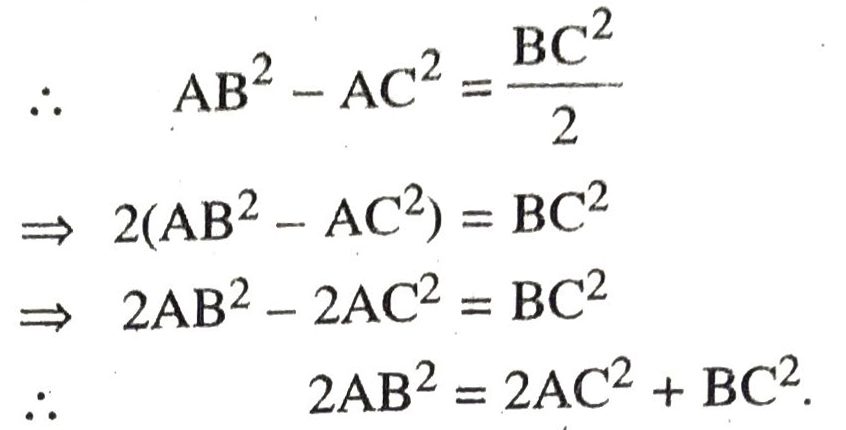
Which is the required result.
Q. 15. In an equilateral triangle ABC, D is a point on side BC such that BD: = 1/3 BC.
Prove that 9AD² = 7AB².
Solution.
Given : Equilateral triangle ABC, D is a point on side BC such that BD = 1/3 BC.
To prove: 9AD² = 7AB².
Construction : AB ⊥ BC.
Proof: ΔΑΜΒ ≅ ΔΑΜC
[By R.H.S. Rule since AM = AM and AB = AC]
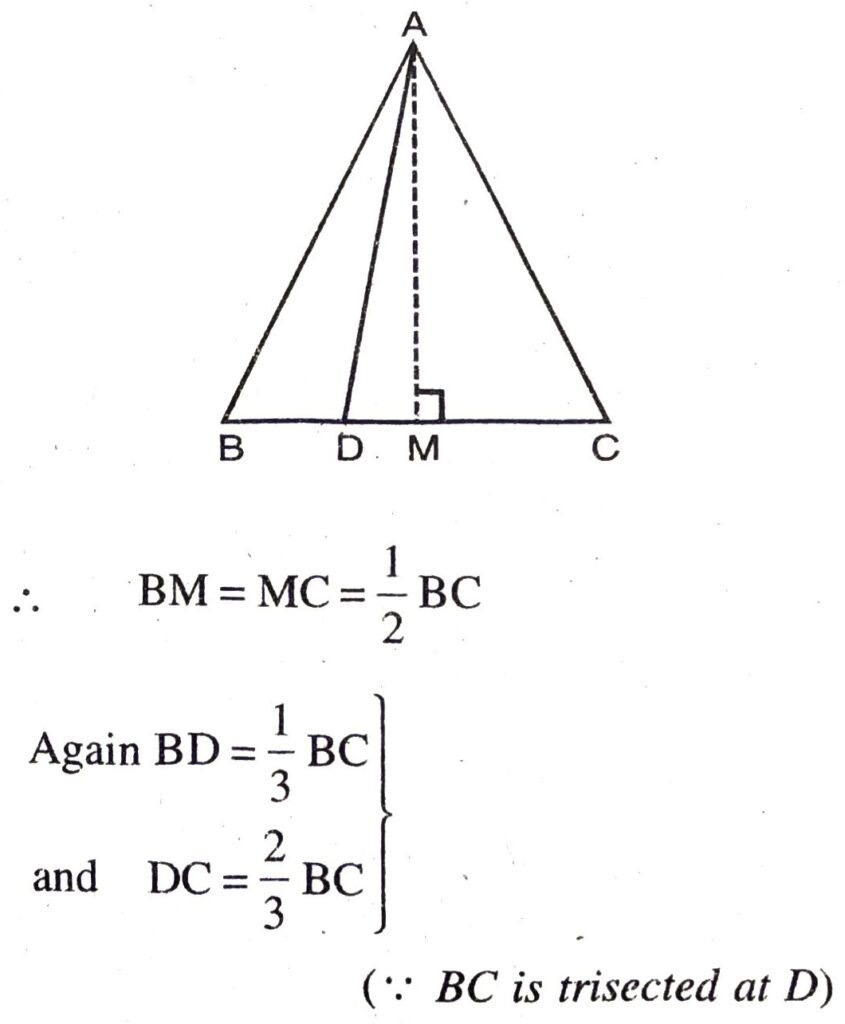
Now in ΔADC, ∠C is acute
∴ AD² = AC² + DC² – 2DC × MC
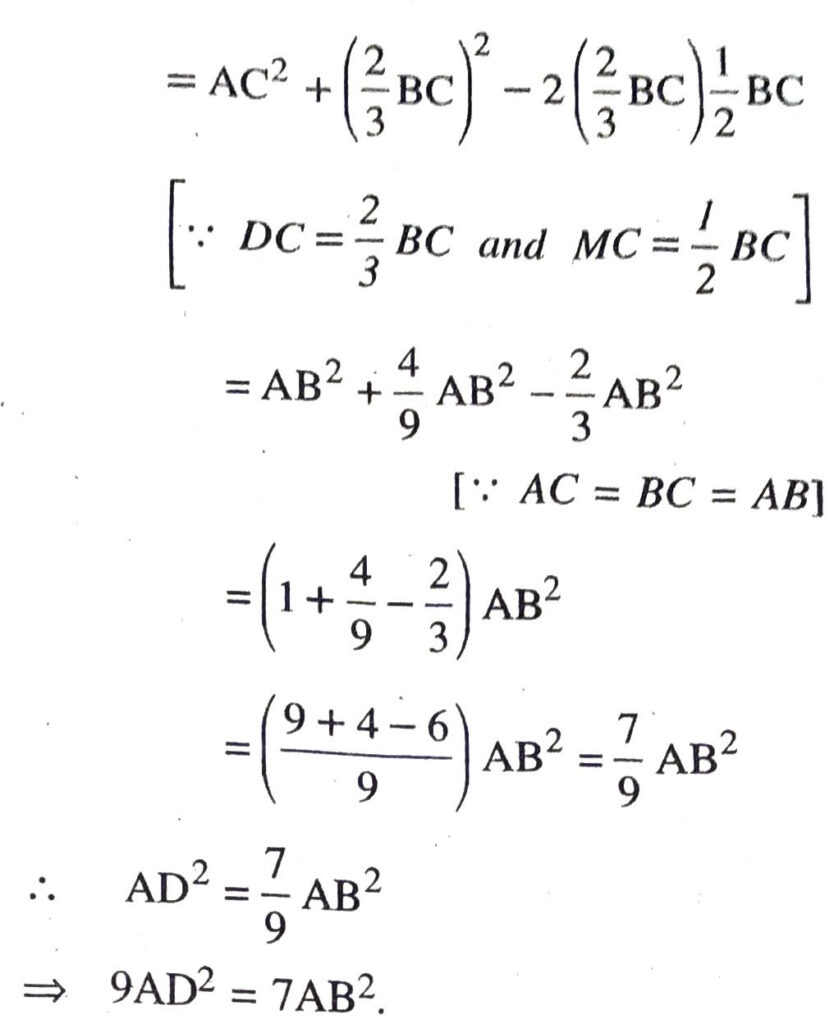
Q. 16. In an equilateral triangle, prove that three times the square of one side is equal to four times the square of one of its altitudes.
Solution.
Given : ΔABC is equilateral Δ in which
AB = BC = AC
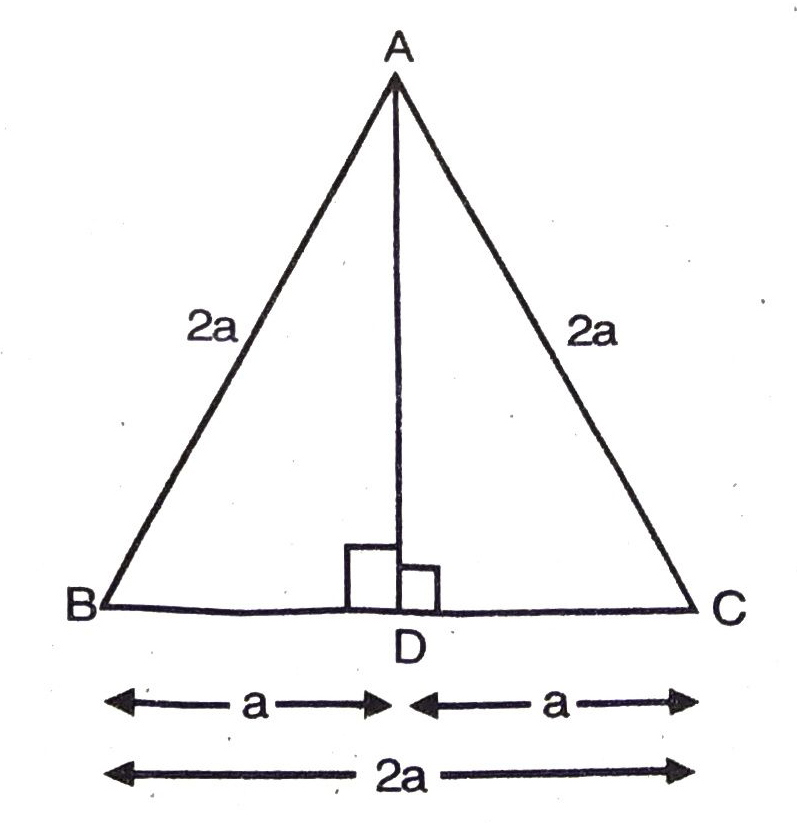
AD ⊥ DC
To prove: AB² = 4AD²
Proof: In ΔABC,
Let AB = BC = AC = 2a
AD ⊥ BC
∴ BD = DC
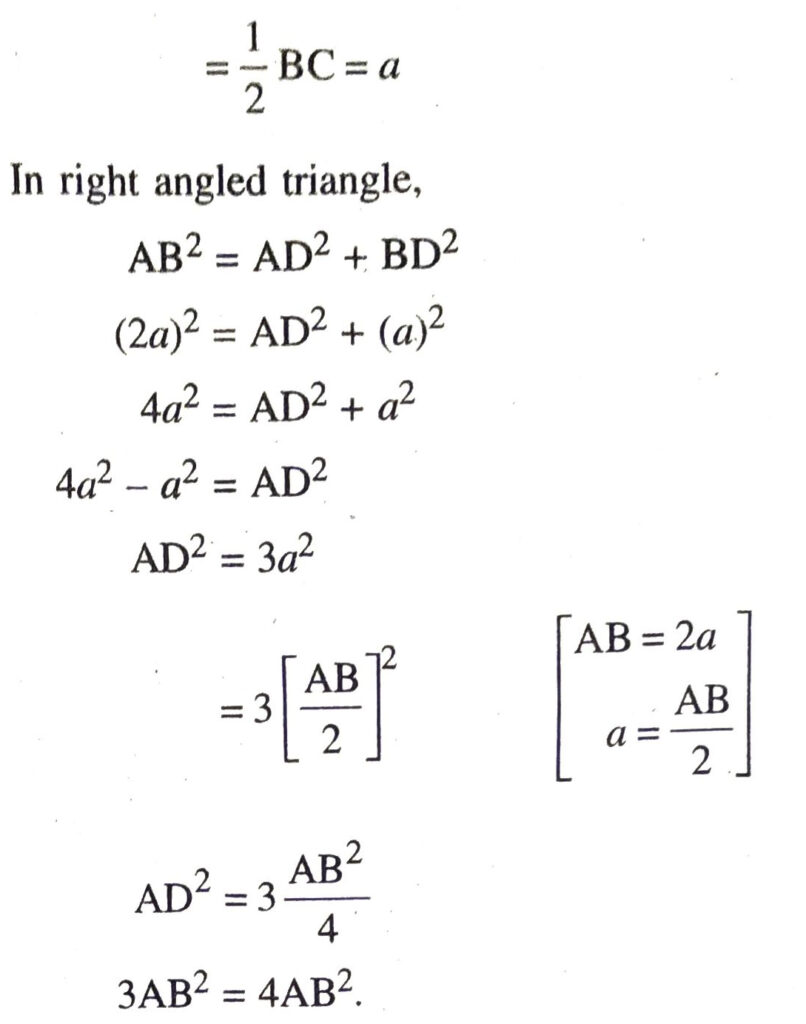
Which is the required result.
Tick the correct answer and justify :
Q. 17. In ΔABC, AB=6√3 cm, AC = 12 cm and BC = 6 cm. The angles of B are respectively:
(A) 120°
(B) 60°
(C) 90°
(D) 45°.
Solution. AC = 12 cm
AB = 6√3 cm
BC = 6 cm
AC² = (12)² = 144 cm
AB² + BC² = (6√3)² + (6)²
= 108 + 36
AB² + BC² = 144
∴ AB² + BC² = AC²
Hence by converse of pythagoras theorem ΔABC is right angled triangle right angle at B
∴ ∠B = 90°
∴ correct option is (C).
TEXT BOOK EXERCISE 6.6
(OPTIONAL)
Q. 1. In figure, PS is bisector of ∠QPR of ΔPQR. Prove that 
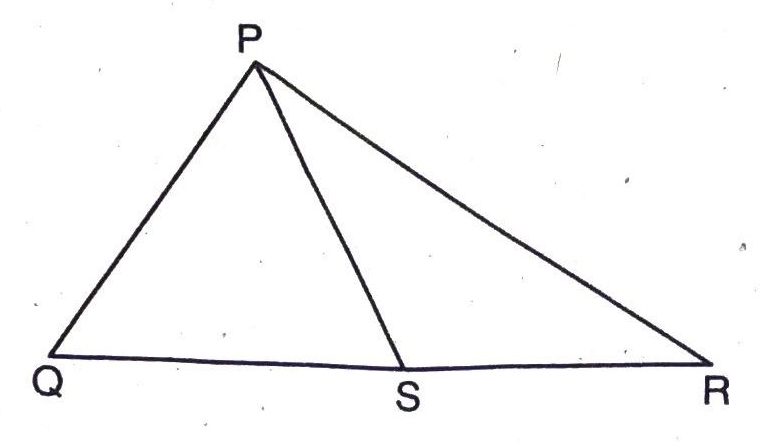
Solution.
Given : ΔPQR, PS is bisector of ∠QPR
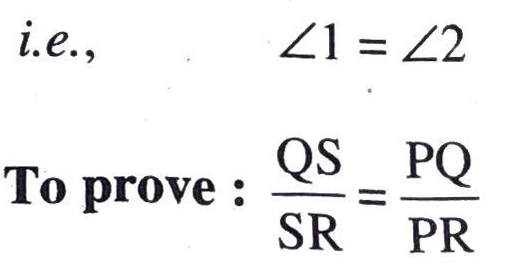
Construction: Through R draw a line parallel to PS to meet QP produced at T.
Proof: In ΔQRT,
PS || TR
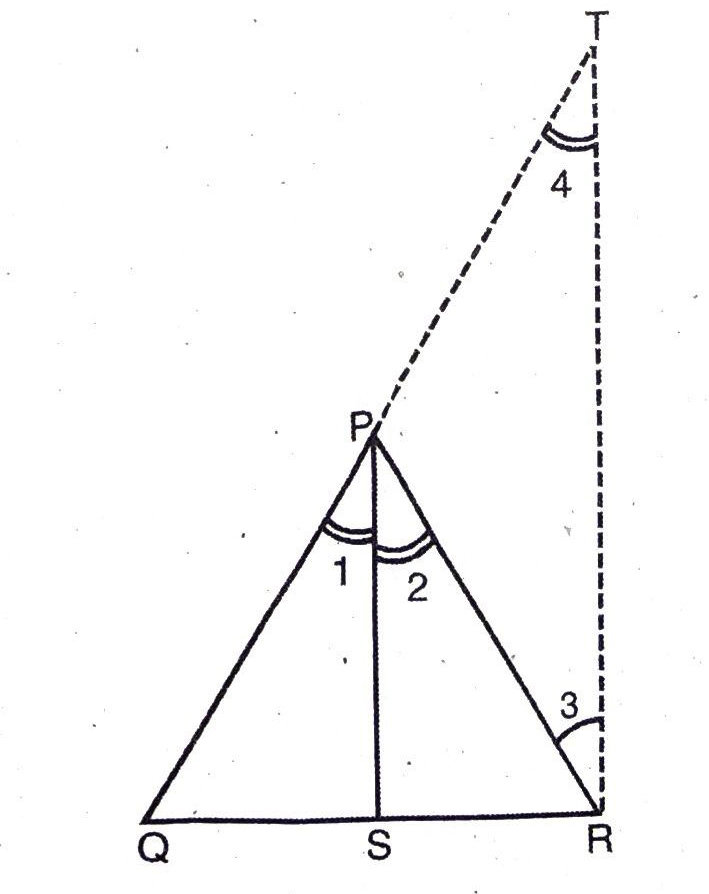
∠2 = ∠3 (Alternate angle)
∠1 = ∠4 (Corresponding angle)
but ∠1 = ∠2 (given)
∴ ∠3 = ∠4
In ΔPRT,
∠3 = ∠4 (Proved)
PT = PR
[Equal side have equal angle opposite to it]
In ΔQRT,
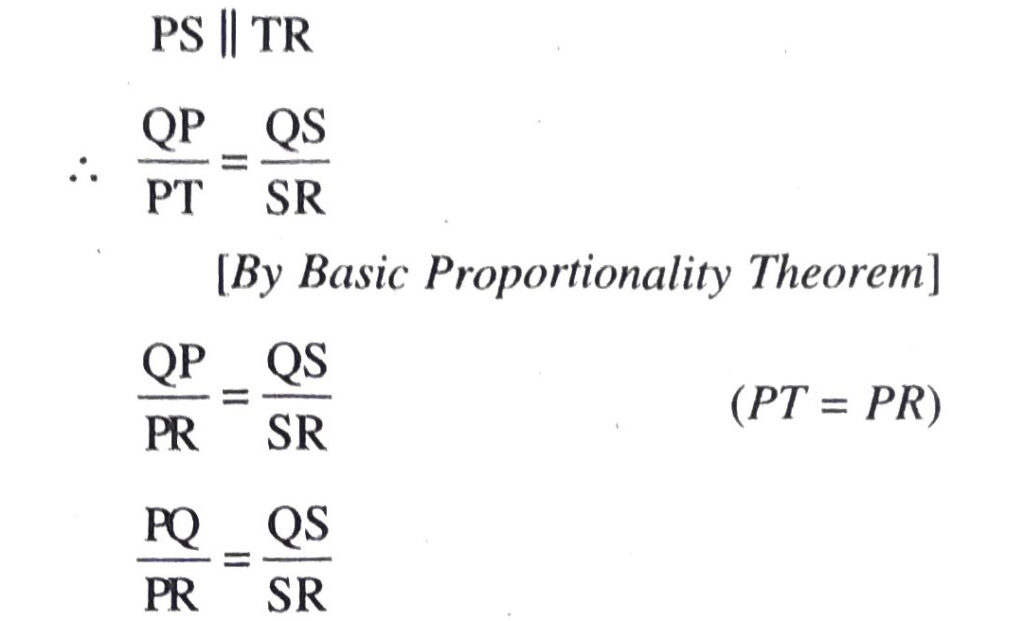
Which is the required result.
Q. 2. In the given fig., D is a point on hypotenuse AC of ΔABC, such that BD ⊥ AC, DM ⊥ BC, DN ⊥ AB, prove that :
(i) DM² = DN.MC
(ii) DN² = DM.AN.
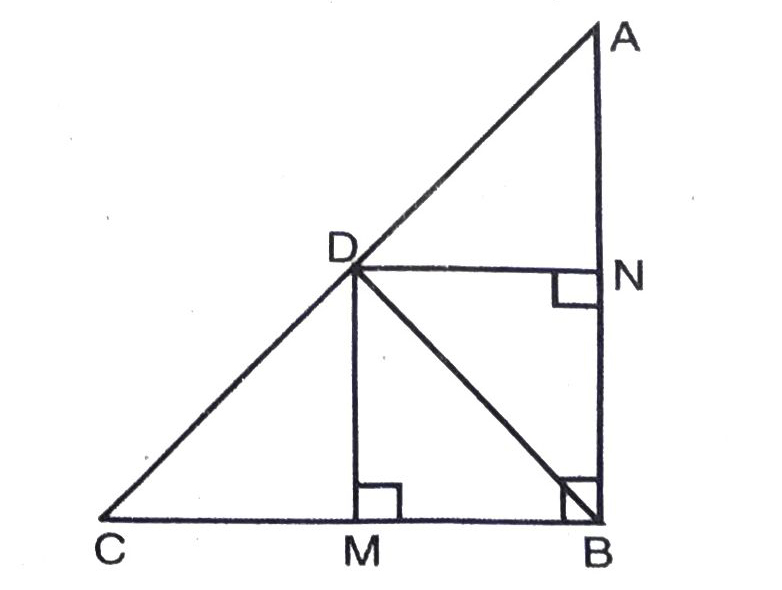
Solution.
Given: ΔABC, DM ⊥ BC
DN ⊥ AB
To prove : DM² = DN.AC
DN² = DM.AM.
Proof: BD ⊥ AC (Given)
⇒ ∠BDC = 90°
⇒ ∠BDM + ∠MDC = 90° …(1)
In ΔDMC,
∠DMC = 90°
[ ∵ DM ⊥ BC (Given)]
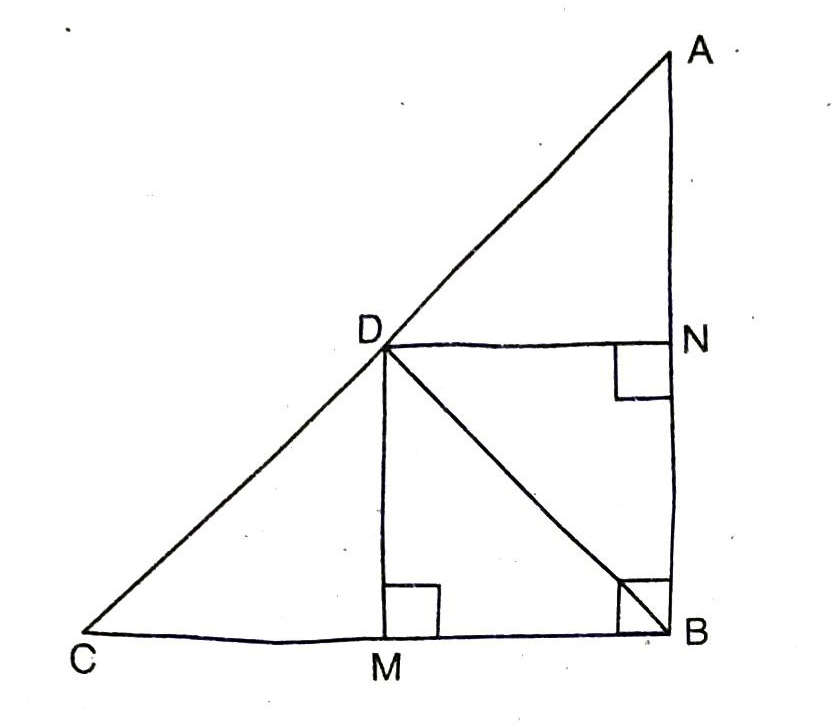
⇒ ∠C + ∠MDC = 90° ….(2)
From (1) and (2),
∠BDM + ∠MDC = ∠C + ∠MDC
⇒ ∠BDM = ∠C
[Cancelling ZMDC from both sides ]
Now in ΔBMD and ΔMDC,
∠BDM = ∠C [Proved]
∠BMD = ∠DMC [Each 90° ]
∴ ΔBMD ∼ ΔMDC
[By AA criterion of similarity]
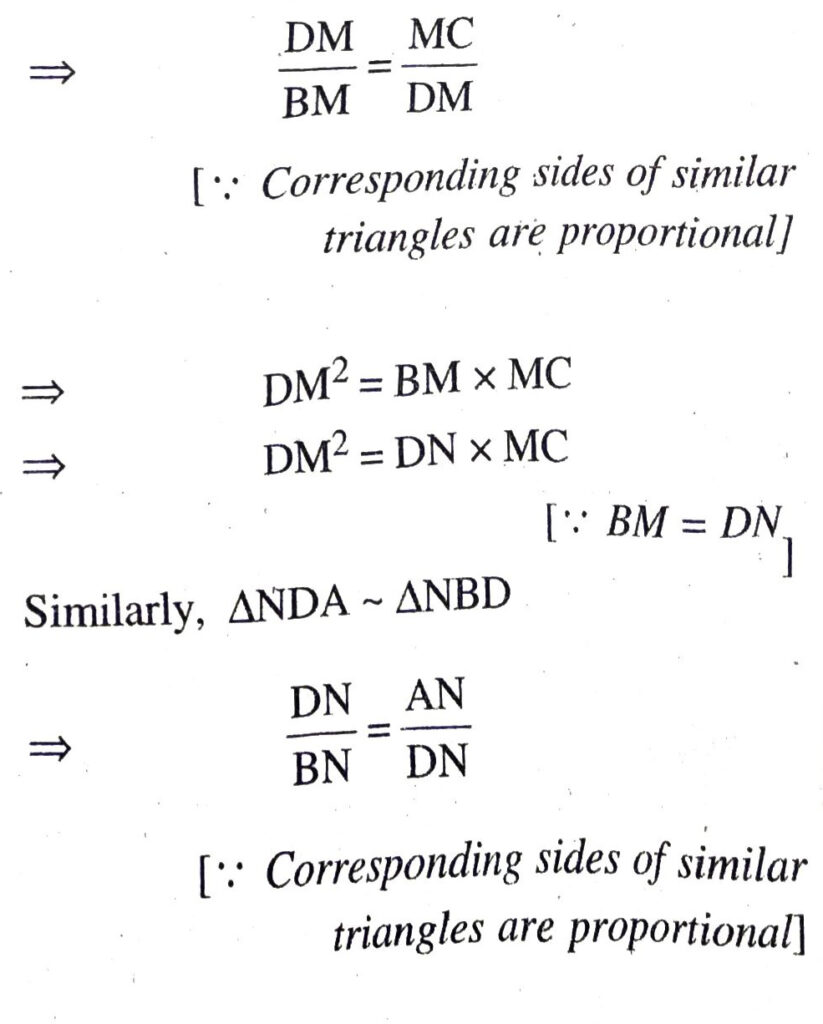
⇒ DN² = BN × AN
⇒ DN² = DM × AN
Hence proved.
Q. 3. In fig., ABC is triangle in which ∠ABC > 90° and AD ⊥ CB produced, prove that AC² = AB² + BC2 + 2BC.BD.
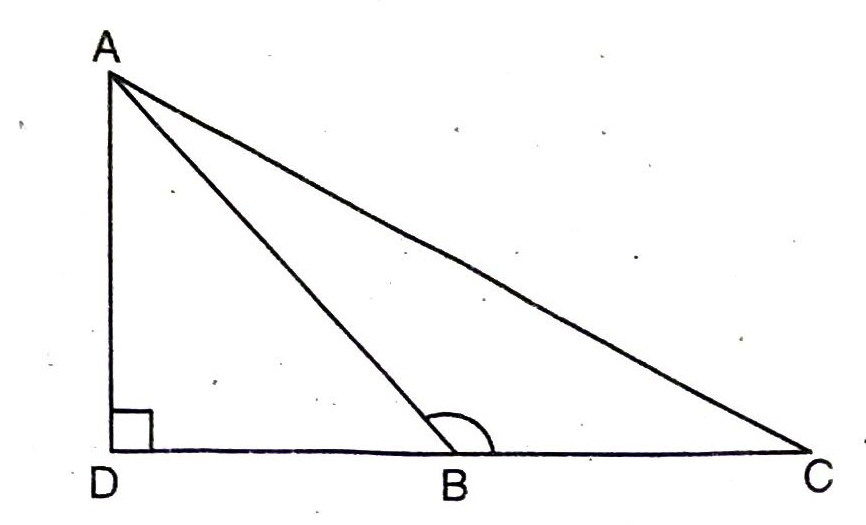
Solution.
Given : ΔABC, AD ⊥ BC when produced, ∠ABC > 90°.
To prove: AC² = AB² + BC² + 2BC.BD.
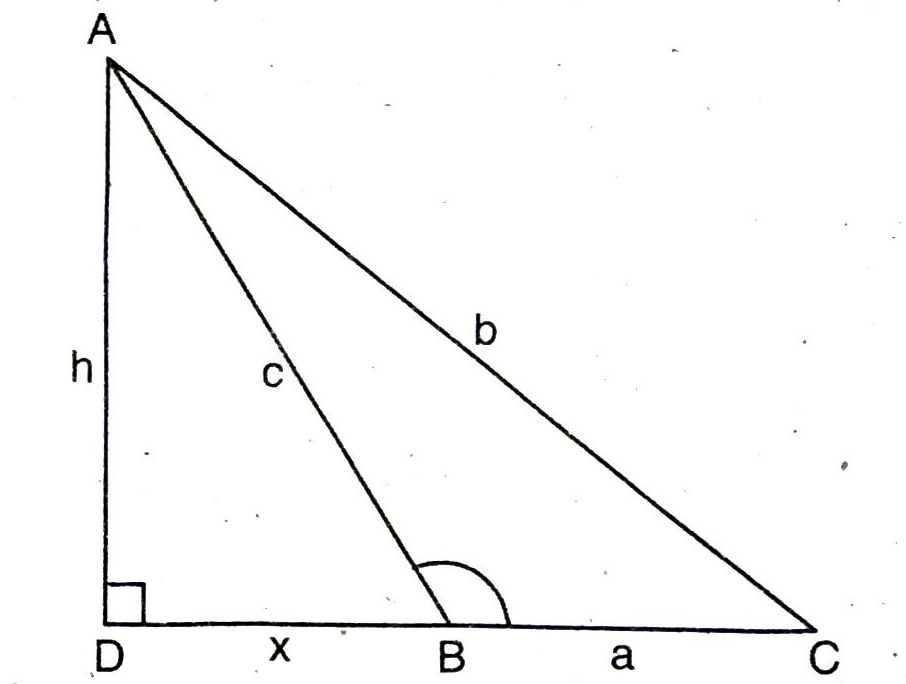
Proof : Let BC = a,
CA = b,
AB = c,
AD = h
and BD = x.
In right-angled ΔADB,
Using Pythagoras Theorem,
AB² = BD² + AD²
i.e., c² = x² + h² …(1)
Again, in right-angled ΔADC,
AC² = CD² + AD²
i.e., b² = (a + x)² + h²
b² = a² + 2ax + x² + h²
= a² + 2ax + c²;
[Using (1)]
b² = a² + c² + 2ax
Hence, AC² = AB² + BC² + 2BC.CD.
Q. 4. In fig., ABC is a triangle in which ∠ABC < 90°, AD ⊥ BC, prove that
AC² = AB² + BC² – 2BC.BD.
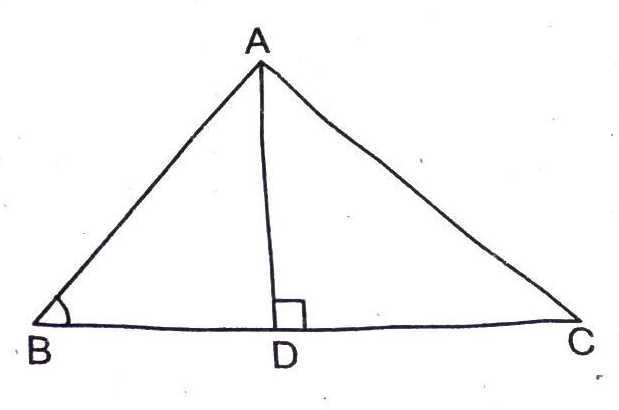
Solution.
Given : ΔABC, ∠ABC < 90°
AD ⊥ BC.
To prove: AC² = AB² + BC² – 2BC.BD.
Proof: ADC is right-angled Δ at D
AC² = CD² + DA² …(1)
(Pythagoras Theorem)
Also, ADB is right angled Δ at D
AB² = AD² + DB² …(2)
From (1), we get :
AC² = AD² + (CB-BD)²
= AD² + CB² + BD² – 2CB × BD
or AC² = (BD2 + AD²) + CB² – 2CB × BD
AC² = AB² + BC² – 2BC × BD.
[Using (2)]
Q. 5. In fig., AD is a median of a triangle ABC and AM ⊥ BC. Prove that:
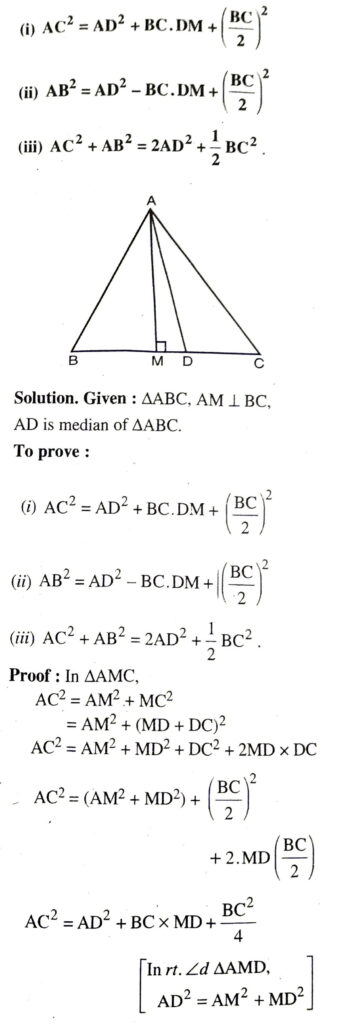
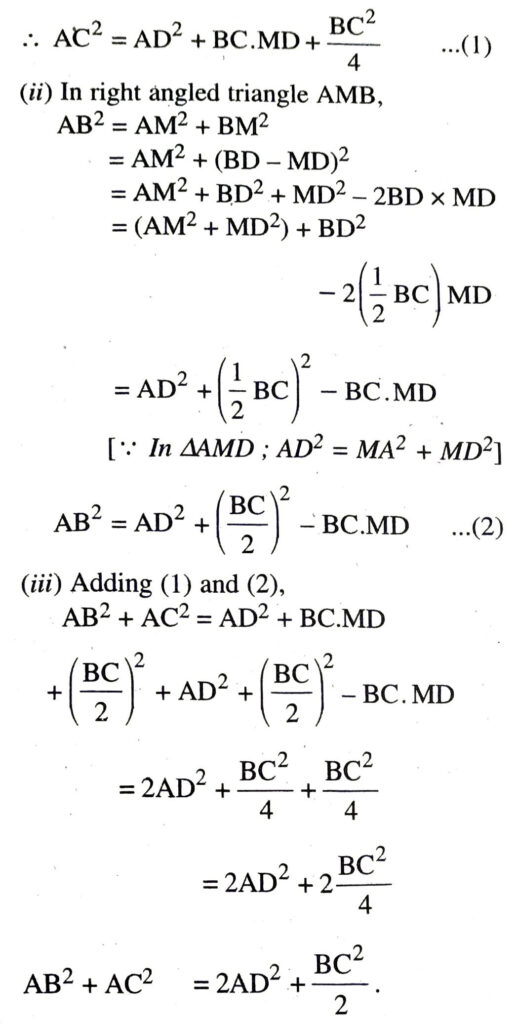
Which is the required result.
Q. 6. Prove that sum of squares of the diagonals of a parallelogram is equal to sum of squares of its sides.
Solution.
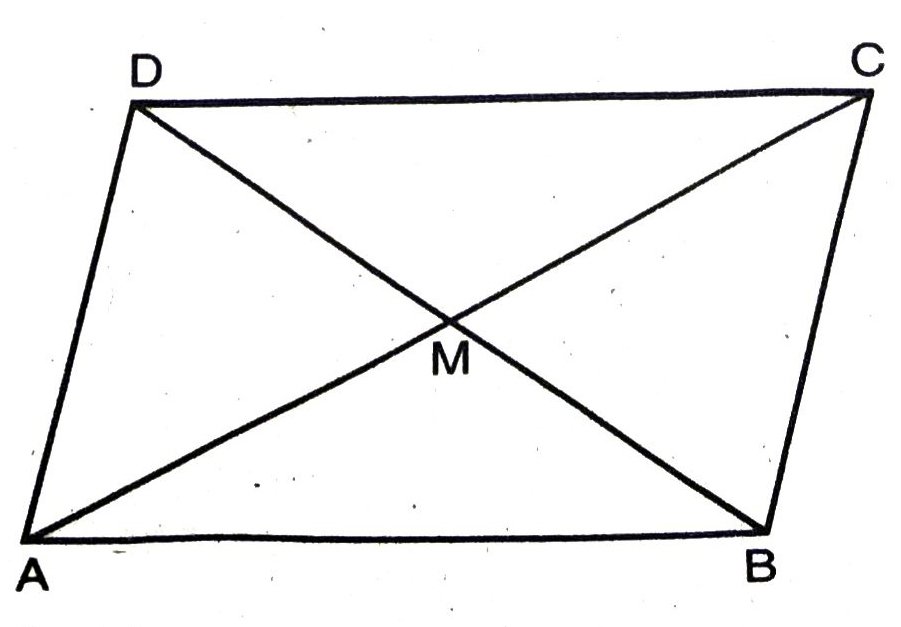
Given : Let ABCD be a parallelogram in which diagonals AC and BD intersect at point M.
To prove: AB² + BC² + CD² + DA² = AB² + BC²
Solution. Proof : Diagonals of a parallelogram bisect each other.
∴ In || gm ABCD,
Diagonal BD and AC bisect each other.
Or MB and MD are medians of ΔABC and ΔADC respectively.
We know that, if AD is a medians of ΔABC,
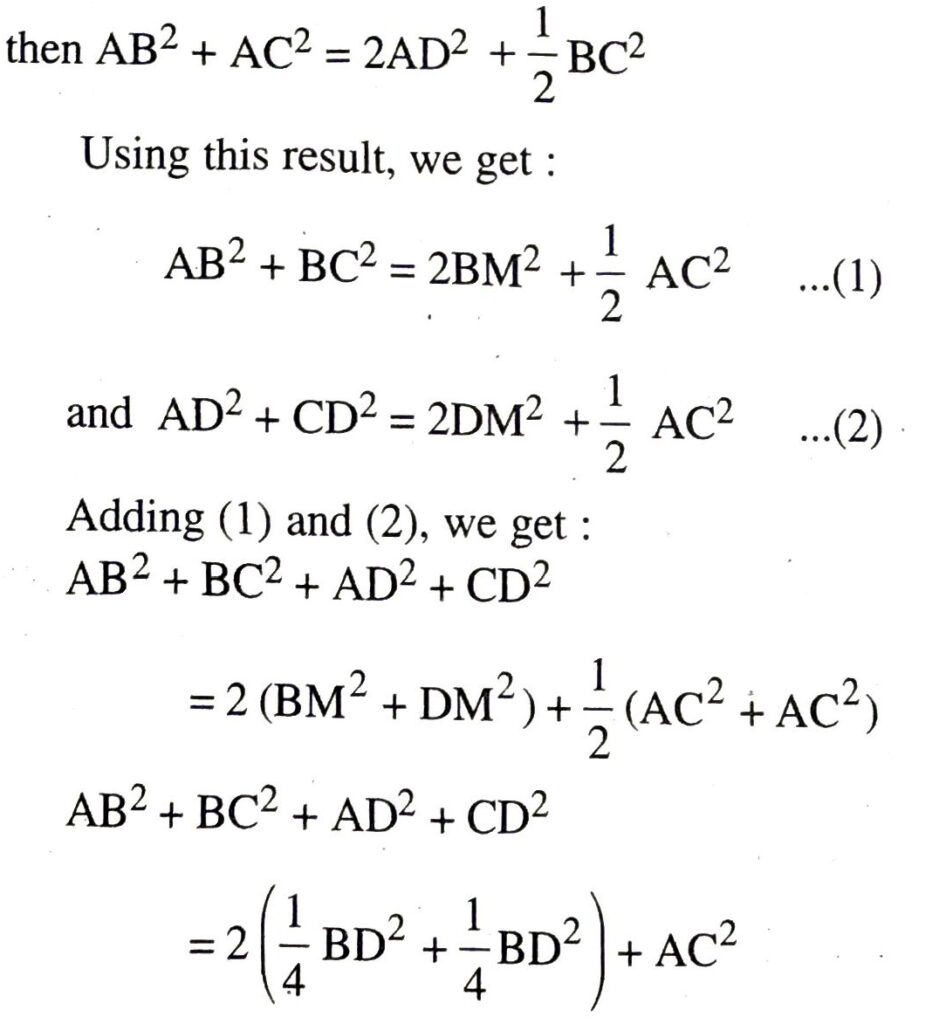
AB² + BC² + AD² + CD² = BD² + AC²
Hence, sum of the squares of the diagonals of a parallelogram is equal to the sum of the squares of its sides.
Q. 7. In fig., two chords AB and CD intersect each other at the point P
prove that:
(i) ΔAPC ~ ΔDPB
(ii) AP.PB = CP.DP.
Solution.
Given : Circle, AB and CD are two chords intersects each other at P.
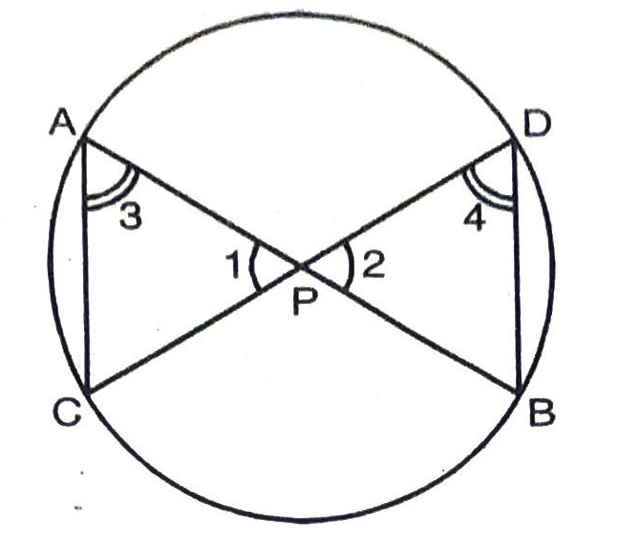
To prove: (i) ΔAPC ∼ ΔDPB
(ii) AP.PB = CP.DP.
Proof: (i) In ΔAPC and ΔDPB,
∠1 = ∠2 (Vertically opposite angle)
∠3 = ∠4 (angle on same segment)
∴ ΔAPC ∼ ΔDPB
[AA similarity criterion]
(ii) ΔAPC ∼ ΔDPB
(Proved above)
(If two triangles are similar corresponding sides are proportional)
AP.PB = PC.DP
Which is the required result.
Q. 8. In fig., two chords AB and CD of a circle intersect each other at point P (when produced) outside the circle prove :
(i) ΔPAC ∼ ΔPDB
(ii) PA.PB = PC.PD.
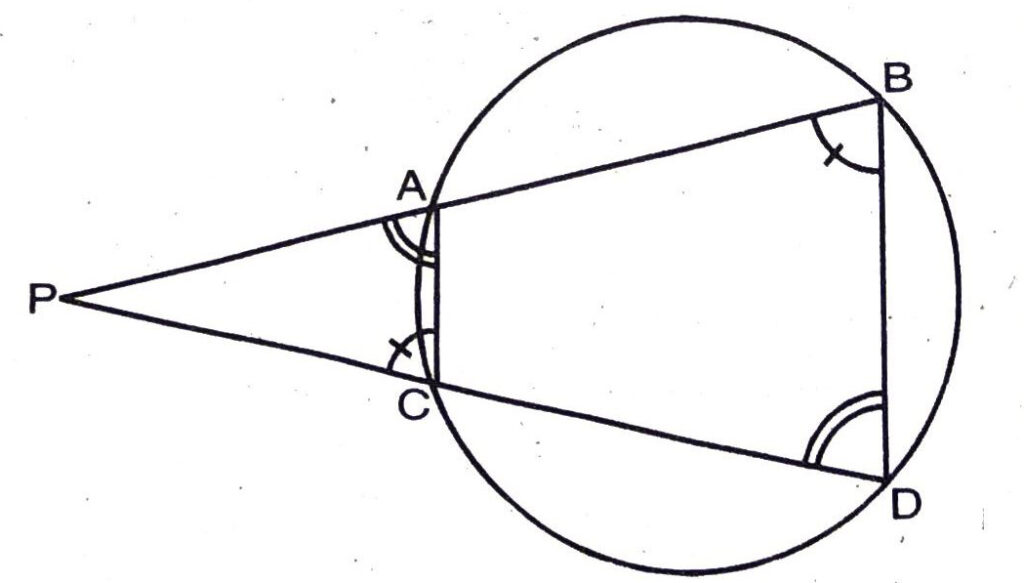
Solution.
Given : AB and CD are two chord of circle intersects each other at P (when produced)
To prove: (i) ΔPAC ~ ΔPDB
(ii) PA.PB = PC.PD.
Proof: (i) In ΔPAC and ΔPDB,
∠P = ∠P (Common)
∠PAC = ∠PDB
(Exterior angle of cyclic quadrilateral is equal to interior opposite angle)
∴ ΔPAC~ ΔPDB
[AA similarity criterion]
(iii) ΔPAB ~ ΔPDB
[If two triangle are similar corresponding sides are proportional]
PA × PB = PC × PD.
Q. 9. In fig., D is a point on side BC of ΔABC such that 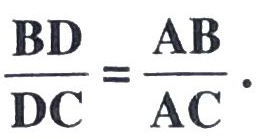
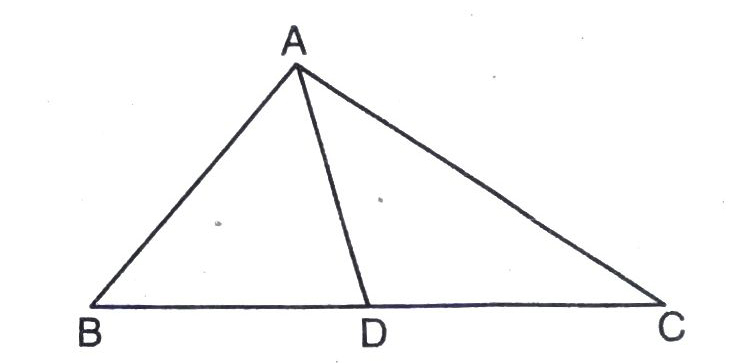
Prove that: AD is bisector of ∠BAC.
Solution.
Given: A ΔABC, D is a point on BC such that
To prove: AD bisects ∠BAC
i.e., ∠1 = ∠2
Construction : Through C draw CE || DA meeting BA produced at E.
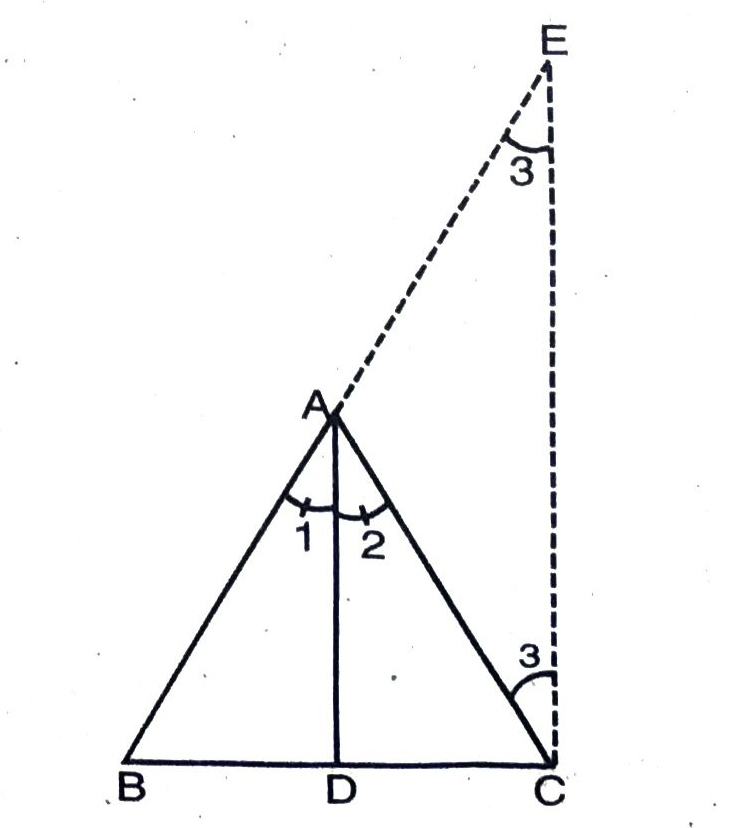
Proof: In ΔBCE, we have :
AD || CE …(const.)
So, by Basic Proportionality Theorem,
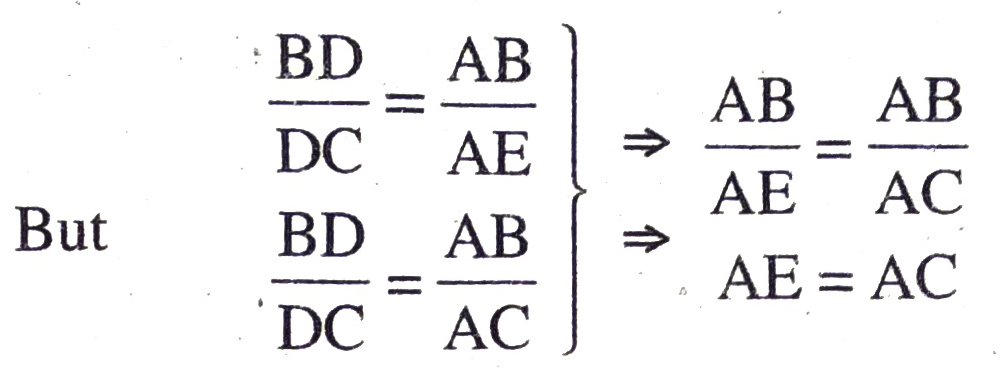
In ΔACE, we have:
AE = AC
⇒ ∠3 = ∠4
…. (∠s opp. to equal; sides)
Since CE || DA and AC cuts them, then :
∠2 = ∠4 …(alt. ∠s)
Also CE || DA and BAE cuts them, then :
∠1 = ∠3 …(Corr. ∠s)
Thus we have :
∠3 = ∠4
⇒ ∠4 = ∠1
∠3 = ∠1
But ∠4 = ∠2
⇒ ∠1 = ∠2.
Hence AD bisects ∠BAC.
Q. 10. Nazima is fly fishing in a stream. The tip of her fishing rod is 1.8 m above the surface of the water and the fly at the end of the string rests on the water 3.6 m away and 2.4 m from a point directly under the tip of the rod. Assuming that her string (from the tip of her rod to the fly) is taut, how much string does she have out? If she pulls in the string at the rate of 5 cm per second, what will the horizontal distance of the fly from her after 12 seconds ?

Solution. A right angled triangle, ABC, in which,
AB = 1.8 cm,
BC = 2.4 cm,
∠B = 90°
By Pythagoras Theorem,
AC2 = AB2 + BC2
AC2 = (1.8)2 + (2.4)2
AC2 = 3.24 + 5.76 = 9
AC2 = (3)2
AC = 3 cm
Now, when Nazima pulls in the string at the rate of 5 cm/sec; then the length of the string decrease = 5 x 12 = 60 cm = 0.6 m in 12 seconds.
Let after 12 seconds, position of the fly will be at D.
∴ AD = AC-distance covered in 12 seconds
AD = (3-0.6) m
AD = 2.4 m
Also, in right angled ΔABD,
Using Pythagoras Theorem,
AD² = AB² + BD²
(2.4)² = (1.8)² – (1.8)²
BD² = 5.76 – 3.24
BD² = 2.52 m
BD = 1.587 m.
∴ Horizontal distance of the fly from Nazima
= BD + 1.2 m
= (1.587 + 1.2) m
= 2.787 m
= 2.79 m
Hence, original length of string and horizontal distance of the fly from Nazima is 3m and 2.79 m Ans.
Follow on Facebook page – Click Here
Google News join in – Click Here
Read More Asia News – Click Here
Read More Sports News – Click Here
Read More Crypto News – Click Here